Template category
Employment Legal Templates
Essential templates for invoices, receipts, order forms, client agreements, and more.
Employment Legal Templates
Table of Contents
1. Essential Employment Documents Overview
1.1 Salary Increase Letter
1.2 Non-Compete Agreement
1.3 Job Description Template
1.4 Employment Termination Letter
1.5 Employment Offer Letter
1.6 Employment Contract
1.7 Employee Warning Letter
1.8 Employee Non-Solicitation Agreement
1.9 Background Check Authorization Form
1.10 Employee’s Withholding Certificate
1.11 At-Will Employment Agreement
1.12 Employee Handbook
1.13 Performance Improvement Plan
1.14 Internship Agreement
1.15 Freelance Contract Template
1.16 Freelance Graphic Design Contract
1.17 Internship Offer Letter
1.18 Promotion Letter
1.19 Severance Agreement
1.20 Employment Verification Letter
1.21 Arbitration Agreement
1.22 Employee Confidentiality Agreement
1.23 Equity Incentive Plan
1.24 Performance Review Form
1.25 Remote Work Agreement
1.26 Invention Assignment Agreement
1.27 Confidentiality and Invention Assignment Agreement
1.28 Contractor Onboarding Checklist
1.29 Application for Employment
1.30 Assignment of Pre-Employment Works
1.31 Employee Non-Compete Agreement
1.32 Employee Separation & Non-Disparagement Agreement
1.33 Telecommuting Agreement
1.34 Disciplinary Notice
1.35 Employee Disciplinary Action Form
1.36 Employee Evaluation
1.37 Employee Letter of Recommendation
1.38 Employee Reimbursement Form
1.39 Employee Time-Off Request
1.40 Furlough Letter
1.41 Job Promotion Letter of Intent
1.42 Resignation Letter
1.43 Motor Vehicle Accident Report Template
1.44 Child Injury Report
1.45 Disability Evaluation Form
1.46 Doctor’s Injury Certification
1.47 Employee Injury Report
1.48 Expense Report Related to Injury
1.49 Injury Assessment Form
1.50 Injury Declaration Form
1.51 Injury Intake Form
1.52 Injury Report
1.53 Injury Witness Statement
1.54 Insurance Claim Form / Insurance Injury Form
1.55 Loss of Income Statement
1.56 Medical Expense Summary
1.57 Medical Injury Report
1.58 Medical Records Request Form
1.59 Motor Vehicle Injury Report
1.60 Pain and Suffering Statement
1.61 Personal Injury Claim Form
1.62 Personal Injury Demand Letter
1.63 Personal Injury Questionnaire
1.64 Personal Injury Retainer Agreement
1.65 Personal Injury Settlement Sheet
1.66 Prescription and Medication Expense Log
1.67 Product-Related Injury Report
1.68 Proof of Injury Form
1.69 Rehabilitation Plan
1.70 Rehabilitation Tracking Log
1.71 Settlement Agreement (Personal Injury)
1.72 Sports Injury Report
1.73 Third-Party Injury Report
1.74 Workplace Injury Report
1.75 OSHA Form 300 – Log of Work-Related Injuries and Illnesses Template
1.76 OSHA Form 300A – Summary of Work-Related Injuries and Illnesses Template
1.77 OSHA Form 301 – Injury and Illness Incident Report Template
1.78 OSHA Recordkeeping Policy and Procedure Template
1.79 Cal/OSHA Form 300 – Log of Work-Related Injuries and Illnesses Template
1.80 Cal/OSHA Form 300A – Summary of Work-Related Injuries and Illnesses Template
1.81 Cal/OSHA Form 301 – Injury and Illness Incident Report Template
1.82 MIOSHA Form 300 – Log of Work-Related Injuries and Illnesses Template
1.83 MIOSHA Form 300A – Summary of Work-Related Injuries and Illnesses Template
1.84 MIOSHA Form 301 – Injury and Illness Incident Report Template
1.85 I-129 Petition for a Nonimmigrant Worker Cover Letter Template
1.86 I-140 Immigrant Petition for Alien Worker Template
2. Regional Requirements and Nuances
2.1 West Coast: California and Washington
2.2 Northeast: New York
2.3 Southern States: Texas and Florida
2.4 Midwest: Illinois
3. Legal & Workplace Trends (2024–2025) Affecting Employment Documents
3.1 AI in Hiring and Termination – Disclosure & Compliance
3.2 Remote Work Clauses and Cross-Border Employment Rules
3.3 Worker Rights, Gig Classification & Non-Compete Reform
3.4 Data Privacy & Employee Monitoring Policies
3.5 Pay Transparency & Salary Equity Regulations
3.6 Workplace Conduct, Harassment Prevention & Psychological Safety
4. Conclusion: Why Use AI Lawyer Templates for Employment Documents
1. Essential Employment Documents Overview
Over the past decade, employment legal documents have evolved from routine HR paperwork into vital instruments of workplace transparency, accountability, and protection. Whether managing a small business or a multinational team, these documents define the rights, duties, and expectations of both employers and employees — turning day-to-day workplace interactions into structured, legally enforceable relationships.
Proper documentation is far more than a bureaucratic exercise — it’s a foundation of organizational stability. Clear, consistent employment agreements, policies, and notices protect all parties by preventing misunderstandings before they escalate into disputes. Studies show that most employment claims arise not from intentional wrongdoing, but from unclear communication or missing documentation — for example, verbal job offers, informal performance warnings, or inconsistent contract terms between departments. A well-drafted employment template minimizes such risks, ensures compliance with labor regulations, and helps maintain a fair and predictable working environment.
Standardized, lawyer-vetted templates make it easier to build a compliant HR framework without reinventing the wheel for each new hire or policy update. From offer letters and confidentiality agreements to termination notices and non-compete clauses, every document serves a strategic purpose: to define scope, manage expectations, and document key employment decisions in a defensible way. Consistent templates ensure that essential provisions — such as wage terms, confidentiality, intellectual property, and dispute resolution clauses — are always included, regardless of who prepares the document.
AI-driven drafting tools like AI Lawyer elevate this process even further. They don’t just fill in blanks — they incorporate jurisdiction-specific employment laws, mandatory disclosures, and compliance safeguards that automatically adjust to your location and employment type. For instance, non-compete clauses may be unenforceable in California but permitted under certain conditions in Texas; salary transparency or AI-disclosure requirements differ by jurisdiction; and new remote-work laws in the EU and U.S. impose cross-border data-handling obligations. AI Lawyer ensures that every document reflects these evolving standards in real time.
This guide introduces the most essential employment legal documents — explaining their purposes, core components, and best-practice use cases. You’ll also find a comparative summary of each document type, highlights of recent regulatory changes (2024–2025), and insights into how AI-assisted drafting helps organizations build clarity, consistency, and compliance into every stage of the employment lifecycle.
Quick Highlights
Clarity and Legal Protection: Employment templates formalize workplace expectations and reduce ambiguity, protecting both employer and employee from disputes.
Consistency and Fairness: Standardized documents ensure equal treatment, policy alignment, and compliance across departments and jurisdictions.
Efficiency Through Templates: Pre-vetted, customizable formats save time and minimize drafting errors — ideal for fast-growing or distributed teams.
AI-Driven Compliance: Smart templates automatically reflect current employment laws, privacy regulations, and evolving HR standards, ensuring documents remain enforceable and up to date.
1.1 Salary Increase Letter

A Salary Increase Letter is a formal employment document that confirms and records an employee’s pay raise. It is typically issued after a performance review, promotion, or market adjustment, ensuring the change in compensation is clearly communicated and officially documented. The letter outlines essential details such as the employee’s current salary, the amount or percentage of the raise, the new salary, and the effective date. It may also include the reason for the adjustment and a note of appreciation for the employee’s contributions. By providing written confirmation, the letter eliminates ambiguity, supports payroll accuracy, and protects both employer and employee by creating a verifiable record of the pay change. Properly executed, it promotes transparency, reinforces employee trust, and ensures compliance with wage and labor laws that may require written notice of compensation changes.
Using a standardized Salary Increase Letter template ensures that all key elements — salary details, effective date, approval authority, and acknowledgment — are accurately included and compliant with company policy or jurisdictional requirements. It minimizes drafting errors such as missing effective dates or unclear salary amounts, which can lead to confusion or disputes. With AI-powered drafting tools like AI Lawyer, HR teams can automatically generate region-specific, legally compliant salary increase letters that include all mandatory terms and formatting. This guarantees consistency across departments, maintains a clear compensation record, and ensures every pay adjustment is communicated with clarity, professionalism, and legal precision.
Download Template: Salary Increase Letter
For more information please refer to our article: The Importance of Salary Increase Letters: Enhancing Employee Satisfaction and Retention
Or create your own document yourself with the help of AI.
1.2 Non-Compete Agreement

A Non-Compete Agreement is a contractual clause or standalone document in which an employee agrees not to engage in competitive business activities for a specified period after leaving the employer. It typically restricts the employee from joining a direct competitor, launching a similar business, or soliciting the company’s clients within a defined geographic area and timeframe. The agreement protects the employer’s legitimate business interests — such as confidential information, trade secrets, customer relationships, and goodwill — by preventing former employees from using proprietary knowledge to gain an unfair advantage. Key provisions usually include the duration of restriction (for example, six months to two years post-employment), geographic scope (such as within a city, state, or region), and a clear definition of what constitutes “competition.” Related clauses often appear alongside, including Non-Solicitation (prohibiting client or staff poaching) and Confidentiality obligations. When properly structured, a non-compete promotes fairness: employees understand post-employment limitations upfront, while employers gain assurance that sensitive assets will remain protected.
Using a standardized Non-Compete Agreement template ensures that restrictions are clearly defined, reasonable in scope, and compliant with applicable laws — a crucial factor since non-compete enforceability varies significantly by jurisdiction. For instance, states such as California and North Dakota ban employee non-competes entirely, while others only allow them under strict conditions or for high-level or highly compensated roles. Poorly drafted clauses — overly broad in duration or geography — risk being invalidated in court. A well-crafted, lawyer-vetted template helps strike the right balance between protection and fairness, ensuring the agreement holds up legally if challenged. With AI-powered drafting tools like AI Lawyer, employers can automatically generate jurisdiction-specific non-compete clauses that reflect current state and federal restrictions, integrate related covenants (like confidentiality or non-solicitation), and adjust terms based on employee role and compensation level. This approach not only ensures compliance with 2024–2025 reforms tightening non-compete laws but also protects businesses’ competitive advantage with precise, enforceable, and fair documentation.
Download Template: Non-Compete Agreement
For more information please refer to our article:
Or create your own document yourself with the help of AI.
1.3 Job Description Template

A Job Description is an internal HR document that defines the key duties, responsibilities, qualifications, and reporting structure for a specific role within an organization. While it is not a contract or signed agreement, it plays a critical legal and operational role in setting clear expectations for both employers and employees. A well-structured Job Description Template typically includes the job title, summary of the position’s purpose, a detailed breakdown of essential functions, required and preferred qualifications, and the department or reporting manager. It may also reference the compensation range or employment level where pay transparency laws apply. In recruitment, job descriptions guide hiring decisions and ensure alignment between the role and candidates’ qualifications; for existing employees, they clarify responsibilities and serve as a benchmark for performance evaluation, goal setting, and promotion decisions.
Using a standardized Job Description Template helps ensure consistency, legal compliance, and fairness across the organization. Accurate job descriptions support compliance with labor and disability laws — for instance, by properly classifying positions under wage-and-hour regulations (exempt vs. non-exempt) and identifying essential job functions under the ADA. They also help defend against wrongful termination or discrimination claims by documenting what the job actually requires and how those requirements were applied. From a management perspective, clear job definitions improve communication, accountability, and morale. With AI-powered drafting tools like AI Lawyer, HR teams can automatically generate compliant, up-to-date job descriptions tailored to specific jurisdictions and roles. These AI-driven templates integrate pay transparency disclosures where required, ensure consistent formatting across departments, and maintain a defensible record of job criteria — protecting both organizational integrity and employee fairness.
Download Template: Job Description Template
For more information please refer to our article: Job description template - Why and When to Use
Or create your own document yourself with the help of AI.
1.4 Employment Termination Letter

An Employment Termination Letter (also called a Separation Letter) is a formal document issued by an employer to confirm the end of an employee’s employment. It typically includes the effective date of termination, the final working day, and information on next steps — such as the final paycheck, benefits continuation (for example, COBRA health coverage in the U.S.), the return of company property, and any severance or exit-related obligations. In some cases, it may briefly state the reason for termination; however, in at-will employment contexts, employers often keep this general or omit it altogether to avoid potential disputes. The letter’s core function is to create an official written record that the employee was informed of the termination on a specific date under defined terms. In many jurisdictions, providing written notice of termination is either required by law or considered a best practice for compliance and transparency. Even when not legally mandated, a termination letter demonstrates professionalism and helps ensure both parties clearly understand the terms of separation.
Using a standardized Employment Termination Letter template helps protect employers from potential legal disputes and administrative inconsistencies. It ensures all critical details — such as payout of unused leave, severance eligibility, benefits information, and post-employment obligations — are included and properly phrased. The letter also reinforces any ongoing restrictions, such as confidentiality or non-compete clauses, reminding the employee of their continuing responsibilities. Proper documentation can serve as vital evidence if a dispute arises, showing that the employer followed due process and communicated the decision clearly. From the employee’s perspective, receiving a formal termination letter provides clarity and documentation they may need for unemployment benefits or future employment verification. With AI-powered drafting tools like AI Lawyer, HR professionals can automatically generate jurisdiction-specific termination letters that include required notices (such as final pay rules or unemployment rights) and maintain consistent legal language across the organization. Properly executed, this letter not only safeguards the employer legally but also provides closure and transparency — ensuring the employment relationship ends respectfully, clearly, and in full compliance with labor law.
Download Template: Employment Termination Letter
For more information please refer to our article: Employment Termination Letter - Why You Need It in 2025
Or create your own document yourself with the help of AI.
1.5 Employment Offer Letter

An Employment Offer Letter is a formal document issued by an employer to extend a job offer to a selected candidate, summarizing the key terms of employment before the official start date. It marks the transition from recruitment to onboarding and establishes a clear understanding of the role and conditions offered. A typical offer letter includes the job title, start date, department or reporting manager, compensation details (salary or hourly rate, pay period, bonuses if applicable), and an overview of benefits or perks. It also outlines any contingencies attached to the offer — such as successful completion of background or reference checks, proof of work authorization, or signing of additional agreements. In at-will employment jurisdictions (like most U.S. states), the letter usually includes a disclaimer clarifying that the employment is “at will” and does not constitute a fixed-term contract. While concise in nature, the offer letter serves as a foundational document confirming mutual intent and the essential terms of employment prior to formal onboarding or contract execution.
Using a standardized Employment Offer Letter template ensures accuracy, fairness, and legal compliance across all hiring processes. It eliminates ambiguity by clearly defining key terms and prevents disputes arising from verbal misunderstandings about compensation, benefits, or start dates. For employers, it provides a structured way to communicate expectations, required pre-employment steps, and any conditions precedent to hiring. From a compliance perspective, standardized templates help maintain consistency across departments and mitigate the risk of inadvertently creating implied contractual obligations — for example, by avoiding language that guarantees continued employment or specific bonuses unless intended. With AI-powered drafting tools like AI Lawyer, HR professionals can automatically generate jurisdiction-specific offer letters that include the necessary disclaimers, pay transparency details, and legal notices required in their region. This ensures each offer is both welcoming and compliant, setting a professional tone for the employment relationship while reducing administrative effort and legal risk.
Download Template: Employment Offer Letter
For more information please refer to our article: Employment Offer Letter - All You Need to Know!
Or create your own document yourself with the help of AI.
1.6 Employment Contract

An Employment Contract (also known as an Employment Agreement) is a comprehensive, legally binding document that defines all key terms and conditions of the employment relationship between an employer and an employee. It typically outlines job title and duties, compensation structure (salary, bonuses, stock options if applicable), benefits, work schedule or location, duration of employment (fixed-term or at-will), and the conditions under which employment may be terminated. It also includes critical legal clauses such as confidentiality and intellectual property ownership, non-compete and non-solicitation restrictions, and dispute resolution mechanisms (for example, arbitration or choice of law). Additional provisions may address relocation, probationary periods, severance, or disability accommodations. The Employment Contract serves as the governing framework for the entire employment relationship — ensuring that both parties understand their obligations and entitlements. In many countries outside the U.S., written employment contracts (or written statements of terms) are legally required, setting minimum standards that must be included by law.
Using a standardized Employment Contract template ensures clarity, legal compliance, and balanced protection for both employer and employee. For the employee, it provides security and certainty — a clear record of what was promised regarding pay, benefits, and duties. For the employer, it establishes enforceable obligations that safeguard the company’s interests, including confidentiality, intellectual property, and orderly termination processes. Properly drafted, it minimizes risk by addressing potential areas of conflict before they arise and by incorporating jurisdiction-specific requirements such as notice periods, dispute resolution forums, and mandatory clauses. In at-will contexts like the U.S., employers often use contracts selectively — typically for executives or key hires — to set customized terms such as severance, bonuses, or post-employment restrictions. With AI-powered drafting tools like AI Lawyer, businesses can automatically generate tailored, jurisdiction-compliant employment contracts that incorporate local labor laws, required disclosures, and company-specific policies. This ensures every agreement is consistent, enforceable, and adaptable — protecting both parties while promoting transparency and trust from the very start of the employment relationship.
Download Template: Employment Contract
For more information please refer to our article: Employment Contract - When and How to Use it!
Or create your own document yourself with the help of AI.
1.7 Employee Warning Letter

An Employee Warning Letter is a formal notice issued by an employer or manager to address and document an employee’s misconduct, policy violation, or unsatisfactory performance. It outlines the specific issue or incident, the date(s) it occurred, any prior discussions or verbal warnings, and the corrective action expected. The letter also clarifies the potential consequences of continued noncompliance — such as further disciplinary action or termination — and may include a plan for improvement, like additional training or a Performance Improvement Plan (PIP). Typically, the letter is signed by both the employer and the employee to acknowledge receipt and understanding. Its primary purpose is to formally communicate the seriousness of the issue, establish expectations for correction, and create an official record of the employer’s response. In doing so, it reinforces accountability and ensures that both parties share a documented understanding of the situation.
Using a standardized Employee Warning Letter template ensures consistency, fairness, and legal defensibility in the disciplinary process. Properly structured, it protects the employer by demonstrating that the company followed due process and provided the employee with notice and an opportunity to improve. This documentation is invaluable if a dispute later arises, as it shows that discipline was justified, non-discriminatory, and based on facts rather than assumptions. For employees, a written warning clarifies the path to improvement and the consequences of inaction — helping many correct behavior before termination becomes necessary. From an HR compliance standpoint, these letters are also key components of progressive discipline systems, often required by company policy or labor regulators. With AI-powered drafting tools like AI Lawyer, HR teams can automatically generate tailored, jurisdiction-compliant warning letters that align with internal policies and labor laws, ensuring neutral language, proper formatting, and complete documentation. This approach promotes transparency, protects both sides from misunderstandings, and supports a culture of fairness and accountability in the workplace.
Download Template: Employee Warning Letter
For more information please refer to our article: Streamline Your Discipline Process in 2025: Free, AI-Powered Employee Warning Letter templates
Or create your own document yourself with the help of AI.
1.8 Employee Non-Solicitation Agreement

An Employee Non-Solicitation Agreement is a contractual clause or standalone document in which an employee agrees not to solicit the company’s employees or clients for a defined period after leaving the organization. In essence, it prevents a former employee from “poaching” co-workers to join a new venture or enticing customers to move their business elsewhere. Key elements typically include the definition of solicitation (for example, recruiting or encouraging employees to resign, contacting existing clients to divert their business), the duration of the restriction (often six to twelve months post-employment), and any limitations by client type or region. Unlike a full non-compete, this agreement does not restrict where a former employee can work — it only limits their ability to actively target the employer’s workforce or customer base. Its purpose is to protect a company’s relationships, institutional knowledge, and team stability while remaining a narrower and often more enforceable form of restrictive covenant.
Using a standardized Employee Non-Solicitation Agreement template helps companies safeguard their competitive position and human capital without overstepping legal boundaries. Courts in many jurisdictions view non-solicitation clauses more favorably than broad non-compete agreements, making them a practical option where non-competes are restricted or banned. A well-drafted template defines reasonable time and scope limitations, ensuring enforceability and compliance with regional laws — an especially important distinction in states like California, where most client-based non-solicits are void. For employers, the agreement serves as both a deterrent and a remedy: it discourages solicitation attempts and provides a clear contractual basis for injunctive relief if violations occur. With AI-powered drafting tools like AI Lawyer, HR and legal teams can automatically generate jurisdiction-specific, balanced non-solicitation agreements that integrate confidentiality protections, adapt to local laws, and maintain consistency across employment contracts and severance packages. This approach strengthens business continuity, prevents talent and client loss, and achieves enforceable protection without the overreach or compliance risks of a full non-compete.
Download Template: Employee Non-Solicitation Agreement
For more information please refer to our article: Employee Non-Solicitation Agreement - A Complete Guide
Or create your own document yourself with the help of AI.
1.9 Background Check Authorization Form

A Background Check Authorization Form is a formal consent document that allows an employer to obtain and review an applicant’s or employee’s background information as part of the hiring or employment process. It provides written permission for the employer to access records such as criminal history, education, prior employment, credit history (for certain financial positions), and driving records, depending on the role. In many jurisdictions — including the United States under the Fair Credit Reporting Act (FCRA) — employers are legally required to obtain explicit written consent before ordering a background report from a third-party agency. The form must include a clear disclosure that a background check will be performed, specify what types of information may be collected, and state that the individual’s signature authorizes the employer to proceed. Some regions also require additional notices of rights or privacy statements. This form ensures both compliance with privacy and consumer protection laws and transparency with the applicant, documenting that consent was informed and voluntary.
Using a standardized Background Check Authorization Form ensures that the hiring process remains consistent, transparent, and legally compliant. It protects the employer from costly FCRA or privacy law violations — for example, failing to use a standalone consent form or including unrelated waivers can trigger class-action liability. A well-drafted template provides all required disclosures, prevents unauthorized data collection, and demonstrates respect for candidate privacy. It also helps avoid identification errors by collecting key personal details needed to run accurate checks. From a compliance standpoint, maintaining signed authorizations in personnel files provides critical evidence that due process was followed if an adverse employment decision is later challenged. With AI-powered drafting tools like AI Lawyer, HR teams can automatically generate region-specific, privacy-compliant authorization forms that integrate current legal standards — such as GDPR requirements in the EU or FCRA formatting in the U.S. This ensures every background screening is performed ethically, lawfully, and uniformly, strengthening both legal compliance and candidate trust throughout the hiring process.
Download Template: Background Check Authorization Form
For more information please refer to our article: Background Check Authorization Form: Why You Need It in 2025 (Free Template)
Or create your own document yourself with the help of AI.
1.10 Employee’s Withholding Certificate

An Employee’s Withholding Certificate is a tax form completed by an employee to inform the employer how much income tax to withhold from their wages. In the United States, this is represented by the IRS Form W-4, while other countries use their own equivalents (such as the TD1 in Canada or the P45/P46 in the UK). The form requires the employee to provide key information — including marital status, dependents, additional income, deductions, and any extra withholding amounts — so the employer can calculate and remit the correct tax to the appropriate authority. It is typically completed at the start of employment and should be updated whenever the employee’s financial or family situation changes (for example, marriage, new dependents, or a change in income). The purpose of this document is to ensure accurate tax withholding, prevent underpayment or overpayment, and maintain compliance with payroll tax regulations. Employers are legally obligated to collect, retain, and act upon this information when processing payroll.
Using a standardized Employee’s Withholding Certificate template ensures compliance with national tax laws and minimizes payroll errors that could lead to penalties or employee dissatisfaction. For employers, maintaining accurate withholding certificates protects against regulatory fines and ensures proper remittance to tax authorities. For employees, it provides transparency and control over their tax situation, helping avoid large year-end tax balances or refunds. With AI-powered HR and legal tools like AI Lawyer, organizations can automate the collection, validation, and updating of withholding forms — ensuring they always use the latest government-approved versions and comply with evolving tax laws. The system can also issue reminders for employees to review their forms annually or after major life changes. Standardizing this process across the organization reduces administrative burden, guarantees compliance, and ensures every employee’s payroll is processed accurately and efficiently.
Download Template: Employee’s Withholding Certificate
For more information please refer to our article:
Or create your own document yourself with the help of AI.
1.11 At-Will Employment Agreement

An At-Will Employment Agreement is a document that defines the employment relationship as “at will,” meaning either the employer or the employee may terminate the employment at any time, with or without notice, and with or without cause, as permitted by law. This agreement is standard in most U.S. states and is often included as a clause within an offer letter or employment contract. The document typically restates the basic employment terms — such as position title, start date, compensation, and reporting structure — while clearly emphasizing the at-will nature of the relationship. It may also include acknowledgment language confirming that no verbal or written statement (outside of a formal contract signed by an authorized officer) can alter the at-will status. The primary purpose of this agreement is to establish mutual understanding that the employment relationship is indefinite and may end at either party’s discretion, providing flexibility while maintaining compliance with labor laws.
Using a standardized At-Will Employment Agreement template ensures consistent, clear communication of employment terms and legal protections across the organization. It helps prevent misunderstandings that could lead to wrongful termination claims by documenting that the employee knowingly accepted at-will employment conditions. The agreement can also reference key policies — such as confidentiality, workplace conduct, or arbitration clauses — to reinforce the employee’s obligations during their tenure. From a compliance perspective, properly worded at-will language is essential: poorly drafted or omitted disclaimers can create implied contractual rights that contradict at-will status. With AI-powered drafting tools like AI Lawyer, HR professionals can automatically generate state-specific at-will agreements that reflect current employment law trends, incorporate mandatory notices, and align with company policies. This ensures every hire receives a legally sound, consistent document that balances flexibility for the employer with transparency for the employee — reducing risk while setting a clear foundation for the working relationship.
Download Template: At-Will Employment Agreement
For more information please refer to our article:
Or create your own document yourself with the help of AI.
1.12 Employee Handbook

An Employee Handbook is a comprehensive internal document that outlines a company’s policies, expectations, and workplace standards for all employees. It serves as both an informational guide and a legal safeguard — explaining the organization’s rules, procedures, and employee rights in a clear, accessible format. Typical sections of an employee handbook include the company’s mission and values, code of conduct, attendance and leave policies, compensation and benefits overview, anti-discrimination and harassment policies, disciplinary procedures, and health and safety rules. It may also include disclaimers clarifying that the handbook is not an employment contract and that policies may be modified at the employer’s discretion. The handbook’s primary purpose is to ensure consistency, transparency, and compliance — helping employees understand what is expected of them while protecting the organization from potential disputes arising from unclear or inconsistent workplace practices.
Using a standardized Employee Handbook template ensures that company policies are consistently communicated and legally compliant across all departments and locations. It helps employers meet regulatory requirements (for example, by including mandatory federal or state notices in the U.S. or labor code provisions in other jurisdictions) and reduces legal risk by clearly documenting workplace standards and disciplinary processes. For employees, the handbook serves as a go-to reference for understanding their rights and responsibilities, promoting fairness and accountability in daily operations. From an HR perspective, distributing and obtaining acknowledgment of the handbook (through a signed receipt) provides important documentation that employees were informed of company policies. With AI-powered drafting tools like AI Lawyer, organizations can automatically update their handbooks to reflect evolving labor laws, remote work regulations, and diversity or privacy requirements. This ensures every version remains current, accessible, and aligned with both legal standards and organizational culture — fostering a compliant, consistent, and transparent workplace.
Download Template: Employee Handbook
For more information please refer to our article:
Or create your own document yourself with the help of AI.
1.13 Performance Improvement Plan

A Performance Improvement Plan (PIP) is a formal document used by employers to address and correct an employee’s underperformance or behavioral issues. It clearly outlines the specific areas where the employee is not meeting expectations, the standards required for satisfactory performance, and the concrete steps the employee must take to improve within a defined timeframe. A PIP typically includes measurable performance goals, timelines for review, available support or training resources, and a clear explanation of potential consequences if improvement is not achieved — including further disciplinary action or termination. The purpose of a PIP is not punitive but corrective: it gives the employee a structured opportunity to improve while providing the employer with documented evidence of fair and transparent performance management. Properly implemented, it fosters accountability and fairness, ensuring both parties understand what success looks like and how it will be evaluated.
Using a standardized Performance Improvement Plan template ensures consistency, objectivity, and legal defensibility in the performance management process. It helps eliminate ambiguity by defining clear benchmarks for progress and ensures all employees are treated equitably under the same criteria. From a compliance standpoint, a properly documented PIP demonstrates that the employer made good-faith efforts to support the employee before considering termination — a key factor in defending against wrongful dismissal or discrimination claims. For managers, the template provides a structured framework to deliver feedback professionally and track outcomes effectively. With AI-powered drafting tools like AI Lawyer, HR teams can automatically generate customized, role-specific PIPs that include performance metrics, timelines, and relevant policy references. This automation not only saves time but also ensures documentation is objective, precise, and compliant with employment law requirements. A well-executed PIP promotes transparency, encourages improvement, and reinforces a culture of accountability and continuous development across the organization.
Download Template: Performance Improvement Plan
For more information please refer to our article:
Or create your own document yourself with the help of AI.
1.14 Internship Agreement

An Internship Agreement is a formal document outlining the terms and conditions of an internship between a company (or host organization) and an intern. It defines the scope of work, duration, learning objectives, supervision arrangements, compensation (if any), and confidentiality expectations. The agreement distinguishes the internship from standard employment by clarifying whether the intern will receive academic credit, training benefits, or wages, in accordance with applicable labor laws. Typical clauses cover working hours, mentorship responsibilities, intellectual property ownership, and termination procedures. Its main purpose is to ensure mutual understanding — setting clear expectations for both parties while ensuring that the internship provides educational value and complies with labor regulations regarding interns versus employees. In some jurisdictions, such as under the U.S. Department of Labor’s “primary beneficiary test,” a properly drafted internship agreement can help confirm that the arrangement qualifies as an internship rather than an employment relationship.
Using a standardized Internship Agreement template ensures that internship programs remain compliant, structured, and beneficial to both the intern and the organization. It protects the company from potential legal risks — such as misclassification claims or wage disputes — by clearly defining the nature of the internship and confirming that it meets applicable labor standards. For interns, the agreement provides transparency about expectations, learning outcomes, and available support, contributing to a positive and educational experience. From an HR perspective, consistent agreements across all departments help maintain fairness and alignment with academic partnerships or accreditation requirements. With AI-powered drafting tools like AI Lawyer, organizations can automatically generate jurisdiction-specific internship agreements that include local legal criteria, data privacy clauses, and mentorship guidelines. This ensures every internship arrangement is well-documented, compliant, and mutually beneficial — promoting professionalism, fairness, and meaningful skill development.
Download Template: Internship Agreement
For more information please refer to our article:
Or create your own document yourself with the help of AI.
1.15 Freelance Contract Template

A Freelance Contract (or Independent Contractor Agreement) is a legally binding document that defines the working relationship between a company (client) and an independent contractor or freelancer. It outlines the scope of work, project deliverables, deadlines, payment terms, and intellectual property ownership, ensuring both parties clearly understand their rights and obligations. Unlike an employment contract, a freelance agreement does not create an employer–employee relationship — meaning the contractor is responsible for their own taxes, insurance, and business expenses. Typical clauses include confidentiality and data protection provisions, dispute resolution mechanisms, and termination terms. The contract may also specify ownership of work product (whether rights transfer to the client upon payment) and limitations on liability. Its primary function is to protect both parties by clarifying expectations, preventing miscommunication, and ensuring the collaboration remains compliant with labor and tax laws governing independent contractors.
Using a standardized Freelance Contract Template ensures clarity, consistency, and compliance across all contractor engagements. It helps businesses avoid misclassification risks — a growing legal concern in many jurisdictions — by explicitly stating the independent nature of the relationship and excluding benefits, payroll deductions, or control typical of employment. For freelancers, it safeguards timely payment, project boundaries, and ownership rights to their creative or technical work. From a legal and operational perspective, having a consistent, lawyer-vetted template also streamlines onboarding, payment processing, and contract management for multiple projects. With AI-powered drafting tools like AI Lawyer, organizations and freelancers can automatically generate customized, jurisdiction-specific freelance contracts that include required disclosures, digital signature options, and IP transfer clauses. This approach ensures every agreement is fair, enforceable, and up to date with evolving labor, copyright, and gig economy regulations — promoting professional, transparent, and legally sound freelance collaborations.
Download Template: Freelance Contract Template
For more information please refer to our article:
Or create your own document yourself with the help of AI.
1.16 Freelance Graphic Design Contract

A Freelance Graphic Design Contract is a specialized independent contractor agreement between a client and a graphic designer that outlines the scope, ownership, and terms of a creative project. It defines key details such as project description, deliverables (e.g., logos, branding materials, web assets), timelines, payment schedule, revision policy, and intellectual property ownership. The contract also specifies whether rights to the final design transfer to the client upon full payment or remain with the designer until agreed conditions are met. Additional clauses often cover confidentiality, usage rights, portfolio display permissions, and termination conditions. This agreement ensures both parties understand their creative, financial, and legal obligations — protecting the designer’s work from unauthorized use while giving the client confidence that deliverables will meet agreed specifications and deadlines.
Using a standardized Freelance Graphic Design Contract template ensures professionalism, transparency, and legal protection for both designer and client. It helps prevent common disputes over scope, revisions, or payment delays by clearly defining expectations from the outset. For designers, the contract secures ownership of work until paid and allows them to showcase approved pieces in their portfolio when permitted. For clients, it guarantees delivery rights and clarity on how assets may be used commercially. From a compliance standpoint, this contract distinguishes the designer as an independent contractor — clarifying tax responsibilities and avoiding misclassification issues. With AI-powered drafting tools like AI Lawyer, freelancers and businesses can automatically generate customized, legally compliant design contracts that include intellectual property clauses, milestone-based payment structures, and digital signature options. This ensures every project begins with clear terms, reduces legal risk, and fosters a professional, respectful creative partnership.
Download Template: Freelance Graphic Design Contract
For more information please refer to our article:
Or create your own document yourself with the help of AI.
1.17 Internship Offer Letter

An Internship Offer Letter is a formal document issued by an organization to extend an internship opportunity to a selected candidate. It confirms the intern’s position, start and end dates, department or supervisor, work schedule, and—if applicable—stipend or compensation details. The letter may also specify whether the internship is paid or unpaid, credit-bearing, on-site or remote, and outline the program’s learning objectives. It often references important policies (such as confidentiality, workplace conduct, or intellectual property) and may include any preconditions, like completion of background checks or proof of academic enrollment. The main purpose of the Internship Offer Letter is to provide clear and concise confirmation of the internship arrangement while setting expectations regarding duties, duration, and professional conduct. Unlike a standard employment offer, this letter typically emphasizes the educational or training nature of the opportunity rather than a traditional employment relationship.
Using a standardized Internship Offer Letter template ensures consistency, clarity, and compliance across all internship programs. It helps organizations document the terms of engagement transparently, reducing the risk of misclassification or misunderstanding—especially when internships are unpaid or for academic credit. For interns, it provides reassurance and clarity regarding their role, compensation, and supervision, helping them prepare for a productive learning experience. From an HR and legal perspective, the letter also serves as an important record that the internship terms were disclosed in writing and accepted by both parties. With AI-powered drafting tools like AI Lawyer, companies and educational institutions can automatically generate jurisdiction-specific offer letters that include relevant legal disclosures (such as labor law or wage compliance requirements), digital signature fields, and customizable learning objectives. This ensures every internship offer is presented professionally, lawfully, and in alignment with both organizational standards and educational goals.
Download Template: Internship Offer Letter
For more information please refer to our article:
Or create your own document yourself with the help of AI.
1.18 Promotion Letter

A Promotion Letter is a formal document issued by an employer to inform an employee of their promotion to a new position within the organization. It confirms the employee’s new job title, effective date, updated compensation, reporting structure, and any changes in duties or benefits. The letter often includes recognition of the employee’s past performance, contributions, and leadership potential that led to the advancement. It may also outline expectations in the new role, probationary conditions (if applicable), and references to attached or updated employment agreements or policies. The primary purpose of a Promotion Letter is both administrative and motivational — it provides official documentation of the change in position while reinforcing trust, morale, and the company’s appreciation for the employee’s achievements.
Using a standardized Promotion Letter template ensures consistency, accuracy, and professionalism in communicating role changes across the organization. It protects both employer and employee by clearly documenting the terms of the promotion and preventing misunderstandings about pay adjustments, effective dates, or responsibilities. For HR and payroll, it serves as an official record for updating employee files, compensation systems, and reporting lines. From a legal standpoint, written confirmation of promotions helps maintain compliance with labor laws and internal equity policies, ensuring all employees are treated fairly and transparently. With AI-powered drafting tools like AI Lawyer, organizations can automatically generate customized promotion letters that include compliant compensation details, region-specific wage notices, and digital acknowledgment features. This ensures every promotion is communicated clearly, documented properly, and aligned with company standards — strengthening employee engagement and organizational consistency.
Download Template: Promotion Letter
For more information please refer to our article:
Or create your own document yourself with the help of AI.
1.19 Severance Agreement

A Severance Agreement is a legally binding document between an employer and a departing employee that outlines the terms of separation and any post-employment compensation or benefits. It typically specifies the severance payment amount, payment schedule, continuation of health or retirement benefits (if applicable), and the official termination date. The agreement also includes legal provisions such as a release of claims — where the employee waives the right to pursue certain legal actions against the employer — as well as confidentiality, non-disparagement, and return-of-property clauses. Some severance agreements include non-compete or non-solicitation terms, reaffirmations of existing obligations, or cooperation clauses related to ongoing business matters. The purpose of this agreement is to provide financial support to the employee while protecting the employer from future disputes and ensuring a smooth, professional end to the employment relationship.
Using a standardized Severance Agreement template ensures that all critical legal and financial terms are properly documented and compliant with labor and employment laws. It helps employers handle terminations consistently and transparently, reducing the risk of wrongful termination or discrimination claims. For employees, the agreement provides clarity and reassurance regarding their final pay, benefits, and rights after departure. From a compliance standpoint, severance agreements must meet specific legal requirements — such as waiting and revocation periods under the Older Workers Benefit Protection Act (OWBPA) in the U.S. or similar regulations in other jurisdictions. With AI-powered drafting tools like AI Lawyer, HR and legal teams can automatically generate jurisdiction-specific severance agreements that incorporate mandatory disclosures, lawful release language, and electronic signature options. This ensures each agreement is fair, enforceable, and properly tailored to the situation — promoting respectful transitions, reducing legal exposure, and safeguarding both parties during the separation process.
Download Template: Severance Agreement
For more information please refer to our article:
Or create your own document yourself with the help of AI.
1.20 Employment Verification Letter

An Employment Verification Letter (also known as a Proof of Employment Letter or Employment Confirmation Letter) is an official document issued by an employer to confirm an individual’s current or past employment status. It typically includes key details such as the employee’s full name, job title, employment dates, and—if authorized—salary or compensation information. This letter is often requested by third parties, such as banks, landlords, government agencies, or new employers, to verify income or job stability. Depending on the purpose, it may also confirm the employee’s work schedule (full-time or part-time), department, or eligibility for rehire. The primary purpose of an Employment Verification Letter is to provide an accurate, concise record of employment that supports administrative, financial, or legal processes requiring confirmation of work history.
Using a standardized Employment Verification Letter template ensures consistency, accuracy, and compliance with privacy and data protection laws when disclosing employee information. It helps employers control the flow of sensitive employment data by including only authorized details and obtaining the necessary consent from the employee, where required. For HR teams, the template streamlines verification requests, ensuring responses are professional, complete, and legally sound. From a compliance standpoint, it helps organizations adhere to privacy regulations such as the Fair Credit Reporting Act (FCRA) or the General Data Protection Regulation (GDPR) by preventing the release of unnecessary or unapproved information. With AI-powered drafting tools like AI Lawyer, HR professionals can automatically generate customized, jurisdiction-compliant verification letters that include appropriate disclosures, digital signatures, and audit trails. This ensures every verification request is handled quickly, securely, and consistently — maintaining trust, confidentiality, and professionalism in employment communications.
Download Template: Employment Verification Letter
For more information please refer to our article:
Or create your own document yourself with the help of AI.
1.21 Arbitration Agreement

An Arbitration Agreement is a legal contract between an employer and an employee in which both parties agree to resolve workplace disputes through private arbitration instead of traditional court litigation. It typically outlines the types of disputes covered — such as wrongful termination, discrimination, wage claims, or contract breaches — and specifies the rules, procedures, and arbitration forum to be used (for example, the American Arbitration Association (AAA) or JAMS). The agreement also describes how the arbitrator will be selected, whether the process will be binding, how costs will be shared, and what rights (if any) may be waived, such as the right to a jury trial. Arbitration agreements are often included as standalone documents or as clauses within broader employment contracts. Their purpose is to create a more efficient, confidential, and cost-effective method of dispute resolution while still ensuring fairness and neutrality in the process.
Using a standardized Arbitration Agreement template ensures that the process is clearly defined, legally compliant, and mutually understood by both parties. Properly drafted, it helps employers avoid costly and lengthy litigation while providing employees with a structured, impartial forum for resolving disputes. However, enforceability depends on the agreement’s clarity and fairness — overly restrictive or one-sided terms may be struck down by courts. A balanced template should specify procedural protections such as equal access to evidence, a neutral arbitrator, and shared costs to maintain validity under laws like the Federal Arbitration Act (FAA) and corresponding state regulations. With AI-powered drafting tools like AI Lawyer, HR and legal teams can automatically generate jurisdiction-specific arbitration agreements that incorporate up-to-date legal standards, required disclosures, and digital acknowledgment options. This ensures every agreement is enforceable, transparent, and compliant — promoting efficient dispute resolution and minimizing the legal risks associated with workplace conflicts.
Download Template: Arbitration Agreement
For more information please refer to our article:
Or create your own document yourself with the help of AI.
1.22 Employee Confidentiality Agreement

An Employee Confidentiality Agreement (also known as a Non-Disclosure Agreement or NDA) is a legal contract that requires an employee to protect and not disclose the company’s confidential or proprietary information during and after employment. It typically defines what constitutes “confidential information,” such as business strategies, client lists, pricing models, trade secrets, financial data, software code, or internal communications. The agreement clarifies that this information is the exclusive property of the employer and prohibits the employee from sharing it with outside parties or using it for personal gain. It may also specify the duration of confidentiality obligations, exceptions for publicly available or legally required disclosures, and the consequences of breaching the agreement. The purpose of this document is to protect the organization’s intellectual property, preserve competitive advantage, and ensure trust between employer and employee in handling sensitive business information.
Using a standardized Employee Confidentiality Agreement template ensures comprehensive coverage of key protections while maintaining compliance with intellectual property and employment laws. For employers, it provides a clear, enforceable framework to safeguard business data and reduce the risk of information leaks or misuse by current or former employees. For employees, it sets clear expectations regarding their responsibilities for handling confidential materials, helping avoid unintentional breaches. Properly drafted NDAs can also include provisions addressing data security, information return or destruction upon termination, and remedies such as injunctions in case of violation. With AI-powered drafting tools like AI Lawyer, HR and legal departments can automatically generate jurisdiction-specific confidentiality agreements that incorporate relevant data protection standards — such as GDPR, CCPA, or trade secret laws — while ensuring balanced and precise language. This guarantees every agreement is current, enforceable, and aligned with modern business practices, protecting valuable corporate information and fostering a culture of professionalism and integrity.
Download Template: Employee Confidentiality Agreement
For more information please refer to our article:
Or create your own document yourself with the help of AI.
1.23 Equity Incentive Plan

An Equity Incentive Plan is a formal program established by a company to grant employees, executives, or other contributors ownership interests in the business through instruments such as stock options, restricted stock units (RSUs), or performance shares. The plan outlines eligibility criteria, types of awards available, vesting schedules, exercise prices, and conditions under which equity may be forfeited or accelerated (for example, upon termination, merger, or change in control). It may also define the company’s total equity pool, board or shareholder approval requirements, and tax implications for both employer and recipient. The primary purpose of an Equity Incentive Plan is to align employees’ interests with the company’s long-term success — encouraging retention, performance, and loyalty by offering participants a direct financial stake in the organization’s growth and profitability.
Using a standardized Equity Incentive Plan template ensures consistency, transparency, and legal compliance in the administration of equity awards. It helps organizations clearly communicate terms of ownership and vesting while minimizing the risk of disputes or regulatory violations under securities and tax laws. For employees and executives, the plan provides a structured, documented understanding of their equity benefits and the conditions for earning and exercising them. From a compliance standpoint, a well-drafted plan supports adherence to laws such as SEC Rule 701, IRC Section 409A, or local equivalents governing deferred compensation and equity valuation. With AI-powered drafting tools like AI Lawyer, companies can automatically generate customized, jurisdiction-specific equity plans that incorporate current tax thresholds, vesting models, and disclosure requirements. This ensures every plan is accurate, enforceable, and aligned with corporate governance standards — empowering organizations to reward performance effectively while maintaining legal precision and administrative efficiency.
Download Template: Equity Incentive Plan
For more information please refer to our article:
Or create your own document yourself with the help of AI.
1.24 Performance Review Form

A Performance Review Form is an evaluation document used by employers to assess an employee’s work performance over a defined period, typically as part of an annual or semi-annual review process. It provides a structured framework for rating key performance areas such as job knowledge, quality of work, productivity, teamwork, communication, and adherence to company values. The form may include both quantitative ratings (e.g., scales from 1 to 5) and qualitative feedback sections where managers can note strengths, improvement areas, and development goals. Many organizations also incorporate self-assessment sections to encourage employee reflection and participation in the review process. The primary purpose of a Performance Review Form is to standardize evaluations, support constructive feedback, and link employee performance to compensation adjustments, promotions, or professional development plans.
Using a standardized Performance Review Form ensures consistency, fairness, and documentation integrity across all employee evaluations. It helps eliminate bias by using clear, objective criteria and promotes accountability by requiring written justification for ratings and feedback. For managers, the form serves as both a guide and a record — documenting achievements, coaching discussions, and progress toward goals. For employees, it provides transparency into how their performance is measured and creates an opportunity for open dialogue about expectations and career growth. From a compliance and HR perspective, well-documented reviews also provide valuable evidence of performance trends, supporting decisions related to bonuses, promotions, or disciplinary actions. With AI-powered HR tools like AI Lawyer, organizations can automatically generate tailored, role-specific review templates that include competency metrics, automated scoring, and digital acknowledgment fields. This ensures that every review is conducted efficiently, objectively, and in alignment with company policies — fostering a culture of continuous improvement, recognition, and accountability.
Download Template: Performance Review Form
For more information please refer to our article:
Or create your own document yourself with the help of AI.
1.25 Remote Work Agreement

A Remote Work Agreement is a formal document that defines the terms and conditions under which an employee is authorized to work outside the company’s physical office—whether from home, a co-working space, or another approved location. It typically includes details such as work schedule expectations, communication protocols, performance metrics, data security requirements, and equipment responsibilities (for example, whether the company provides or reimburses technology and internet costs). The agreement also addresses confidentiality, health and safety obligations, and procedures for returning to on-site work if necessary. Its primary purpose is to set clear expectations and maintain productivity, compliance, and accountability while allowing flexibility in work location. By outlining these standards in writing, both the employer and employee understand their rights and responsibilities in a remote or hybrid work arrangement.
Using a standardized Remote Work Agreement template ensures fairness, consistency, and legal compliance across all flexible work arrangements. It helps organizations document terms that align with labor, tax, and occupational safety regulations in each jurisdiction where remote employees operate. For employers, it reduces risk by clearly defining work hours, performance requirements, and data protection measures—especially critical under privacy frameworks such as GDPR or CCPA. For employees, it provides transparency about expectations, available support, and resources, promoting trust and work-life balance. From an HR perspective, a written remote work policy supports equitable treatment among on-site and remote staff while providing a defensible record of mutual agreement. With AI-powered drafting tools like AI Lawyer, companies can automatically generate customized, jurisdiction-specific remote work agreements that integrate cybersecurity clauses, expense reimbursement terms, and evolving compliance requirements. This ensures every arrangement remains clear, enforceable, and adaptable—supporting productivity, legal security, and employee satisfaction in modern hybrid workplaces.
Download Template: Remote Work Agreement
For more information please refer to our article:
Or create your own document yourself with the help of AI.
1.26 Invention Assignment Agreement

An Invention Assignment Agreement is a legal document in which an employee or contractor agrees to assign ownership of any inventions, discoveries, or creative works developed during their employment to the company. It typically covers intellectual property created within the scope of work or using the company’s resources, facilities, or confidential information. The agreement defines what constitutes a “work-related invention,” establishes when ownership transfers to the employer, and may include an obligation to disclose new inventions. It often distinguishes between company-related and personal inventions (those developed entirely on the employee’s own time without company resources). The purpose of this agreement is to ensure that intellectual property generated in the course of employment remains the legal property of the organization, protecting its innovations, trade secrets, and competitive advantage.
Using a standardized Invention Assignment Agreement template ensures that ownership of intellectual property is clearly documented and enforceable, reducing the risk of future disputes. For employers, it provides legal certainty that inventions developed by employees or contractors are rightfully assigned to the company, especially in technology, research, and creative industries. For employees, it clarifies their rights regarding personal projects and ensures transparency about what the company claims ownership of. Properly drafted agreements also include cooperation clauses, requiring inventors to assist in patent filings or IP registrations, and confidentiality provisions to safeguard proprietary information. With AI-powered drafting tools like AI Lawyer, companies can automatically generate compliant, jurisdiction-specific invention assignment agreements that reflect current IP and labor laws, including U.S. Patent Act Section 2870 and international equivalents. This guarantees each agreement is precise, balanced, and legally sound — securing innovation assets while maintaining fairness and trust in employer–employee relationships.
Download Template: Invention Assignment Agreement
For more information please refer to our article:
Or create your own document yourself with the help of AI.
1.27 Confidentiality and Invention Assignment Agreement

A Confidentiality and Invention Assignment Agreement (often abbreviated as CIIAA) is a comprehensive legal document that combines two key protections for employers — confidentiality and ownership of intellectual property. It requires an employee, consultant, or contractor to maintain the secrecy of the company’s proprietary information and to assign to the company any inventions, discoveries, or creative works developed during the course of their work. The agreement typically defines what constitutes “confidential information,” such as trade secrets, source code, client data, designs, or business strategies, and establishes how such information must be handled and safeguarded. It also clarifies ownership of intellectual property, ensuring that any invention made using company resources or related to its business automatically belongs to the employer. The purpose of this combined agreement is to protect the company’s confidential data and ensure clear ownership of all innovations arising from the working relationship.
Using a standardized Confidentiality and Invention Assignment Agreement template ensures complete, enforceable protection of both trade secrets and intellectual property. It prevents future ownership disputes and strengthens the company’s legal position when filing for patents or defending proprietary rights. For employees and contractors, the agreement provides transparency about confidentiality expectations and clarifies which inventions remain their own (for example, those developed independently without company time or resources). A well-drafted CIIAA also includes clauses on post-employment confidentiality, cooperation with IP filings, and return or destruction of materials upon termination. With AI-powered drafting tools like AI Lawyer, organizations can automatically generate customized, jurisdiction-specific CIIAAs that comply with labor and IP laws — including the Defend Trade Secrets Act (DTSA) and relevant international standards. This ensures each agreement is precise, fair, and legally sound — securing company innovations, protecting sensitive information, and fostering a culture of integrity and accountability.
Download Template: Confidentiality and Invention Assignment Agreement
For more information please refer to our article:
Or create your own document yourself with the help of AI.
1.28 Contractor Onboarding Checklist

A Contractor Onboarding Checklist is an internal administrative document used by organizations to ensure that all necessary steps are completed when engaging an independent contractor or freelancer. It helps HR, legal, and project teams verify compliance, gather required documentation, and establish clear expectations before work begins. Typical checklist items include completion of a signed Independent Contractor Agreement, submission of tax forms (such as W-9 in the U.S.), verification of insurance coverage (if required), confirmation of project scope and deliverables, system or workspace access, and review of company policies on confidentiality, data protection, and invoicing. The checklist may also include onboarding tasks such as equipment assignment, security briefings, and designating a project manager or main point of contact. Its primary purpose is to ensure a smooth, compliant, and organized start to the contractor’s engagement while protecting the company from potential misclassification or administrative oversights.
Using a standardized Contractor Onboarding Checklist ensures consistency, accountability, and legal compliance across all contractor relationships. It provides a structured process for departments to coordinate onboarding responsibilities, reducing delays and ensuring no critical documentation or approvals are missed. For compliance purposes, the checklist helps demonstrate that the organization treats contractors distinctly from employees — an essential safeguard against worker misclassification claims. It also promotes professionalism and clear communication by standardizing expectations, deliverables, and payment procedures from day one. With AI-powered workflow tools like AI Lawyer, businesses can automatically generate customized onboarding checklists tailored to their industry, jurisdiction, and project type, incorporating region-specific tax and labor requirements. This automation ensures that every contractor engagement is properly documented, legally sound, and operationally efficient — streamlining the onboarding process while maintaining full compliance and clarity.
Download Template: Contractor Onboarding Checklist
For more information please refer to our article:
Or create your own document yourself with the help of AI.
1.29 Application for Employment

An Application for Employment is a standardized form used by employers to collect essential information from job applicants during the hiring process. It typically requests personal details, contact information, employment history, education, professional references, and relevant skills or certifications. The application may also include legally required disclosures, such as equal opportunity statements, at-will employment acknowledgments (in applicable jurisdictions), and consent to background checks or reference verifications. Some versions include voluntary demographic questions used solely for compliance with diversity and equal employment opportunity reporting. The primary purpose of this document is to create a consistent, structured method for evaluating candidates’ qualifications and ensuring that all applicants are assessed based on comparable information.
Using a standardized Application for Employment template ensures fairness, consistency, and compliance with employment and privacy laws. It helps organizations avoid discriminatory or inconsistent hiring practices by standardizing the questions and information collected from all applicants. Properly drafted applications also include applicant certifications confirming the accuracy of information provided and acknowledgment that false statements may result in disqualification or termination. From a compliance standpoint, the form must adhere to relevant regulations such as the Equal Employment Opportunity Act (EEO), Americans with Disabilities Act (ADA), and applicable data protection laws (GDPR, CCPA, etc.). With AI-powered drafting tools like AI Lawyer, HR departments can automatically generate customized, jurisdiction-specific employment application forms that include the necessary legal disclosures, electronic signature fields, and data privacy clauses. This ensures every application process is professional, lawful, and efficient — helping organizations recruit with transparency, consistency, and full regulatory compliance.
Download Template: Application for Employment
For more information please refer to our article:
Or create your own document yourself with the help of AI.
1.30 Assignment of Pre-Employment Works

An Assignment of Pre-Employment Works is a legal document used to transfer ownership of creative, technical, or intellectual property that an employee or contractor developed before joining a company but that will be used or incorporated into their work during employment. It ensures that the employer obtains the necessary rights to use, modify, or distribute such pre-existing materials as part of company projects. This agreement typically identifies and lists the specific works involved — such as code libraries, design assets, written content, or inventions — and outlines the scope of rights being assigned (full ownership, license, or limited use). It also clarifies that any materials not listed remain the individual’s sole property. The purpose of this document is to avoid future intellectual property disputes and ensure that all work integrated into company products or systems can be lawfully owned, commercialized, or protected under the company’s name.
Using a standardized Assignment of Pre-Employment Works template ensures clarity, fairness, and enforceability in defining ownership of intellectual property introduced by new hires or contractors. For employers, it provides legal assurance that all materials used in company projects are properly assigned or licensed, preventing IP infringement claims or complications in funding, mergers, or product launches. For employees and contractors, it protects their rights to independent creations by formally distinguishing what remains their personal property. Properly drafted, the agreement complements the company’s Invention Assignment or Confidentiality Agreement, creating a complete chain of ownership for all intellectual assets. With AI-powered drafting tools like AI Lawyer, organizations can automatically generate customized, jurisdiction-specific assignment forms that incorporate IP law standards, detailed work schedules, and electronic signature capabilities. This ensures every pre-employment work contribution is transparently documented, legally secure, and aligned with the company’s intellectual property strategy.
Download Template: Assignment of Pre-Employment Works
For more information please refer to our article:
Or create your own document yourself with the help of AI.
1.31 Employee Non-Compete Agreement

An Employee Non-Compete Agreement is a legal contract in which an employee agrees not to engage in activities that directly compete with their employer’s business during or after employment. The agreement typically restricts the employee from joining competitors, starting a similar business, or offering competing services within a defined geographic area and for a specific duration after leaving the company. Common provisions include the scope of restricted activities, the definition of “competitor,” the time frame of restriction (for example, six months to two years), and the geographic limits of enforcement. The agreement’s purpose is to protect the employer’s legitimate business interests — such as trade secrets, proprietary information, customer relationships, and goodwill — from being unfairly leveraged by former employees in a competing capacity.
Using a standardized Employee Non-Compete Agreement template ensures the terms are reasonable, compliant, and tailored to applicable laws, which vary widely by jurisdiction. For employers, it provides a clear mechanism to protect sensitive business assets and maintain competitive stability, particularly when employees have access to confidential information or strategic client relationships. However, enforceability depends on whether the restrictions are proportionate and justified; overly broad or indefinite non-compete clauses may be deemed invalid by courts. In some jurisdictions (such as California and increasingly under new U.S. federal and state reforms), employee non-competes are restricted or outright banned. With AI-powered drafting tools like AI Lawyer, organizations can automatically generate jurisdiction-specific, compliant non-compete agreements that include appropriate limitations, notice requirements, and compensation terms (where required). This ensures each agreement is fair, enforceable, and aligned with evolving employment law — protecting business interests without overreaching employee rights.
Download Template: Employee Non-Compete Agreement
For more information please refer to our article:
Or create your own document yourself with the help of AI.
1.32 Employee Separation & Non-Disparagement Agreement

An Employee Separation & Non-Disparagement Agreement is a formal document used to finalize the terms of an employee’s departure while ensuring both parties maintain professionalism and refrain from making negative or harmful statements about each other. It typically outlines the separation terms — including final pay, benefits continuation, severance (if applicable), and the employee’s acknowledgment of resignation or termination — alongside a mutual or one-sided non-disparagement clause. This clause prohibits the employee (and sometimes the employer) from making statements that could damage the other’s reputation, business relationships, or goodwill. The agreement may also reaffirm other ongoing obligations, such as confidentiality, return of company property, and non-solicitation or non-compete clauses. Its purpose is to provide closure, minimize reputational risk, and prevent post-employment disputes or public criticism.
Using a standardized Employee Separation & Non-Disparagement Agreement template ensures that separations are handled consistently, respectfully, and in compliance with employment and labor laws. It protects the company’s reputation while promoting fair treatment and professionalism during transitions. For employees, the agreement provides clarity on final compensation and ongoing obligations, helping prevent misunderstandings or future conflict. From a legal standpoint, well-drafted non-disparagement provisions must be carefully worded to remain enforceable and not infringe on employee rights — for example, under U.S. labor laws protecting concerted activity or whistleblowing. With AI-powered drafting tools like AI Lawyer, HR and legal teams can automatically generate jurisdiction-specific agreements that balance company protection with regulatory compliance, incorporating clear severance terms, lawful release language, and digital acknowledgment options. This ensures every separation is managed with discretion, fairness, and legal precision — preserving mutual respect and safeguarding both parties’ reputations.
Download Template: Employee Separation & Non-Disparagement Agreement
For more information please refer to our article:
Or create your own document yourself with the help of AI.
1.33 Telecommuting Agreement

A Telecommuting Agreement is a formal document that establishes the terms, expectations, and responsibilities of an employee who performs their work duties from a remote location outside the traditional office environment. It defines the scope of the telecommuting arrangement, including work hours, performance expectations, communication requirements, data security measures, and equipment use or reimbursement policies. The agreement may also address compliance with health and safety standards in the home workspace, reporting structures, and conditions for modifying or ending the arrangement. Its primary purpose is to ensure that both the employer and employee clearly understand how remote work will function operationally and legally — maintaining productivity, accountability, and security regardless of location.
Using a standardized Telecommuting Agreement template ensures consistency, fairness, and legal compliance across all remote or hybrid work arrangements. It helps employers protect sensitive information by setting cybersecurity and confidentiality standards while maintaining compliance with labor and occupational safety regulations. For employees, it provides clarity about expectations, eligibility, and resources available for successful telecommuting, such as IT support and communication tools. Properly drafted, the agreement also defines boundaries for work hours and availability, helping prevent overwork and promoting a healthy work-life balance. With AI-powered drafting tools like AI Lawyer, organizations can automatically generate customized, jurisdiction-specific telecommuting agreements that include data protection clauses, expense reimbursement terms, and evolving compliance requirements under laws like the Fair Labor Standards Act (FLSA) or GDPR. This ensures every remote work setup is legally sound, clearly documented, and optimized for productivity, flexibility, and mutual trust.
Download Template: Telecommuting Agreement
For more information please refer to our article:
Or create your own document yourself with the help of AI.
1.34 Disciplinary Notice

A Disciplinary Notice is a formal written document issued by an employer or manager to record and communicate an employee’s violation of company policy, misconduct, or repeated performance issues. It typically outlines the nature of the infraction, the date and details of the incident, prior warnings or discussions (if any), and the corrective actions required to address the issue. The notice may also specify the consequences of failing to improve — such as suspension, demotion, or termination — and often includes space for both the employer’s and employee’s acknowledgment signatures. The primary purpose of a Disciplinary Notice is to maintain clear documentation of the disciplinary process, ensure transparency, and demonstrate that the employer has followed fair and consistent procedures when managing employee conduct or performance concerns.
Using a standardized Disciplinary Notice template ensures fairness, consistency, and legal protection throughout the disciplinary process. It helps employers document each stage of corrective action, creating an accurate record that can be referenced in future evaluations, appeals, or potential disputes. From a compliance perspective, properly documented disciplinary notices are essential for defending against wrongful termination or discrimination claims, showing that the organization acted in accordance with established policies and labor laws. For employees, the notice provides clarity about expectations and consequences, offering an opportunity to correct behavior through a structured improvement plan. With AI-powered drafting tools like AI Lawyer, HR professionals can automatically generate customized, policy-aligned disciplinary notices that include relevant company rules, performance benchmarks, and acknowledgment fields. This ensures every disciplinary action is handled consistently, objectively, and professionally — promoting accountability, fairness, and due process in the workplace.
Download Template: Disciplinary Notice
For more information please refer to our article:
Or create your own document yourself with the help of AI.
1.35 Employee Disciplinary Action Form

An Employee Disciplinary Action Form is a structured document used by employers to record details of an employee’s policy violation, misconduct, or performance issue, along with the corrective measures taken. It typically includes the employee’s information, date of the incident, description of the violation, reference to relevant company policies, prior warnings (if applicable), and the disciplinary action imposed — such as a written warning, suspension, or final notice. The form also outlines specific expectations for improvement and the timeframe for review, ensuring both parties understand the next steps. Often, it includes acknowledgment signatures from the employee, supervisor, and HR representative. The primary purpose of this form is to create a consistent and transparent record of disciplinary actions, helping both management and employees track progress and accountability.
Using a standardized Employee Disciplinary Action Form ensures uniformity, fairness, and legal compliance in handling workplace misconduct or performance issues. It serves as an essential part of a company’s progressive discipline policy, providing documented evidence that the employer addressed the issue objectively and in line with established procedures. From a legal standpoint, properly completed forms strengthen the employer’s defense in case of wrongful termination or discrimination claims by showing due process was followed. For employees, the form provides clarity about expectations, consequences, and opportunities for improvement, fostering accountability and communication. With AI-powered drafting tools like AI Lawyer, HR teams can automatically generate customized disciplinary action forms that align with company policies, local labor regulations, and digital acknowledgment workflows. This ensures every disciplinary case is handled consistently, lawfully, and professionally — supporting workplace fairness, compliance, and proper recordkeeping.
Download Template: Employee Disciplinary Action Form
For more information please refer to our article:
Or create your own document yourself with the help of AI.
1.36 Employee Evaluation

An Employee Evaluation is a structured assessment tool used by employers and supervisors to review an employee’s performance, behavior, and overall contribution to the organization. It typically covers key performance areas such as job knowledge, productivity, communication, teamwork, problem-solving, and adherence to company policies. The evaluation form may include rating scales, narrative feedback, and space for goal-setting or career development discussions. Many organizations conduct these evaluations annually, semi-annually, or after probationary periods to monitor progress and identify areas for improvement or promotion. The primary purpose of an Employee Evaluation is to foster open communication between management and staff, recognize achievements, and align employee performance with organizational objectives.
Using a standardized Employee Evaluation template ensures fairness, consistency, and legal defensibility across all performance reviews. It helps employers document performance objectively, reducing bias and ensuring that all employees are evaluated under uniform criteria. For employees, the evaluation provides valuable feedback, reinforces accountability, and helps set clear expectations for growth and advancement. Properly documented evaluations also support HR decisions regarding promotions, pay increases, or corrective actions and serve as evidence of performance management efforts in case of disputes. With AI-powered HR tools like AI Lawyer, organizations can automatically generate customized evaluation templates tailored to specific job roles, competencies, and review cycles. This ensures every evaluation process is structured, transparent, and compliant — promoting continuous improvement, engagement, and a culture of merit-based recognition within the workplace.
Download Template: Employee Evaluation
For more information please refer to our article:
Or create your own document yourself with the help of AI.
1.37 Employee Letter of Recommendation

An Employee Letter of Recommendation is a formal document written by a current or former employer, supervisor, or manager to endorse an employee’s qualifications, character, and professional achievements. It typically includes the employee’s job title, dates of employment, key responsibilities, and notable contributions to the organization. The letter highlights specific skills, work ethic, and accomplishments that demonstrate the individual’s value and reliability, often tailored to the new opportunity they are pursuing — such as a new job, academic program, or professional certification. A strong recommendation letter provides credible, personalized insight into an employee’s strengths and helps them stand out to future employers or institutions.
Using a standardized Employee Letter of Recommendation template ensures professionalism, consistency, and clarity in tone and structure across all references issued by the organization. It helps employers maintain brand integrity and avoid disclosing inappropriate or overly subjective information while still supporting the departing employee’s career progression. For HR departments, a uniform format ensures that all recommendation letters align with company policy and comply with privacy and employment verification regulations. With AI-powered drafting tools like AI Lawyer, organizations can automatically generate polished, personalized recommendation letters that highlight relevant achievements, skills, and impact — while remaining concise, neutral, and compliant with legal standards. This approach saves time, reduces liability risk, and ensures that every letter reflects the organization’s professionalism while leaving a lasting positive impression of the employee.
Download Template: Employee Letter of Recommendation
For more information please refer to our article:
Or create your own document yourself with the help of AI.
1.38 Employee Reimbursement Form

An Employee Reimbursement Form is a standardized document that employees use to request repayment for approved business-related expenses incurred during the course of their work. It records essential details such as the employee’s name and department, the date and nature of each expense, the amount paid, and the business purpose of the transaction. Supporting documentation — such as receipts, invoices, or mileage logs — is usually attached to substantiate the claim. Typical reimbursable expenses include travel costs, accommodation, meals during business trips, supplies, or other approved work-related expenditures. The purpose of this form is to provide an organized, transparent process for verifying and reimbursing legitimate expenses while maintaining accountability and compliance with company expense policies and applicable tax laws.
Using a standardized Employee Reimbursement Form template ensures efficiency, accuracy, and consistency in expense reporting across the organization. It allows finance and HR teams to track spending, enforce budget controls, and prevent duplicate or unauthorized claims. For employees, it offers a clear, fair process for getting reimbursed promptly, fostering trust and operational transparency. From a compliance perspective, properly documented reimbursement forms support accurate bookkeeping, simplify audits, and help businesses comply with tax regulations — such as IRS substantiation rules in the U.S. With AI-powered workflow tools like AI Lawyer, companies can automatically generate digital reimbursement forms with pre-filled fields, smart validation, and electronic approval workflows. This ensures that every reimbursement request is processed quickly, securely, and in full alignment with company policies — promoting financial integrity and administrative efficiency.
Download Template: Employee Reimbursement Form
For more information please refer to our article:
Or create your own document yourself with the help of AI.
1.39 Employee Time-Off Request

An Employee Time-Off Request form is an administrative document employees use to formally request approval for planned absences from work, such as vacation, personal leave, medical leave, or other authorized time off. It typically includes the employee’s name, department, requested dates, reason for the absence (if required), and whether paid leave, unpaid leave, or another category applies. The form often requires approval from a supervisor or HR representative to ensure adequate staffing and compliance with company policy. It may also reference accrued leave balances or eligibility under applicable laws — such as the Family and Medical Leave Act (FMLA) in the U.S. — depending on the nature of the request. The primary purpose of the Employee Time-Off Request form is to create an organized, trackable system for managing absences and maintaining operational continuity across teams.
Using a standardized Employee Time-Off Request template ensures consistency, fairness, and transparency in handling employee absences. It helps employers plan scheduling efficiently, prevent misunderstandings about available leave balances, and maintain compliance with labor and attendance regulations. For employees, it provides a clear, documented process for requesting and confirming time off, reducing communication gaps or disputes about approval status. From an HR and compliance perspective, proper documentation of time-off requests supports accurate payroll processing, leave accrual tracking, and audit readiness. With AI-powered HR tools like AI Lawyer, organizations can automatically generate digital time-off request forms that integrate with workforce management systems, display real-time leave balances, and allow for electronic approvals. This ensures every request is handled promptly, fairly, and in accordance with policy — promoting transparency, consistency, and a healthy work-life balance.
Download Template: Employee Time-Off Request
For more information please refer to our article:
Or create your own document yourself with the help of AI.
1.40 Furlough Letter

A Furlough Letter is a formal written notice from an employer to an employee informing them of a temporary, unpaid leave of absence due to economic, operational, or emergency circumstances — such as financial downturns, restructuring, or public health crises. The letter clearly states the effective date of the furlough, its expected duration (if known), the employee’s status during the furlough, and any impact on benefits such as healthcare, retirement contributions, or paid time off accrual. It may also explain whether the employee is permitted to seek other employment during the furlough period and provide guidance on how and when they may be recalled to work. The main purpose of a Furlough Letter is to ensure transparent communication and compliance with labor laws when temporarily reducing the workforce without terminating employment.
Using a standardized Furlough Letter template ensures clarity, consistency, and legal compliance during periods of workforce interruption. It helps employers properly document employment status changes, meet notice requirements under applicable labor laws (such as the WARN Act in the U.S.), and avoid misunderstandings about pay, benefits, or recall expectations. For employees, the letter provides written assurance that the leave is temporary, explains available options for benefits continuation or unemployment eligibility, and outlines how to remain informed during the furlough. From a compliance standpoint, maintaining formal furlough documentation protects the organization in audits or potential disputes regarding employment status or pay obligations. With AI-powered drafting tools like AI Lawyer, HR and legal teams can automatically generate customized furlough letters that reflect jurisdiction-specific labor standards, benefit continuation terms, and digital acknowledgment options. This ensures that every communication is professional, compliant, and compassionate — balancing organizational needs with employee rights and dignity during challenging transitions.
Download Template: Furlough Letter
For more information please refer to our article:
Or create your own document yourself with the help of AI.
1.41 Job Promotion Letter of Intent

A Job Promotion Letter of Intent is a formal document issued by an employer to notify an employee of the company’s intention to promote them to a higher position, pending final approval or completion of specified conditions. It typically outlines the proposed new title, department, anticipated start date, compensation adjustments (if applicable), and the reasons for the proposed promotion — such as exceptional performance, leadership, or contribution to key projects. The letter may also note any prerequisites before the promotion becomes effective, such as completing training, meeting performance metrics, or formal approval from upper management. The primary purpose of a Job Promotion Letter of Intent is to communicate the employer’s intent clearly and professionally, setting expectations while demonstrating recognition and appreciation for the employee’s achievements.
Using a standardized Job Promotion Letter of Intent template ensures consistency, fairness, and legal clarity in communicating advancement opportunities. It allows organizations to acknowledge employee performance formally while ensuring that promotions follow proper internal approval procedures and documentation requirements. For employees, receiving a letter of intent provides assurance of the company’s commitment to their career growth, even if final details are pending. From an HR and compliance standpoint, documenting promotional intent helps maintain transparency in internal mobility decisions and protects against claims of favoritism or discrimination. With AI-powered drafting tools like AI Lawyer, companies can automatically generate customized promotion intent letters that include compensation structures, timeline conditions, and acknowledgment fields — all compliant with labor and equal opportunity regulations. This ensures each communication is clear, professional, and motivational — strengthening trust, morale, and organizational consistency during the promotion process.
Download Template: Job Promotion Letter of Intent
For more information please refer to our article:
Or create your own document yourself with the help of AI.
1.42 Resignation Letter

A Resignation Letter is a formal written notice from an employee informing their employer of the intention to leave the company. It typically includes the employee’s position, intended last working day, and an optional brief reason for resignation. The letter often expresses gratitude for the opportunity and outlines a willingness to assist with the transition process, such as training a replacement or completing pending tasks. Its primary purpose is to provide official notice of departure in accordance with company policy or contract terms, ensuring a professional and documented exit from the organization.
Using a standardized Resignation Letter template ensures consistency, professionalism, and compliance with notice requirements under employment contracts or local labor laws. It provides employers with a clear record of the employee’s intent to resign and the effective date, helping HR teams manage final pay, benefits, and exit procedures efficiently. For employees, a well-written resignation letter reinforces their professionalism and helps preserve positive relationships and references for future opportunities. With AI-powered drafting tools like AI Lawyer, employees can quickly generate polished, compliant resignation letters tailored to their role, notice period, and company culture. This ensures every resignation is handled respectfully, clearly, and in alignment with both legal obligations and professional courtesy.
Download Template: Resignation Letter
For more information please refer to our article:
Or create your own document yourself with the help of AI.
1.43 Motor Vehicle Accident Report Template
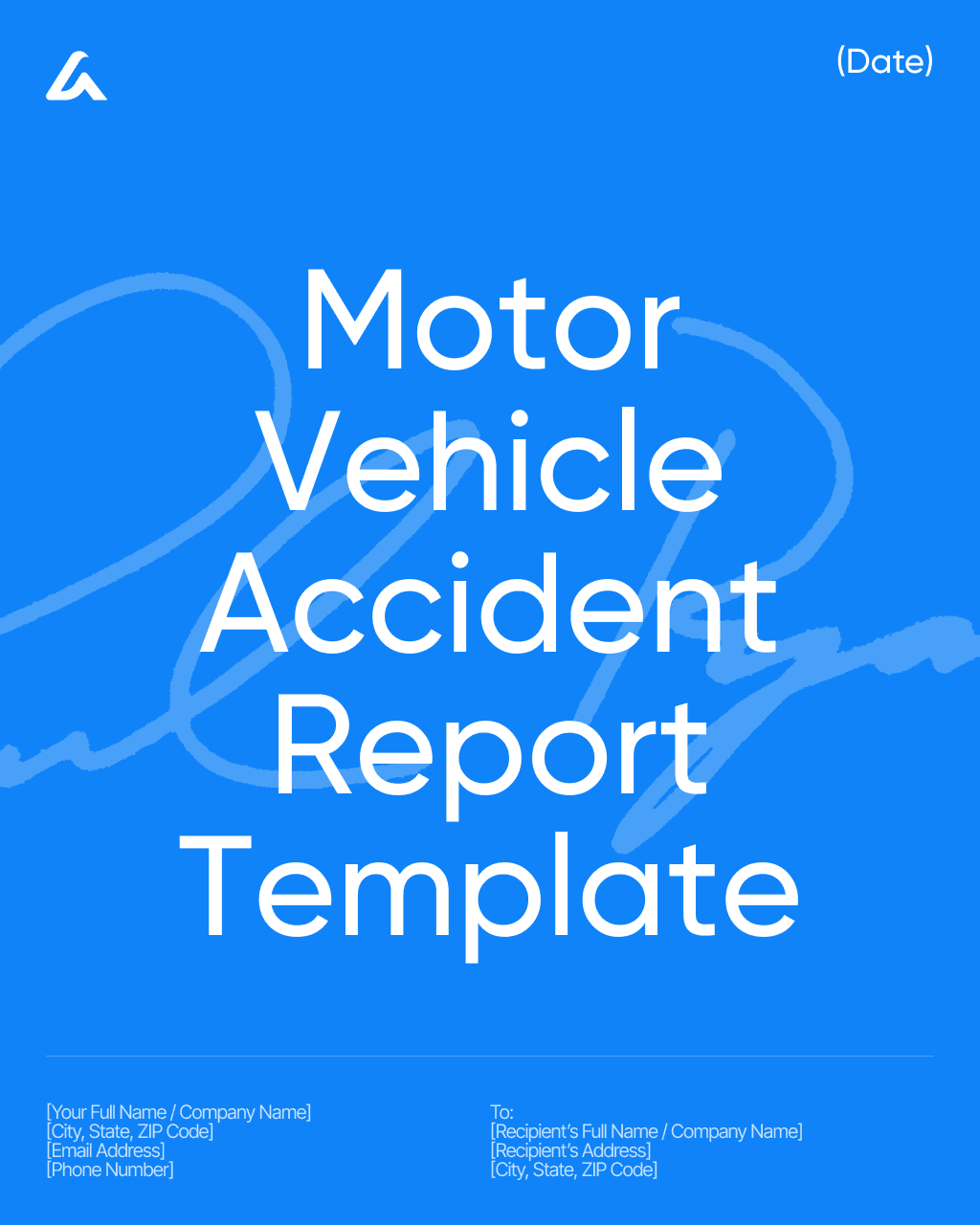
A Motor Vehicle Accident Report is a structured document used to record all essential details following a car crash or traffic-related incident. It provides an accurate, organized account of what occurred, including information about the drivers involved, vehicle damage, injuries, road conditions, witness statements, and contributing factors. This report is often required by insurance companies, attorneys, law enforcement, or employers to evaluate liability, process claims, and establish a factual record that can be referenced later.
Using a standardized Motor Vehicle Accident Report template ensures that all critical information is captured—such as date, time, and location of the accident; driver and passenger details; vehicle descriptions; diagrams of the scene; weather and visibility conditions; statements from witnesses; photographs; and notes about injuries or medical treatment. The template may also include checklists for reporting to insurance, documenting police involvement, and identifying potential violations or safety concerns. AI-powered tools like AI Lawyer help users generate complete, accurate, and professionally formatted accident reports that minimize missing details and create a reliable foundation for claims or legal review. This results in a clear and comprehensive record that supports fair resolution of disputes and efficient handling of insurance or legal processes.
Download Template: Motor Vehicle Accident Report Template
For more information please refer to our article:
Or create your own document yourself with the help of AI.
1.44 Child Injury Report
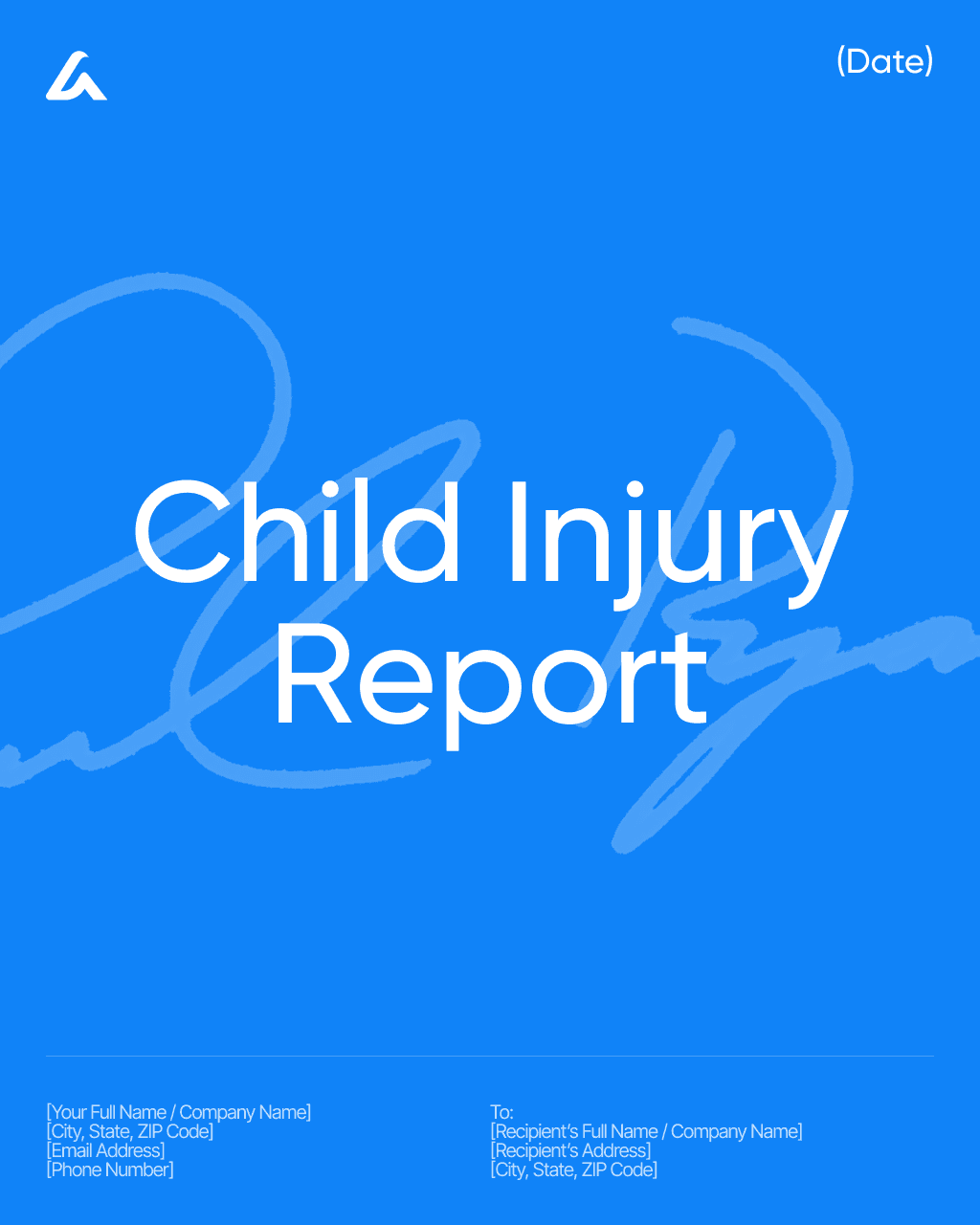
A Child Injury Report is a formal document used to record details of any accident, incident, or injury involving a child in settings such as schools, daycares, camps, playgrounds, sports programs, or medical facilities. Its purpose is to document what happened, when and where it occurred, the nature of the injury, who witnessed it, and what actions were taken in response. This report protects both the child and the organization by creating an accurate record that can be used for medical follow-up, parental communication, safety improvement, and, if necessary, legal review.
Using a standardized Child Injury Report template ensures that all essential information is collected—such as the child’s name and age, date and time of the incident, exact location, type and cause of the injury, supervising staff present, witness statements, first aid provided, follow-up recommendations, and notifications to parents or guardians. The template may also include diagrams of the scene, checkboxes for common injury types, and space for signatures from staff and caregivers to verify the report. AI-powered tools like AI Lawyer help schools, childcare providers, and organizations generate thorough, clear, and compliant injury reports that reduce liability risks, improve documentation quality, and ensure transparent communication with families. This results in a complete and reliable record that supports child safety and responsible incident management.
Download Template: Child Injury Report
For more information please refer to our article:
Or create your own document yourself with the help of AI.
1.45 Disability Evaluation Form
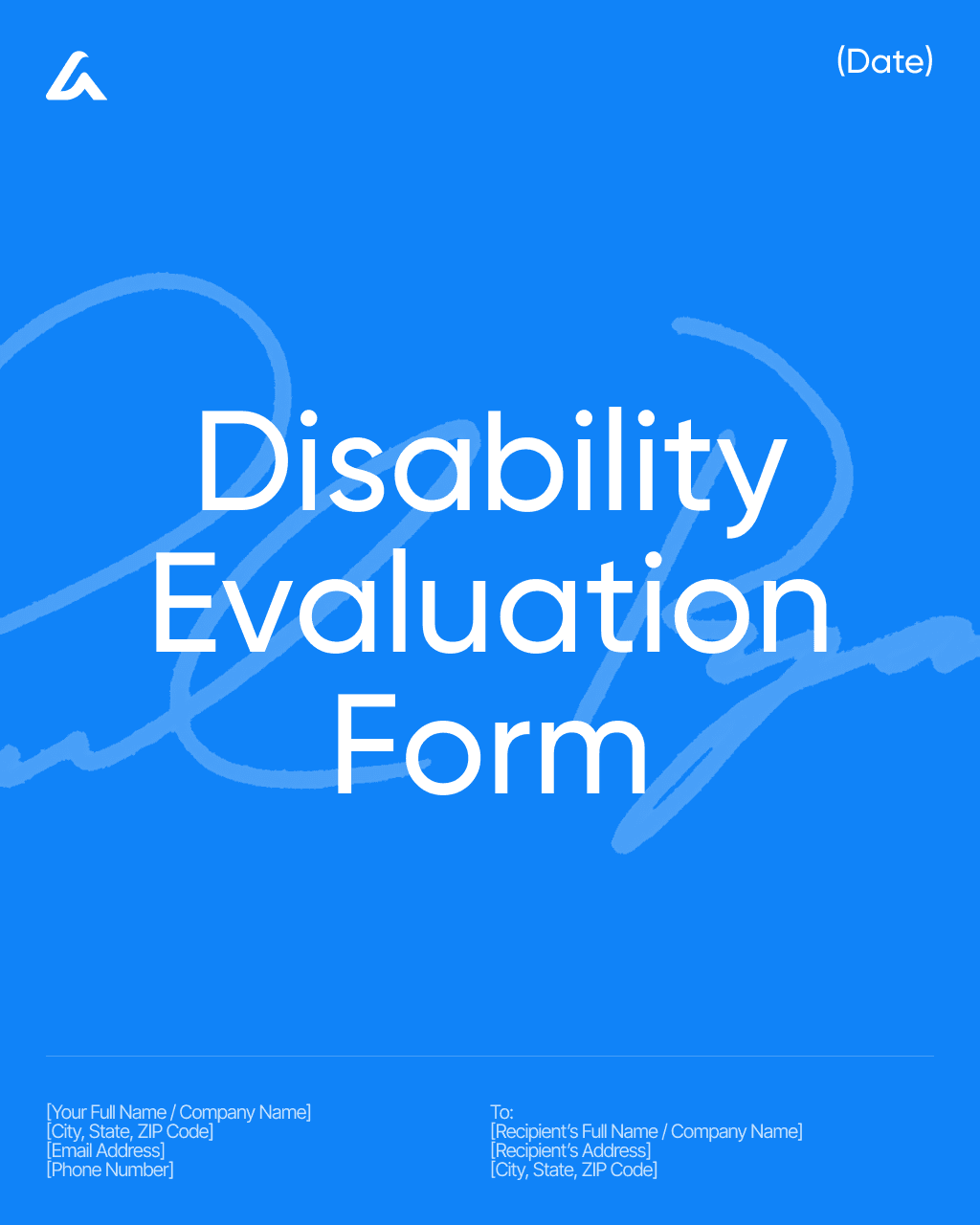
A Disability Evaluation Form is a structured assessment document used to gather detailed medical, functional, and vocational information about an individual’s physical or mental impairments and how those impairments affect daily life and ability to work. This form is commonly used by doctors, psychologists, employers, schools, insurers, and government agencies when determining eligibility for disability benefits, workplace accommodations, special education services, or return-to-work plans. Its purpose is to provide an objective, organized snapshot of the person’s diagnosis, limitations, prognosis, and treatment so decision-makers can fairly evaluate disability status or support needs.
Using a standardized Disability Evaluation Form template ensures that all critical areas are consistently addressed—such as medical history, primary diagnoses, test results, current symptoms, functional limitations (walking, lifting, concentration, self-care, etc.), medication effects, assistive devices, and the expected duration and stability of the condition. The template may also include sections for clinician opinions on work capacity, accommodation recommendations, restrictions, and the degree to which the disability impacts major life activities. AI-powered tools like AI Lawyer help professionals and organizations create clear, comprehensive, and legally compliant evaluation forms that align with disability law standards and documentation requirements. This results in a thorough, well-organized record that supports fair determinations, appropriate accommodations, and accurate benefit decisions.
Download Template: Disability Evaluation Form
For more information please refer to our article:
Or create your own document yourself with the help of AI.
1.46 Doctor’s Injury Certification

A Doctor’s Injury Certification is an official medical document completed by a licensed healthcare provider to verify that an individual has sustained a specific injury and to outline the nature, severity, and expected recovery timeline. This certification is often required by employers, schools, insurance companies, attorneys, or courts to confirm the legitimacy of an injury claim and determine necessary accommodations, time off, work restrictions, or eligibility for benefits. Its purpose is to provide a clear medical assessment that supports proper decision-making and protects all parties by ensuring accurate documentation.
Using a standardized Doctor’s Injury Certification template ensures that all essential medical details are included—such as the patient’s identity, date of examination, diagnosis, cause and mechanism of injury (if known), treatment plan, activity restrictions, anticipated recovery period, and any required follow-up care. The template may also include fields for work limitations (lifting, standing, driving, etc.), school activity restrictions, prognosis, and whether the injury is consistent with the reported incident. AI-powered tools like AI Lawyer help medical providers and organizations generate clear, detailed, and compliant certifications that meet legal, occupational, and insurance documentation standards. This results in a reliable, professional record that supports injury claims, accommodation requests, and administrative processing.
Download Template: Doctor’s Injury Certification
For more information please refer to our article:
Or create your own document yourself with the help of AI.
1.47 Employee Injury Report
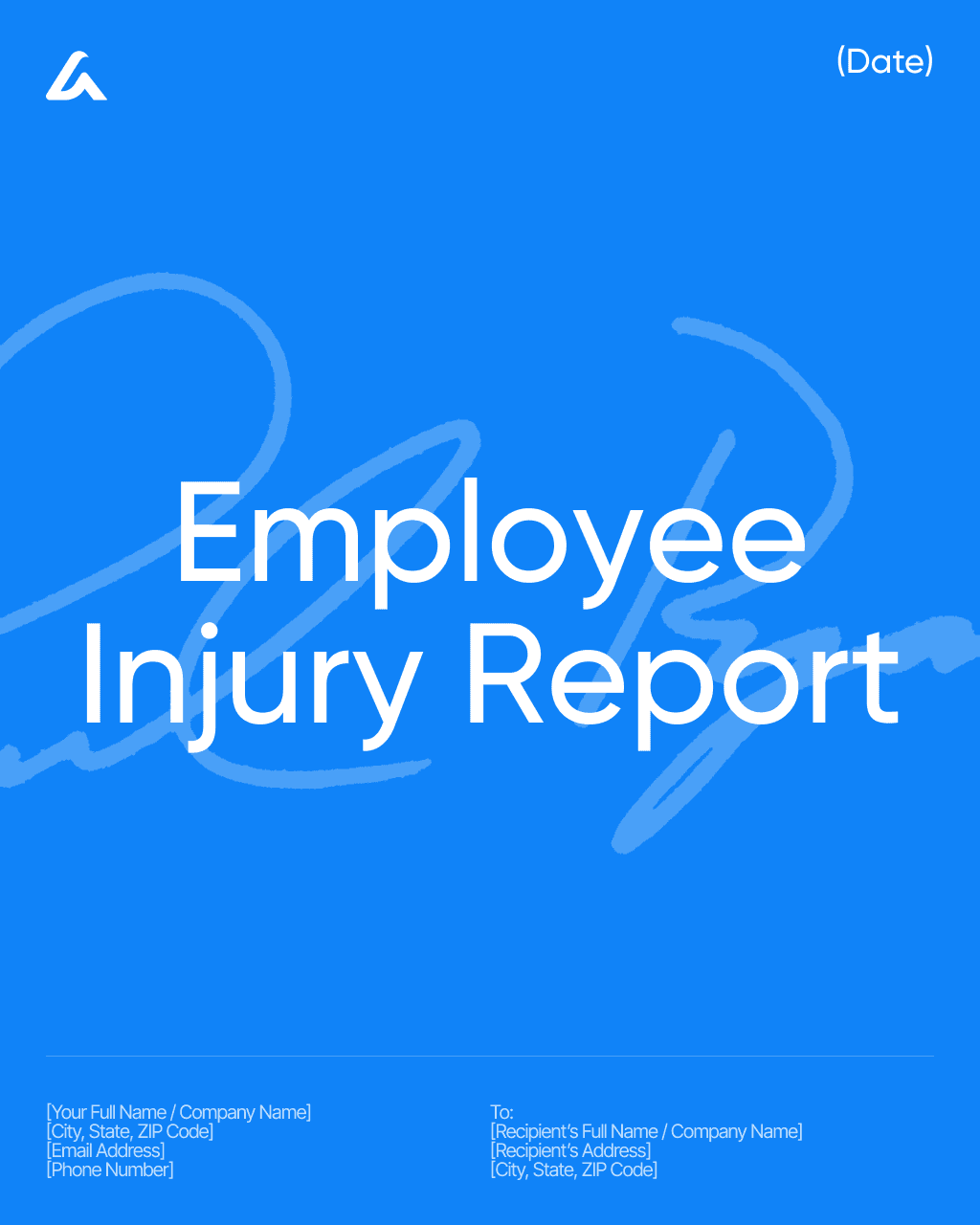
An Employee Injury Report is a formal document used to record details of any workplace accident, injury, or occupational incident involving an employee. Employers, HR departments, insurance carriers, and safety regulators rely on this report to understand what happened, assess risk, provide medical support, and determine whether workers’ compensation or other benefits apply. Its purpose is to create a clear, factual record of the incident to support safety compliance, legal protection, and proper claims processing.
Using a standardized Employee Injury Report template ensures that all essential information is captured—such as the employee’s identity, job title, date and time of the incident, location, description of the injury, equipment involved, witnesses, immediate medical response, and contributing hazards or conditions. The template may also include sections for supervisor statements, corrective actions taken, OSHA reporting requirements, and signatures to verify accuracy. AI-powered tools like AI Lawyer help organizations produce complete, consistent, and legally compliant injury reports that reduce liability, improve workplace safety practices, and ensure accurate documentation for insurance or regulatory review. This results in a clear and reliable report that supports timely response and risk management.
Download Template: Employee Injury Report
For more information please refer to our article:
Or create your own document yourself with the help of AI.
1.48 Expense Report Related to Injury
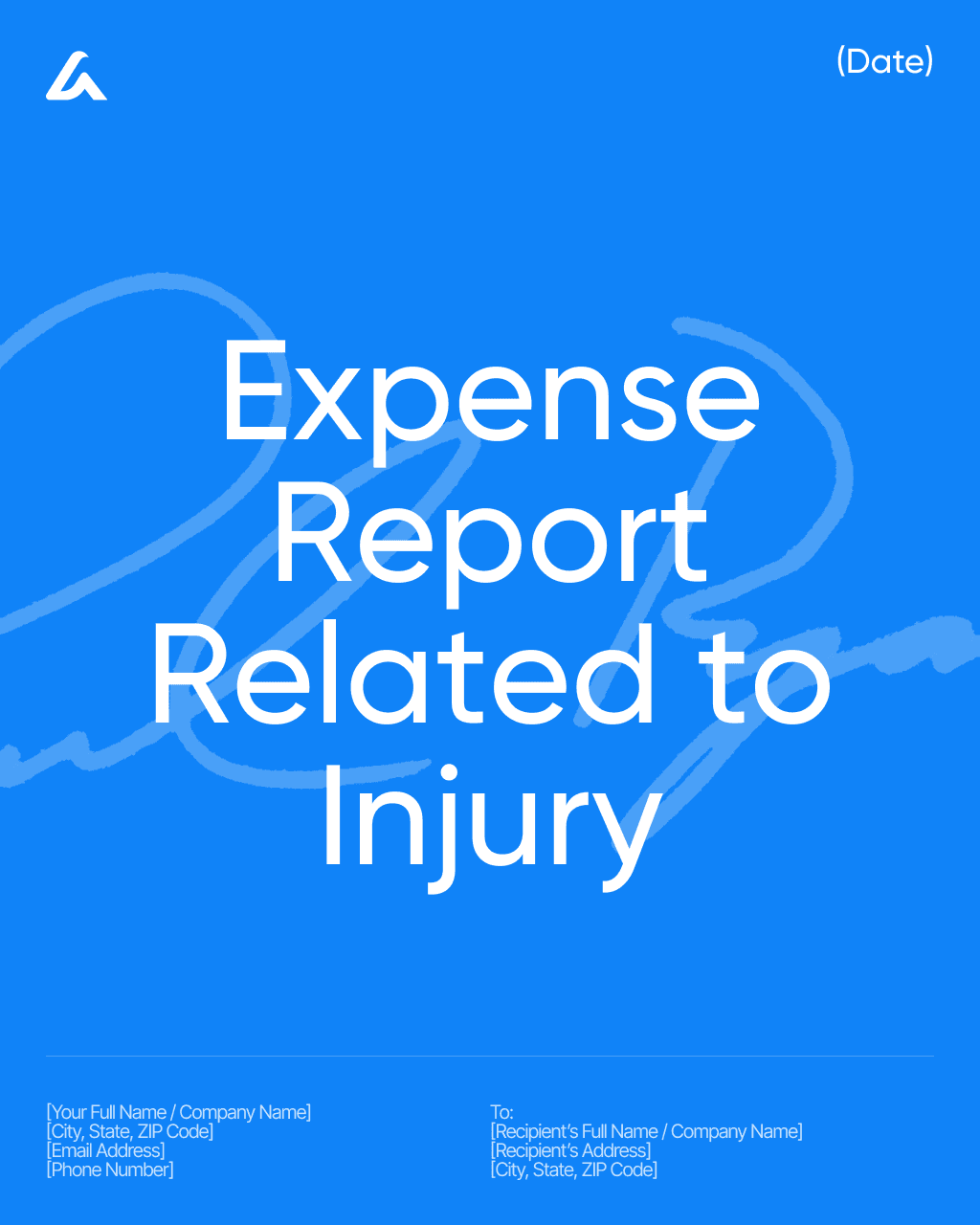
An Expense Report Related to Injury is a structured document used to itemize and verify all costs incurred as a result of an injury. This report is commonly required by insurance companies, employers, attorneys, and courts when evaluating reimbursement claims, workers’ compensation cases, personal injury lawsuits, or settlement negotiations. Its purpose is to provide a detailed financial record that shows exactly what the injured person paid for or became financially responsible for due to the incident.
Using a standardized Expense Report Related to Injury template ensures that all relevant categories of expenses are properly documented—such as medical bills, prescription costs, physical therapy, transportation to medical appointments, medical equipment purchases, lost wages, home-care services, and additional out-of-pocket costs. The template may also include fields for dates, receipts, provider names, mileage reimbursement, insurance payments, and outstanding balances. AI-powered tools like AI Lawyer help users generate complete, organized, and legally compliant expense reports that support accurate damage calculations and strengthen reimbursement or compensation claims. This results in a clear and reliable financial record that can be used in insurance reviews, legal proceedings, or employer documentation.
Download Template: Expense Report Related to Injury
For more information please refer to our article:
Or create your own document yourself with the help of AI.
1.49 Injury Assessment Form
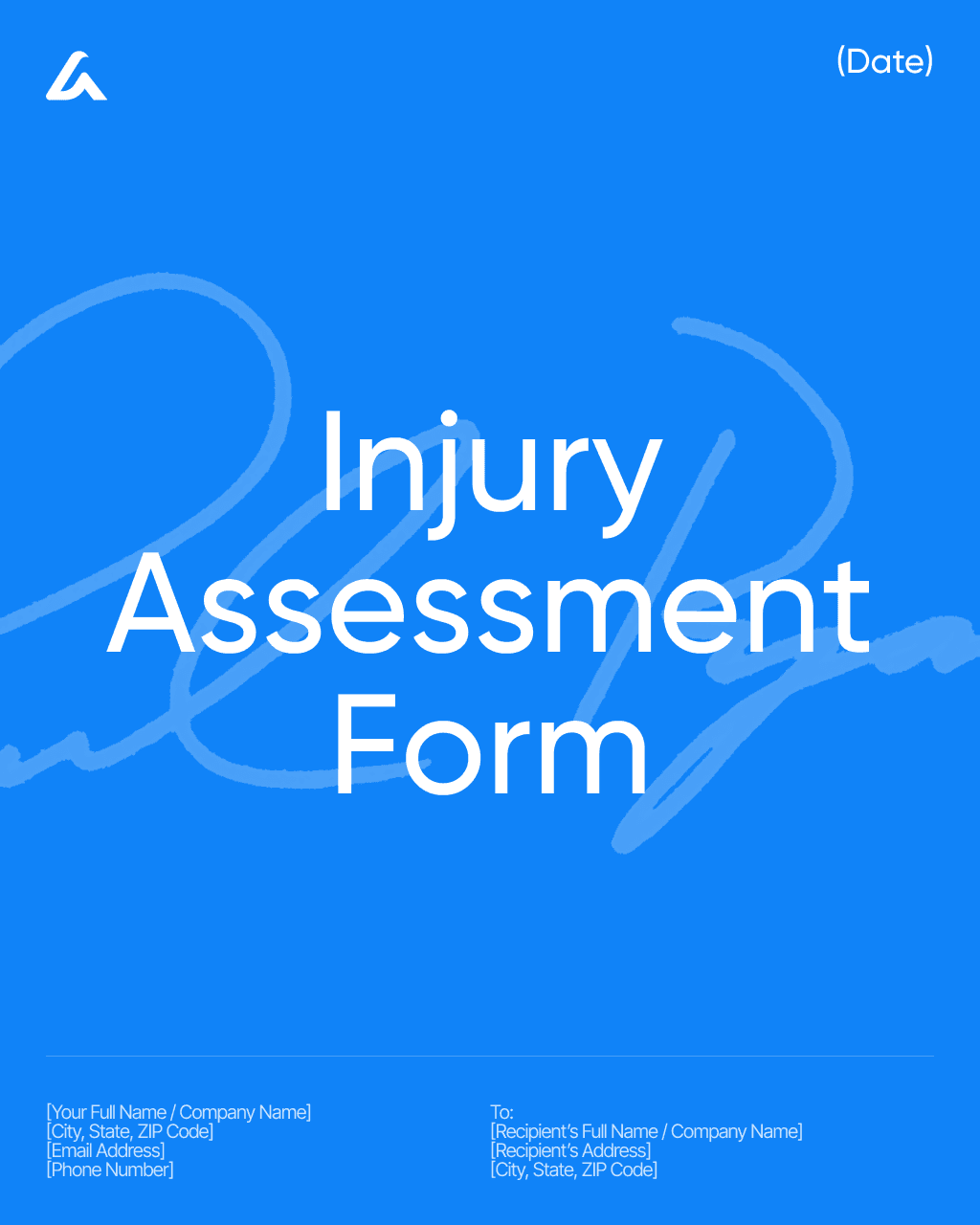
An Injury Assessment Form is a structured document used by medical professionals, schools, employers, sports organizations, and caregivers to evaluate and document the nature, severity, and circumstances of an injury. Its purpose is to capture an accurate and immediate assessment of the individual’s condition, identify visible symptoms, record functional limitations, and determine whether medical treatment, first aid, or emergency intervention is required. This form helps ensure consistent documentation, supports safety protocols, and provides a reliable reference for follow-up care or legal reporting.
Using a standardized Injury Assessment Form template ensures that all essential details are properly recorded—such as the injured person’s identity, date and time of the incident, location, type of injury, observable symptoms (swelling, bleeding, restricted movement), pain levels, vital signs (if assessed), and possible causes. The template may also include diagrams of the body for marking injury sites, fields for witness statements, first aid provided, recommended next steps, referral instructions, and staff or medical provider signatures. AI-powered tools like AI Lawyer help organizations create clear, comprehensive, and compliant assessment forms that support accurate injury evaluation, reduce liability risks, and improve continuity of care. This results in a reliable, well-documented record that guides medical decisions and ensures consistent safety practices.
Download Template: Injury Assessment Form
For more information please refer to our article:
Or create your own document yourself with the help of AI.
1.50 Injury Declaration Form
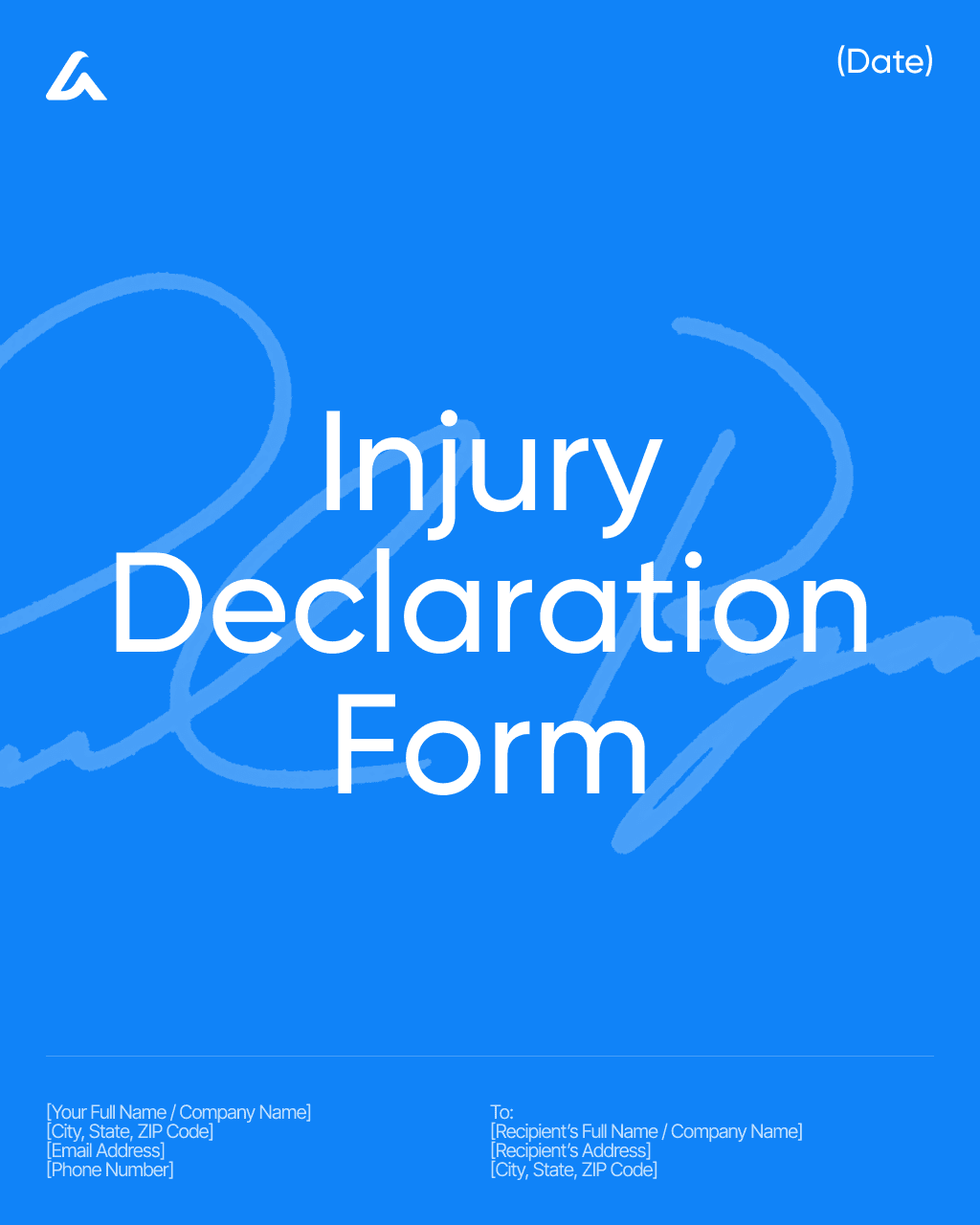
An Injury Declaration Form is a formal statement completed by an injured person (or their parent/guardian) to officially declare that an injury has occurred and to describe how, when, and where it happened. This form is often used in schools, workplaces, sports clubs, gyms, rental properties, and insurance or legal contexts to create a clear record of the incident from the injured party’s perspective. Its purpose is to provide a signed, dated declaration that confirms the circumstances of the injury, the parties involved, and any immediate effects, which can later be used for insurance claims, liability assessments, internal investigations, or legal proceedings.
Using a standardized Injury Declaration Form template ensures that all key information is consistently documented—such as the injured person’s identity, contact details, date and time of the incident, exact location, description of what occurred, type and extent of injuries, contributing factors (hazards, equipment, behavior), and whether medical treatment was sought. The template may also include sections for confirming the truthfulness of the statement, acknowledging any pre-existing conditions, listing witnesses, attaching supporting documents (photos, medical notes), and providing signatures of the injured person and, if applicable, a parent, supervisor, or representative. AI-powered tools like AI Lawyer help organizations and individuals generate clear, thorough, and compliant injury declarations that strengthen documentation quality, reduce disputes, and support fair handling of claims and safety reviews.
Download Template: Injury Declaration Form
For more information please refer to our article:
Or create your own document yourself with the help of AI.
1.51 Injury Intake Form
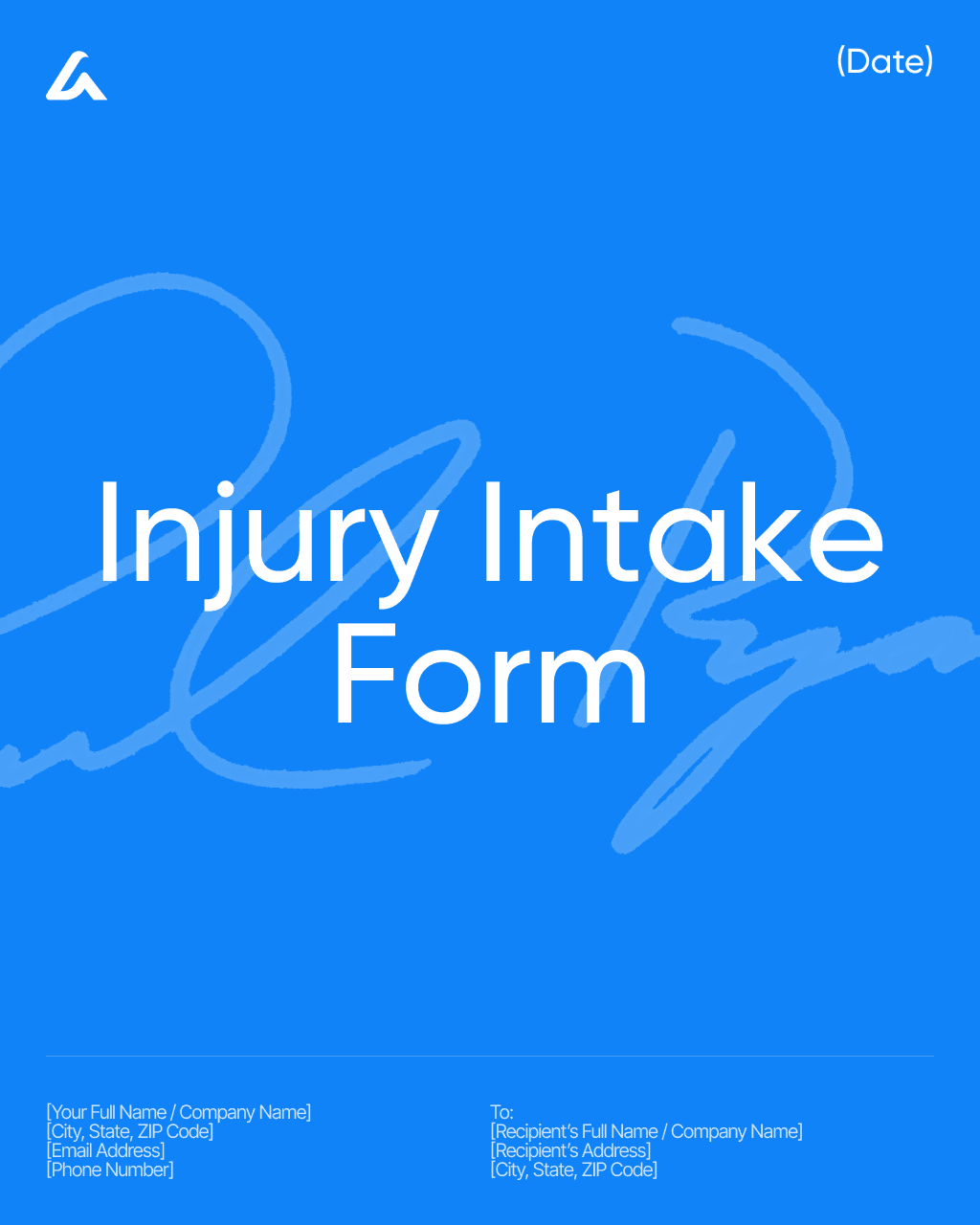
An Injury Intake Form is a structured document used at the initial point of contact to collect all essential information about an individual who has been injured and the circumstances surrounding the incident. It is commonly used by medical clinics, law offices, insurance adjusters, physical therapy centers, employers, and personal injury firms to gather key details before treatment, claim evaluation, or legal review begins. Its purpose is to efficiently capture baseline information about the injury, the person’s background, and any prior related conditions so that professionals can properly assess the situation, prioritize care, and determine next steps.
Using a standardized Injury Intake Form template ensures that all critical information is consistently recorded—such as personal and contact details, emergency contacts, description of the incident, date and location of the injury, type of injury, initial symptoms, prior injuries or conditions, insurance information, and any treatment already received. The template may also include sections for consent to treatment, release of medical records, preferred communication methods, and basic liability or disclosure statements. AI-powered tools like AI Lawyer help organizations create clear, organized, and compliant intake forms that are easy for patients or clients to complete and simple for staff to review. This results in a professional, efficient intake process that improves documentation quality, reduces missed information, and supports accurate medical, insurance, or legal follow-up.
Download Template: Injury Intake Form
For more information please refer to our article:
Or create your own document yourself with the help of AI.
1.52 Injury Report
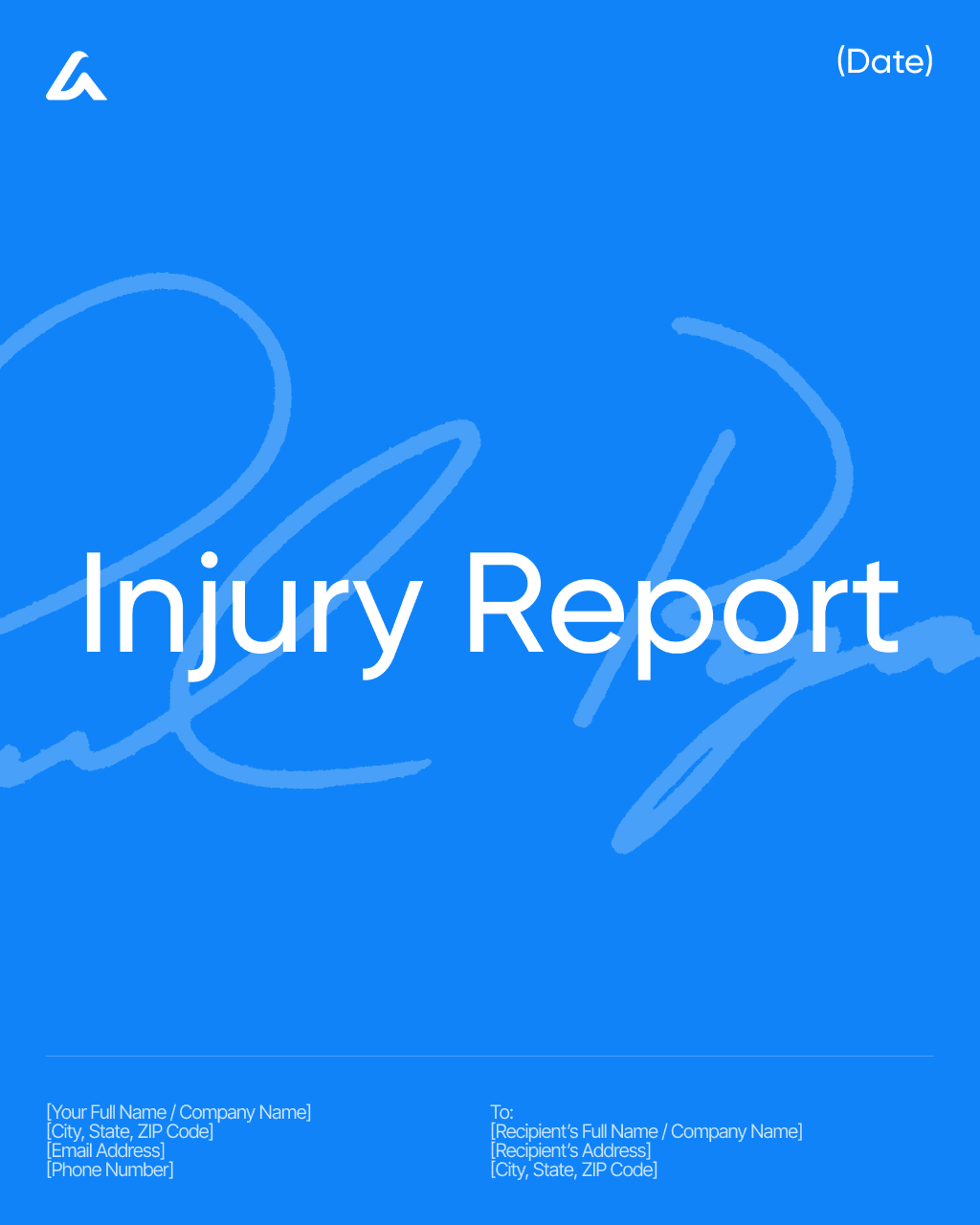
An Injury Report is a formal document used to record the details of an accident or incident in which a person is harmed, whether it occurs at work, school, home, in public, during sports, or on someone’s property. Its purpose is to create an accurate, time-stamped record of what happened, who was involved, the type and extent of injuries, and what immediate actions were taken (such as first aid, calling emergency services, or notifying supervisors). Properly completed, an injury report helps protect both the injured person and the organization by preserving key facts, supporting medical follow-up, and providing essential evidence for insurance claims, workers’ compensation, internal investigations, or potential legal proceedings.
Using a standardized Injury Report template ensures that all critical information is consistently documented—such as the injured person’s name and role, date and time of the incident, exact location, detailed description of what occurred, contributing factors or hazards, witnesses, visible injuries, pain complaints, and any treatment or transport provided. The template may also include sections for photos or diagrams of the scene, notes on corrective actions to prevent recurrence, and signatures from staff, supervisors, or the injured person to confirm accuracy. AI-powered tools like AI Lawyer help organizations generate clear, comprehensive, and compliant injury report forms that reduce the risk of missing information, improve record-keeping, and support fair and efficient handling of claims, safety reviews, and legal questions.
Download Template: Injury Report
For more information please refer to our article:
Or create your own document yourself with the help of AI.
1.53 Injury Witness Statement
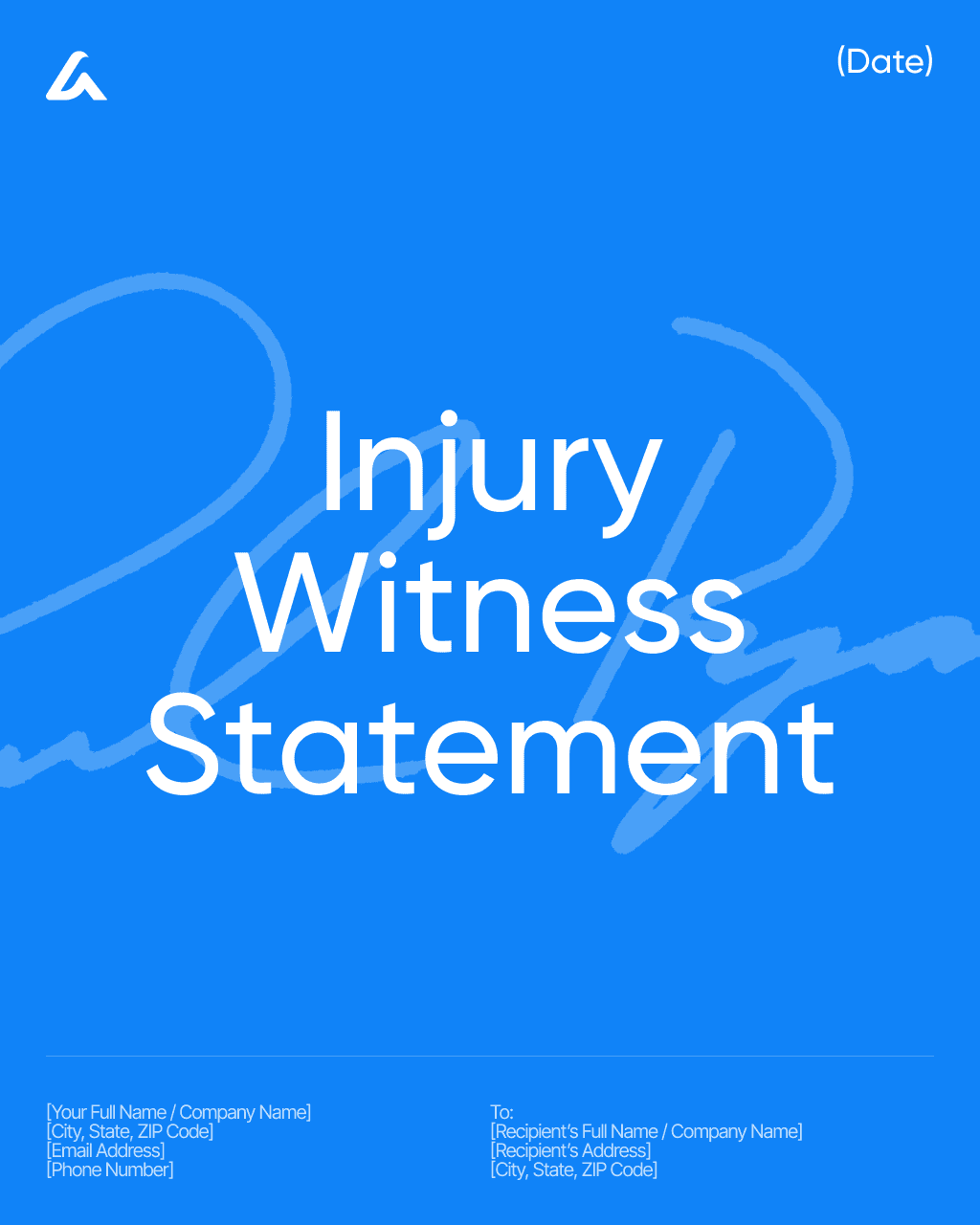
An Injury Witness Statement is a formal written account provided by someone who directly observed an accident, injury, or hazardous event. This statement is used to document what the witness saw, heard, or noticed before, during, and after the incident. It serves as an important piece of evidence for insurance companies, employers, attorneys, investigators, and safety regulators. Its purpose is to create an unbiased, factual record that can help verify the circumstances of the injury, clarify conflicting accounts, establish liability, and support claims or legal proceedings.
Using a standardized Injury Witness Statement template ensures that all essential details are captured—such as the witness’s identity and contact information, date and time of the incident, exact location, clear description of what occurred, observations about conditions (weather, hazards, equipment), statements made by involved parties, and any actions taken immediately afterward. The template may also include a sworn declaration, signature lines, diagrams of the scene, and prompts for noting visibility, distance, and the witness’s relationship (if any) to those involved. AI-powered tools like AI Lawyer help generate clear, detailed, and professionally structured witness statements that improve accuracy, reduce ambiguity, and support reliable decision-making in insurance, workplace, educational, and legal contexts.
Download Template: Injury Witness Statement
For more information please refer to our article:
Or create your own document yourself with the help of AI.
1.54 Insurance Claim Form / Insurance Injury Form
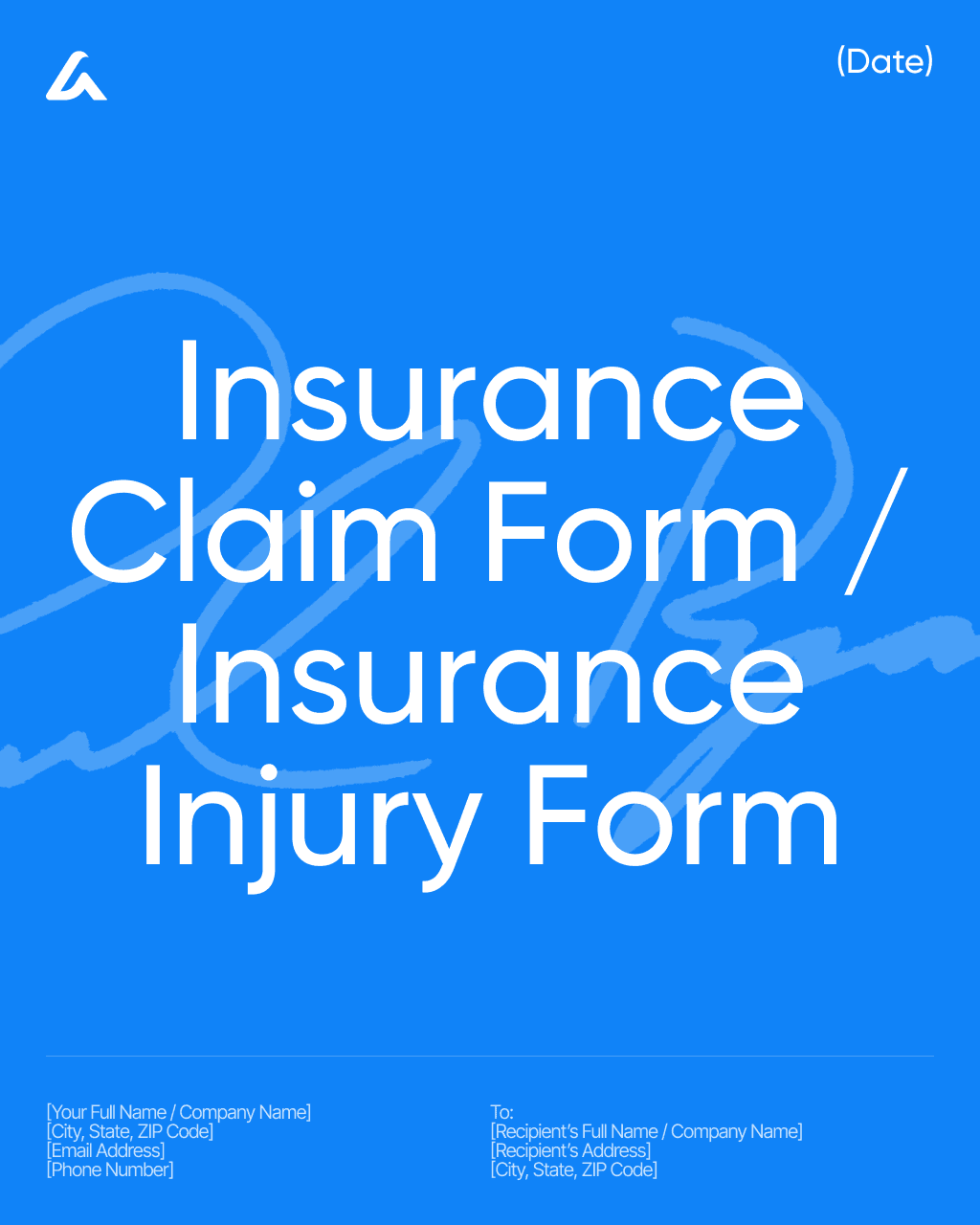
An Insurance Claim Form / Insurance Injury Form is a structured document used to report an injury, accident, or loss to an insurance company so that a claim can be evaluated and processed. This form captures all key details about what happened, who was involved, the nature of the injuries or damages, and the financial impact. It is commonly used in situations involving car accidents, workplace injuries, slip-and-fall incidents, medical treatment, property damage, or other covered events. Its purpose is to provide the insurer with a clear, complete record so they can determine coverage, assign adjusters, request supporting documents, and decide whether to approve, deny, or negotiate the claim.
Using a standardized Insurance Claim / Injury Form template ensures that all essential information is properly documented—such as policyholder details, policy number, date and location of the incident, description of events, type and extent of injuries, medical providers involved, treatment received, lost wages, property damage, and any witnesses or police reports. The template may also include sections for attaching medical bills, repair estimates, photographs, and supporting statements, as well as declarations confirming that the information provided is true and accurate. AI-powered tools like AI Lawyer help individuals and organizations generate clear, complete, and insurer-ready claim forms by guiding users through each required field and reducing the risk of missing or inconsistent information. This results in a professional, well-organized submission that can speed up claim handling and strengthen the chances of a fair settlement.
Download Template: Insurance Claim Form / Insurance Injury Form
For more information please refer to our article:
Or create your own document yourself with the help of AI.
1.55 Loss of Income Statement
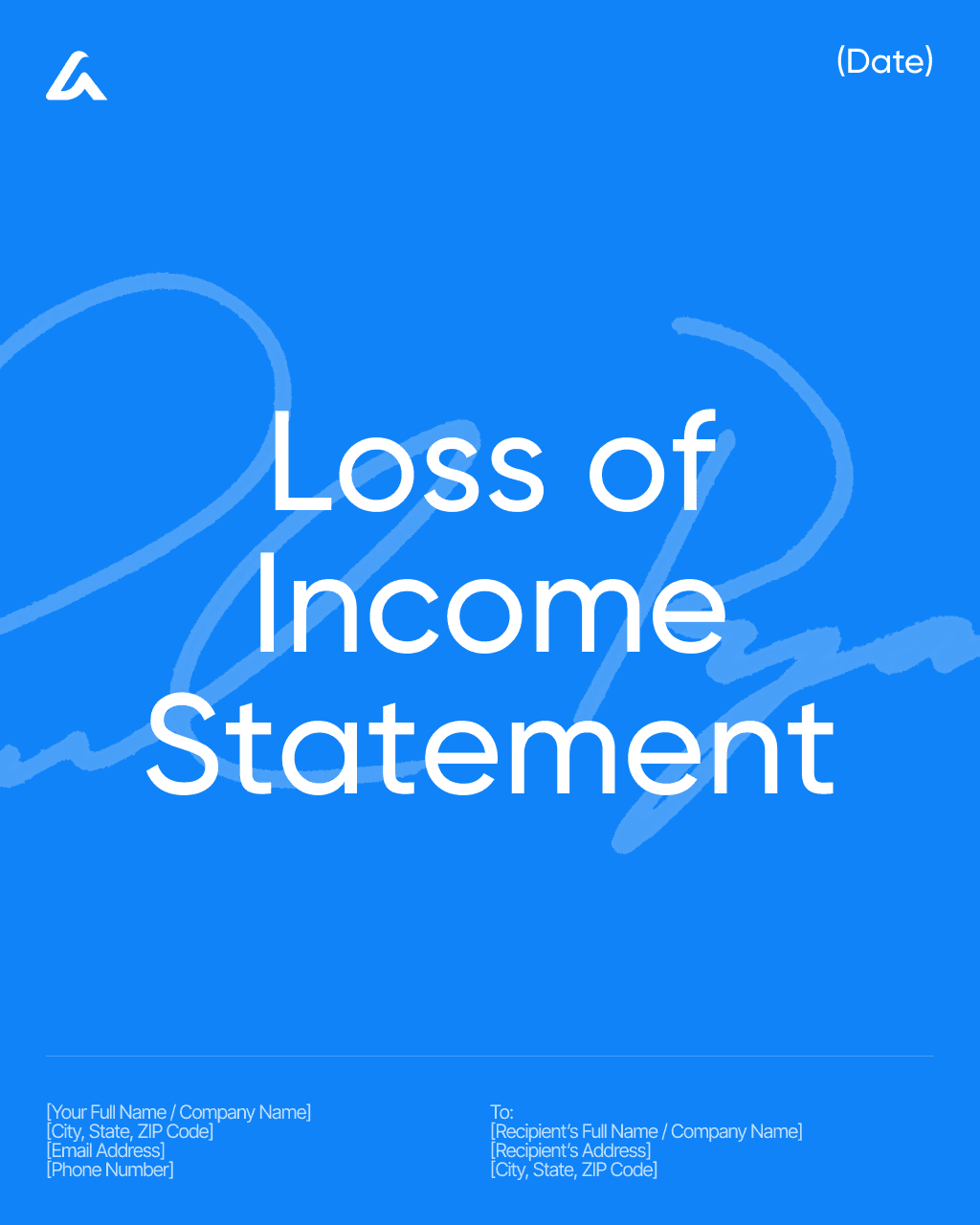
A Loss of Income Statement is a detailed document used to show how much income an individual has lost as a result of an injury, illness, accident, wrongful termination, business interruption, or other disruptive event. It is commonly required by insurance companies, employers, attorneys, courts, or government agencies when evaluating claims for compensation, disability benefits, wage replacement, or financial assistance. Its purpose is to clearly demonstrate the difference between what the person normally would have earned and what they actually earned during the affected period, providing a financial snapshot that supports fair reimbursement or settlement.
Using a standardized Loss of Income Statement template ensures that all essential financial information is organized and documented—such as employment or business details, regular wages or salary, average hours worked, commissions, bonuses, tips, overtime, self-employment income, time missed from work, and the exact dates of income disruption. The template may also include sections for attaching pay stubs, tax returns, employer letters, medical records, or other proof that explains why the income was lost and confirms that the loss is directly related to the covered event. AI-powered tools like AI Lawyer help individuals and professionals create clear, accurate, and well-structured loss-of-income statements that align with insurance and legal standards, resulting in a strong, credible financial record that supports claims for compensation or benefits.
Download Template: Loss of Income Statement
For more information please refer to our article:
Or create your own document yourself with the help of AI.
1.56 Medical Expense Summary
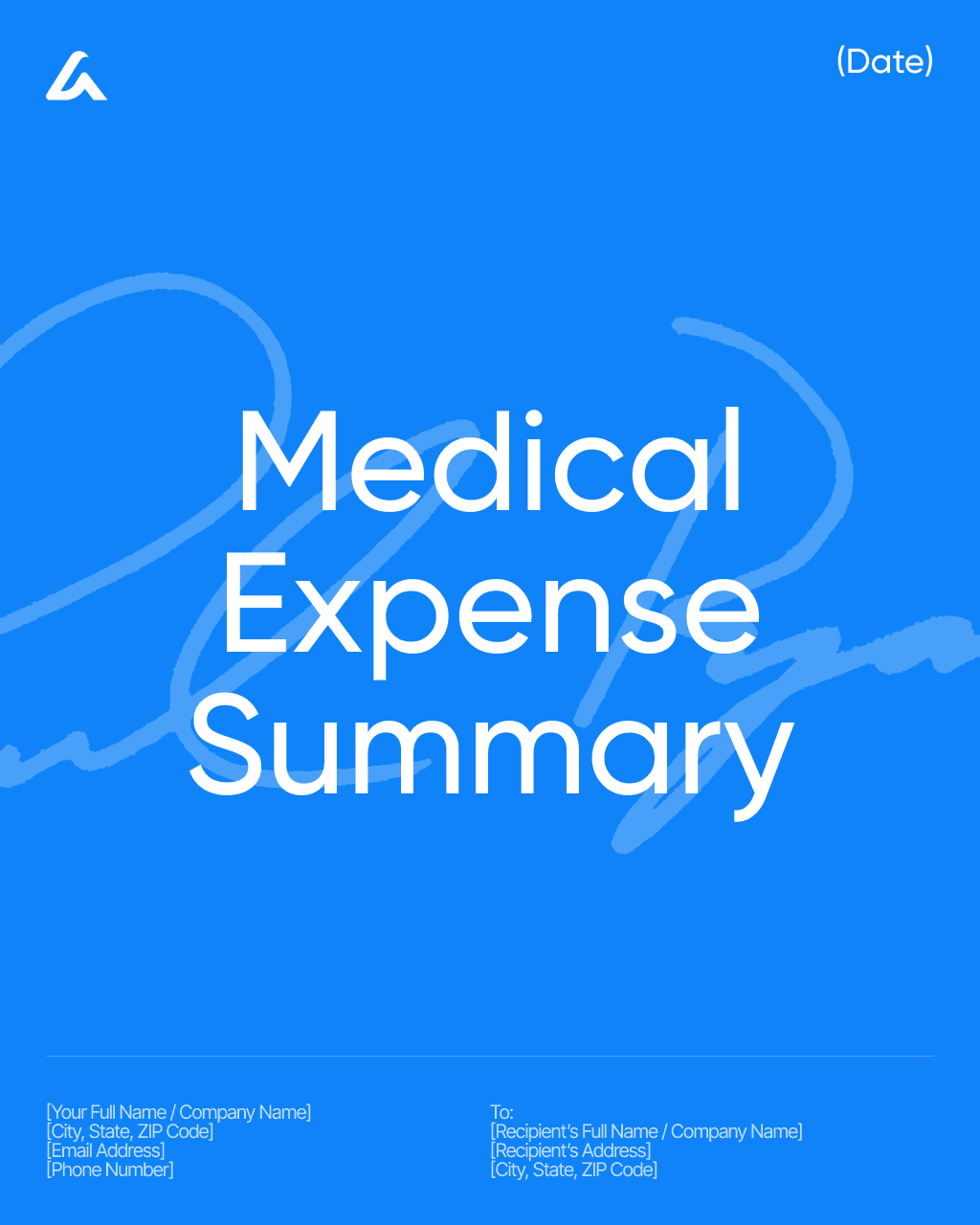
A Medical Expense Summary is a clear, organized document that itemizes all medical-related costs incurred due to an illness, accident, injury, or ongoing treatment. It is commonly required by insurance companies, personal injury attorneys, courts, employers, and financial assistance programs to evaluate reimbursement claims, settlement amounts, or eligibility for benefits. Its purpose is to compile all medical charges in one place—making it easier to verify expenses, calculate total costs, and support financial or legal requests tied to the medical condition.
Using a standardized Medical Expense Summary template ensures that all essential details are properly documented—such as dates of service, provider names, medical procedures, treatments, prescriptions, diagnostic tests, therapy sessions, and associated charges. The template may also include fields for insurance payments, outstanding balances, out-of-pocket costs, mileage for medical travel, medical equipment purchases, and anticipated future expenses. AI-powered tools like AI Lawyer help users create clear, comprehensive, and accurately formatted medical expense summaries that meet insurance and legal requirements, ensuring no key expenses are missed. This results in a reliable financial record that strengthens claims, supports negotiations, and provides a transparent picture of all medical-related costs.
Download Template: Medical Expense Summary
For more information please refer to our article:
Or create your own document yourself with the help of AI.
1.57 Medical Injury Report

A Medical Injury Report is a formal document completed by a healthcare professional to describe, evaluate, and document an injury and its medical implications. It is typically used in workplace accidents, motor vehicle collisions, school or sports injuries, assaults, or other incidents where treatment is provided and a written medical record is needed for insurance, legal, or administrative purposes. Its purpose is to create an objective, clinically based account of the injury—linking symptoms and findings to the reported incident, clarifying diagnosis, and outlining necessary treatment, restrictions, and prognosis.
Using a standardized Medical Injury Report template ensures that all critical clinical and factual information is consistently captured—such as patient identification, date and time of examination, description of the incident (as reported), visible injuries, physical exam findings, diagnostic test results, diagnosis, treatment provided, medications prescribed, referrals, and any recommended work, school, or activity restrictions. The template may also include sections for assessing whether injuries are consistent with the reported mechanism, documenting prior relevant conditions, and noting follow-up care or rehabilitation recommendations. AI-powered tools like AI Lawyer help providers and organizations generate clear, thorough, and legally compliant medical injury reports that meet insurance, regulatory, and litigation standards. This results in a professional, reliable record that supports accurate claims handling, legal review, and continuity of patient care.
Download Template: Medical Injury Report
For more information please refer to our article:
Or create your own document yourself with the help of AI.
1.58 Medical Records Request Form
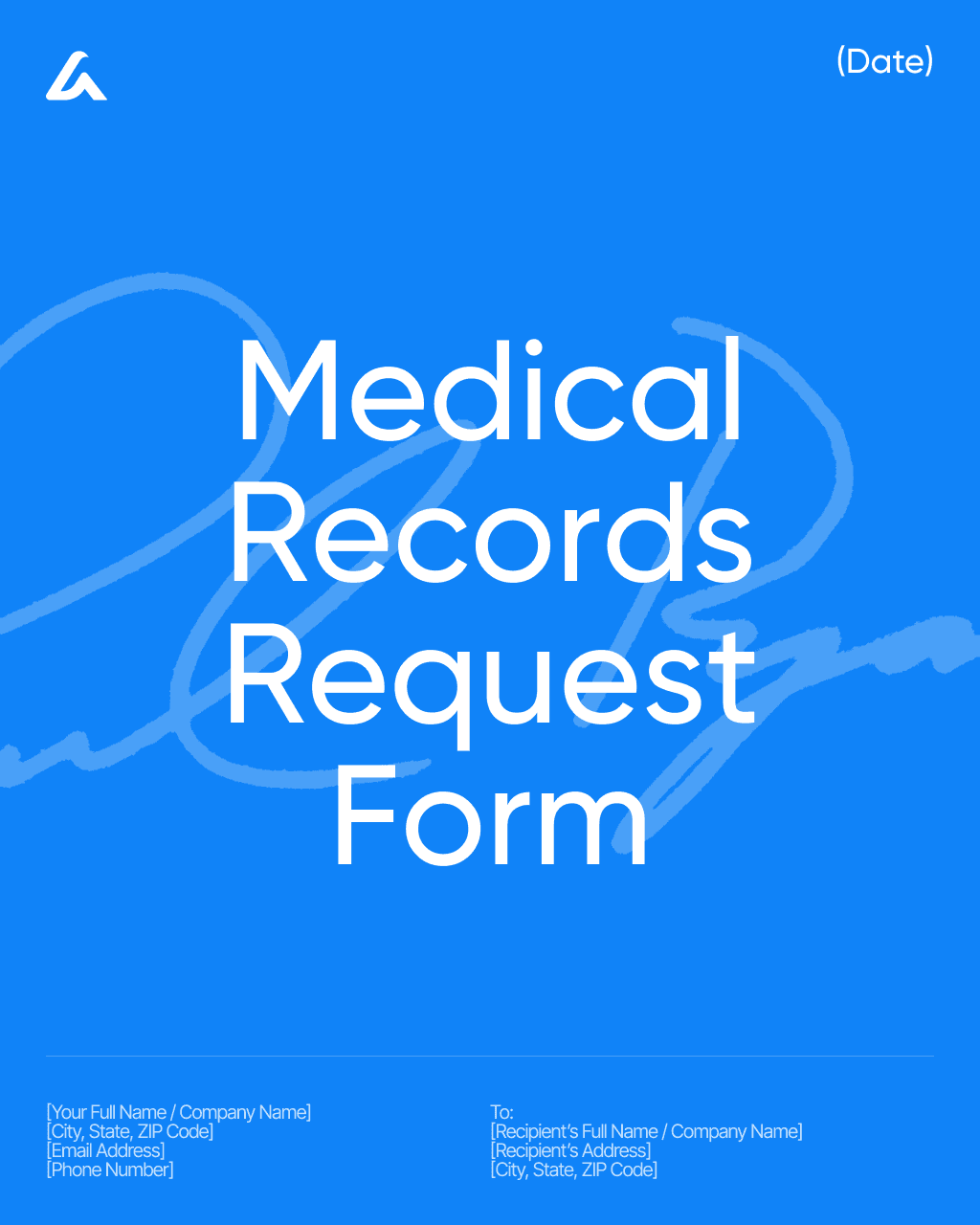
A Medical Records Request Form is a standardized document used to formally ask a healthcare provider, hospital, clinic, or medical records department to release, transfer, or provide copies of a patient’s medical records. This form is essential when an individual needs their records for personal review, a new doctor, legal proceedings, insurance claims, disability applications, or continuity of care. Its purpose is to ensure that the request is clear, properly authorized, and compliant with privacy laws such as HIPAA or similar regulations, helping providers confirm who is requesting the records and why.
Using a standardized Medical Records Request Form template ensures that all required information is clearly included—such as the patient’s full name, date of birth, contact details, specific records requested (dates of treatment, providers, types of records), delivery method (mail, fax, secure portal, pickup), and the name of the person or organization receiving the records. The template also typically contains sections for patient authorization, consent to release sensitive categories of information (such as mental health, HIV status, or substance use treatment, where applicable), time limitations, and a signature with date. AI-powered tools like AI Lawyer help users generate clear, compliant, and professionally formatted request forms that reduce delays, minimize incomplete submissions, and align with legal privacy requirements—resulting in a smooth, efficient process for obtaining medical records.
Download Template: Medical Records Request Form
For more information please refer to our article:
Or create your own document yourself with the help of AI.
1.59 Motor Vehicle Injury Report
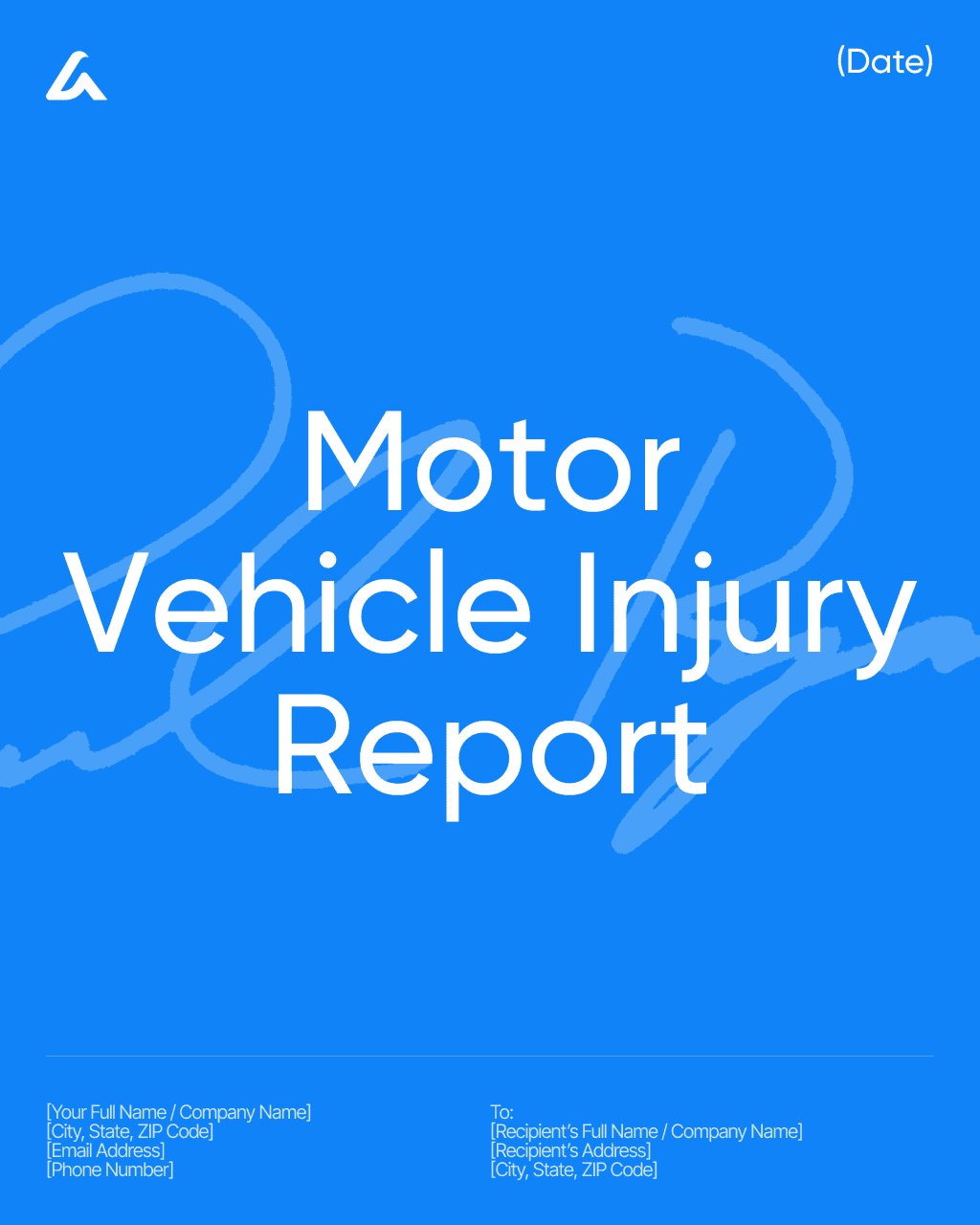
A Motor Vehicle Injury Report is a formal document used to record injuries sustained in a car accident, motorcycle crash, truck collision, or any other motor vehicle–related incident. It is typically prepared by medical professionals, law enforcement, employers, insurance adjusters, or legal representatives to create a comprehensive and factual record of the injuries, how they occurred, and what treatment was provided. Its purpose is to support insurance claims, legal actions, workplace reporting requirements, and continuity of medical care by documenting the connection between the accident and the injuries.
Using a standardized Motor Vehicle Injury Report template ensures that all essential details are properly captured—such as the injured person’s identification, date and time of the accident, vehicle information, collision description, initial symptoms, visible injuries, physical exam findings, diagnostic results (X-rays, scans), treatment provided, medications, and recommended follow-up care. The template may also include sections linking the injuries to the reported mechanism of the crash, noting contributing factors such as seatbelt use or airbag deployment, and providing diagrams or photos. AI-powered tools like AI Lawyer help users generate clear, consistent, and legally compliant motor vehicle injury reports that meet insurance, medical, and legal standards. This results in a reliable record that supports fair claim evaluation, strengthens legal documentation, and ensures accurate medical follow-up.
Download Template: Motor Vehicle Injury Report
For more information please refer to our article: Injury Report Templates: OSHA-Ready Forms, Examples & Step-by-Step Reporting Guide
Or create your own document yourself with the help of AI.
1.60 Pain and Suffering Statement
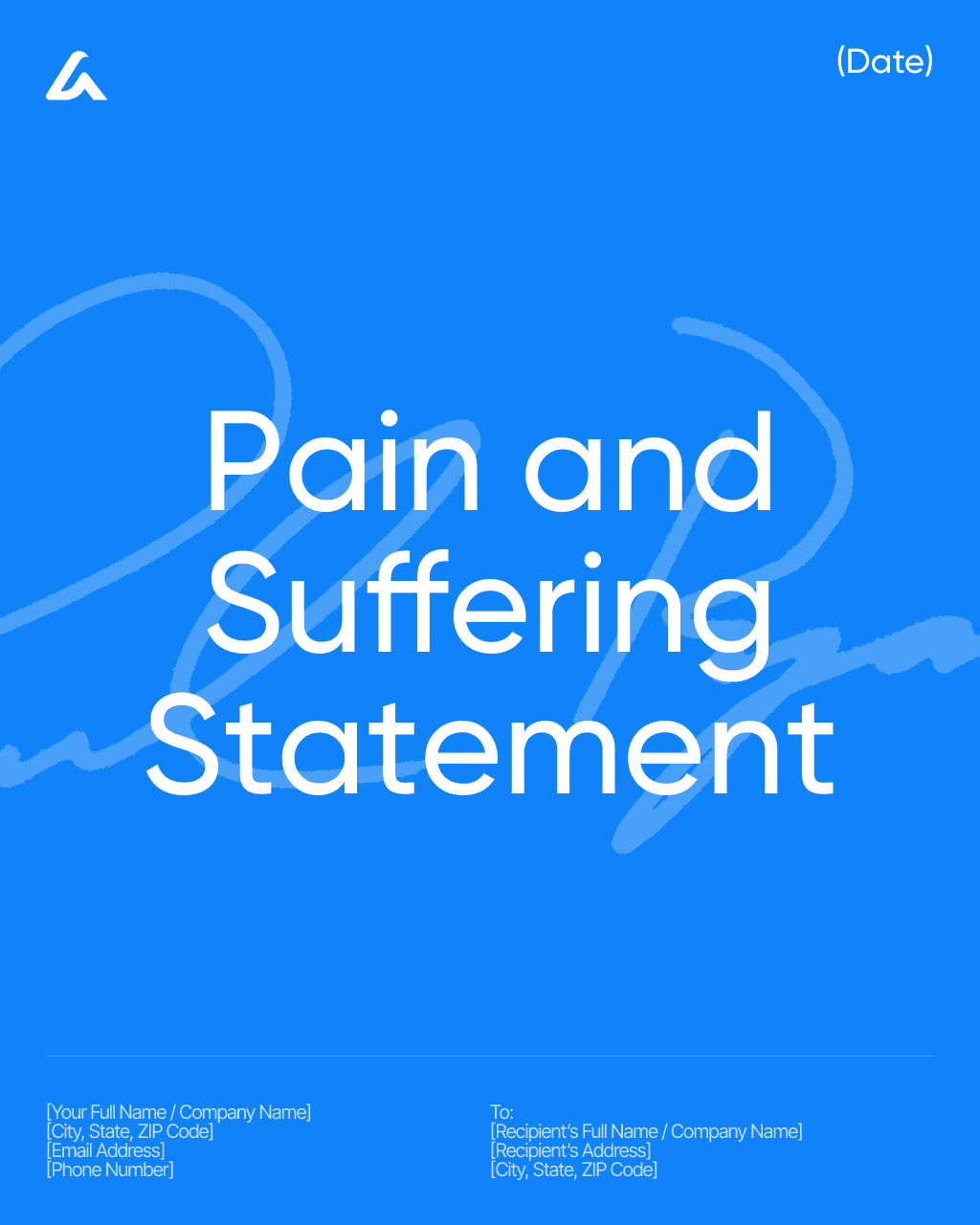
A Pain and Suffering Statement is a personal written account used to describe the physical pain, emotional distress, and overall impact of an injury or accident on an individual’s daily life. It is commonly submitted in personal injury cases, insurance claims, settlement negotiations, or legal proceedings to help quantify non-economic damages. Its purpose is to provide a human, detailed explanation of how the incident has affected the person’s well-being, lifestyle, relationships, work, mental health, and long-term quality of life—factors that cannot be measured by receipts or medical bills alone.
Using a standardized Pain and Suffering Statement template ensures that all important aspects are clearly documented—such as the nature and severity of the injuries, duration and frequency of pain, limitations in daily activities, emotional symptoms (anxiety, depression, sleep issues), impact on work and hobbies, medical treatments undergone, and long-term or permanent effects. The template may also include sections for describing the individual's personal background, comparing pre- and post-incident functioning, and including supporting details like doctor notes, therapy records, or medication lists. AI-powered tools like AI Lawyer help individuals craft clear, compelling, and well-organized statements that capture both the physical and emotional consequences of an injury, resulting in a persuasive document that supports fair compensation and strengthens legal or insurance claims.
Download Template: Pain and Suffering Statement
For more information please refer to our article: Injury Report Templates: OSHA-Ready Forms, Examples & Step-by-Step Reporting Guide
Or create your own document yourself with the help of AI.
1.61 Personal Injury Claim Form
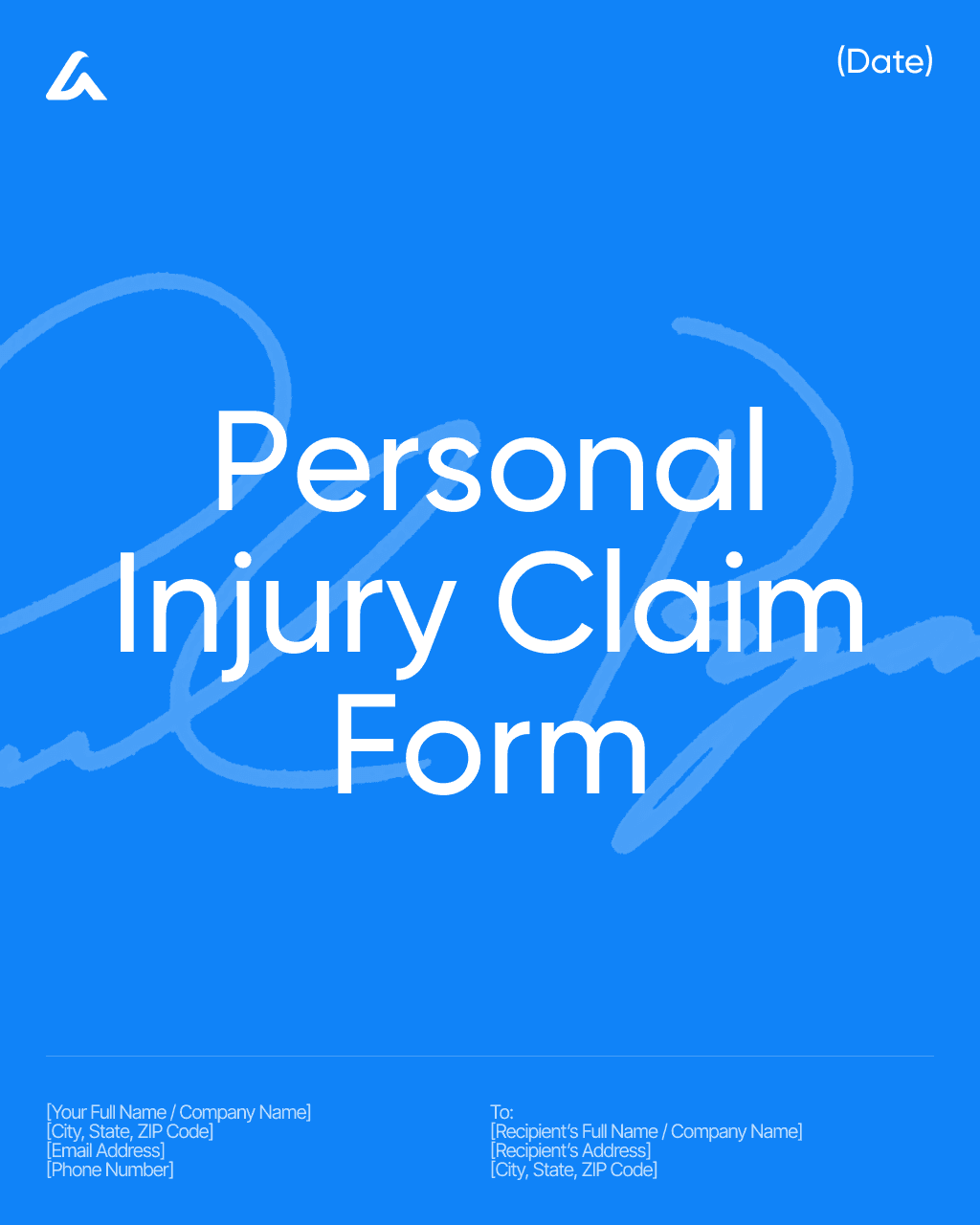
A Personal Injury Claim Form is a structured document used to officially report an injury and request compensation from an insurance company, employer, property owner, or other responsible party. It is commonly used in cases involving car accidents, workplace injuries, slip-and-fall incidents, product defects, medical negligence, or any situation where someone’s negligence or wrongdoing caused harm. Its purpose is to provide a complete and accurate account of the incident, injuries, medical treatment, financial losses, and supporting evidence so that the claim can be reviewed, processed, and resolved fairly.
Using a standardized Personal Injury Claim Form template ensures that all essential information is thoroughly documented—such as the claimant’s personal details, date and description of the incident, injury type and severity, medical treatment received, healthcare provider information, lost income, out-of-pocket expenses, property damage, witness statements, police or incident reports, and insurance policy details. The template may also include declarations confirming the truthfulness of the claim, authorization to release medical records, and space to attach supporting documents like photos, receipts, and medical records. AI-powered tools like AI Lawyer help individuals and professionals create clear, complete, and legally compliant claim forms that minimize errors, strengthen supporting documentation, and streamline the claims review process. This results in a strong, organized submission that increases the likelihood of fair compensation.
Download Template: Personal Injury Claim Form
For more information please refer to our article: Injury Report Templates: OSHA-Ready Forms, Examples & Step-by-Step Reporting Guide
Or create your own document yourself with the help of AI.
1.62 Personal Injury Demand Letter

A Personal Injury Demand Letter is a formal written request sent to an insurance company, at-fault party, or their legal representative to seek compensation for injuries, damages, and losses resulting from an accident or incident. It serves as the foundation for settlement negotiations and outlines the claimant’s legal position, medical treatment history, financial losses, and the total amount demanded. Its purpose is to present a clear, organized, and persuasive argument demonstrating liability, documenting damages, and encouraging fair settlement without the need for litigation.
Using a standardized Personal Injury Demand Letter template ensures that all essential elements are included—such as a detailed description of the incident, evidence of the other party’s negligence, summaries of injuries and medical treatment, itemized financial losses (medical bills, lost wages, property damage), and non-economic damages such as pain and suffering. The template may also include timelines, supporting documentation lists, photos, medical records, and a firm settlement demand amount with a deadline for response. AI-powered tools like AI Lawyer help individuals and attorneys craft strong, persuasive, and well-structured demand letters that align with legal best practices, increasing the chances of a timely and fair settlement.
Download Template: Personal Injury Demand Letter
For more information please refer to our article: Injury Report Templates: OSHA-Ready Forms, Examples & Step-by-Step Reporting Guide
Or create your own document yourself with the help of AI.
1.63 Personal Injury Questionnaire
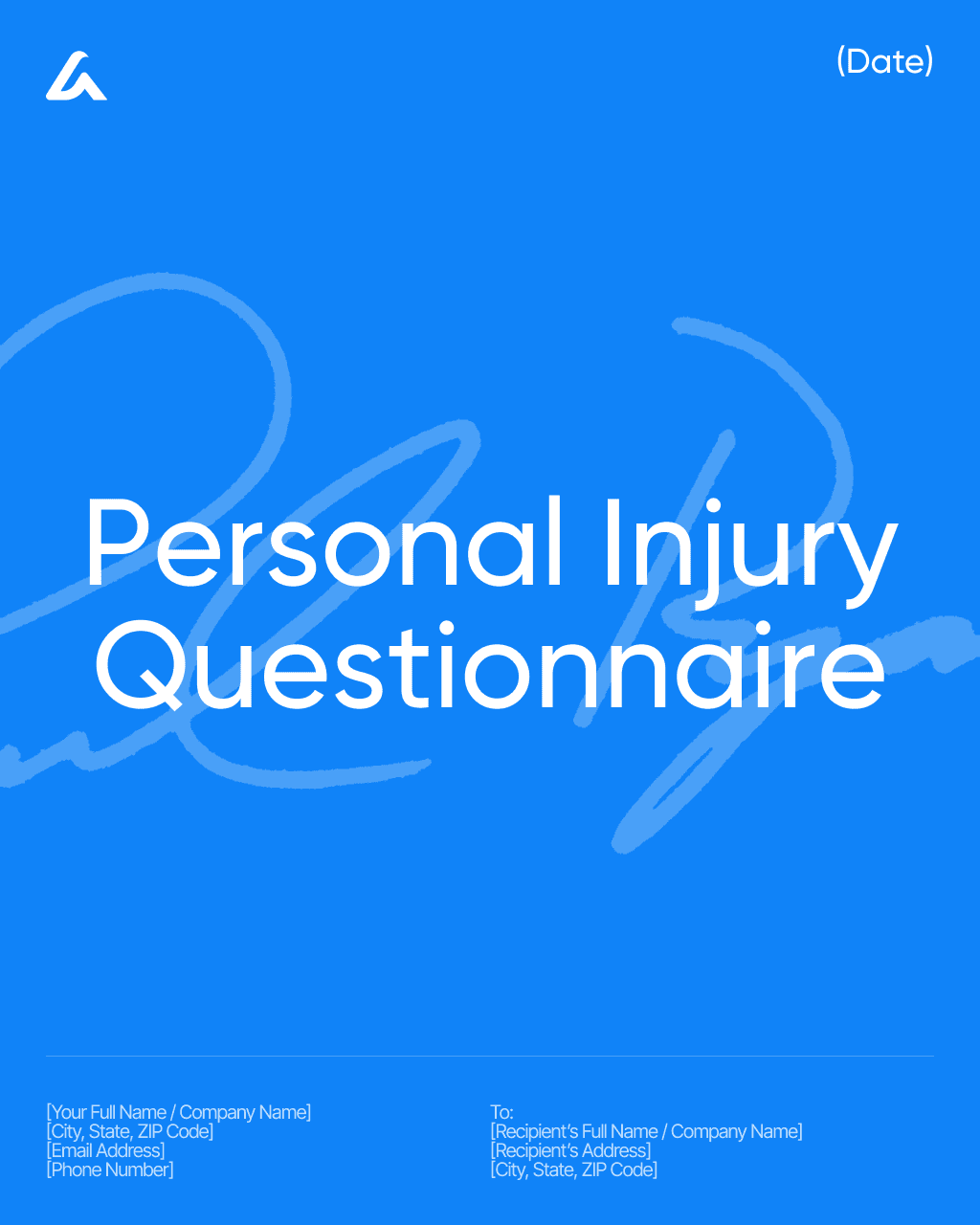
A Personal Injury Questionnaire is a comprehensive intake and assessment form used to gather detailed information from an individual who has suffered an injury due to an accident, negligence, hazardous conditions, or wrongful conduct. Law firms, insurance providers, medical professionals, and claims adjusters use this questionnaire to understand the full context of the incident, evaluate liability, document injuries, and determine the scope of damages. Its purpose is to capture a complete profile of the event, injuries, medical treatment, financial losses, and personal impact—ensuring all key facts are available for case evaluation, claims processing, or legal strategy.
Using a standardized Personal Injury Questionnaire template ensures that all critical categories are covered—such as personal and contact information, employment status, detailed description of the incident, location and conditions, witness information, severity and progression of injuries, prior medical issues, treatment providers, medications, lost wages, lifestyle disruptions, and insurance details. The template may also include sections on pain levels, emotional distress, long-term limitations, and documentation of follow-up care. AI-powered tools like AI Lawyer help organizations and individuals generate clear, thorough, and professionally structured questionnaires that reduce missing information, strengthen claims, and support accurate legal or medical evaluations. This results in a well-documented foundation that improves case preparation, speeds up claim handling, and supports fair compensation.
Download Template: Personal Injury Questionnaire
For more information please refer to our article: Injury Report Templates: OSHA-Ready Forms, Examples & Step-by-Step Reporting Guide
Or create your own document yourself with the help of AI.
1.64 Personal Injury Retainer Agreement
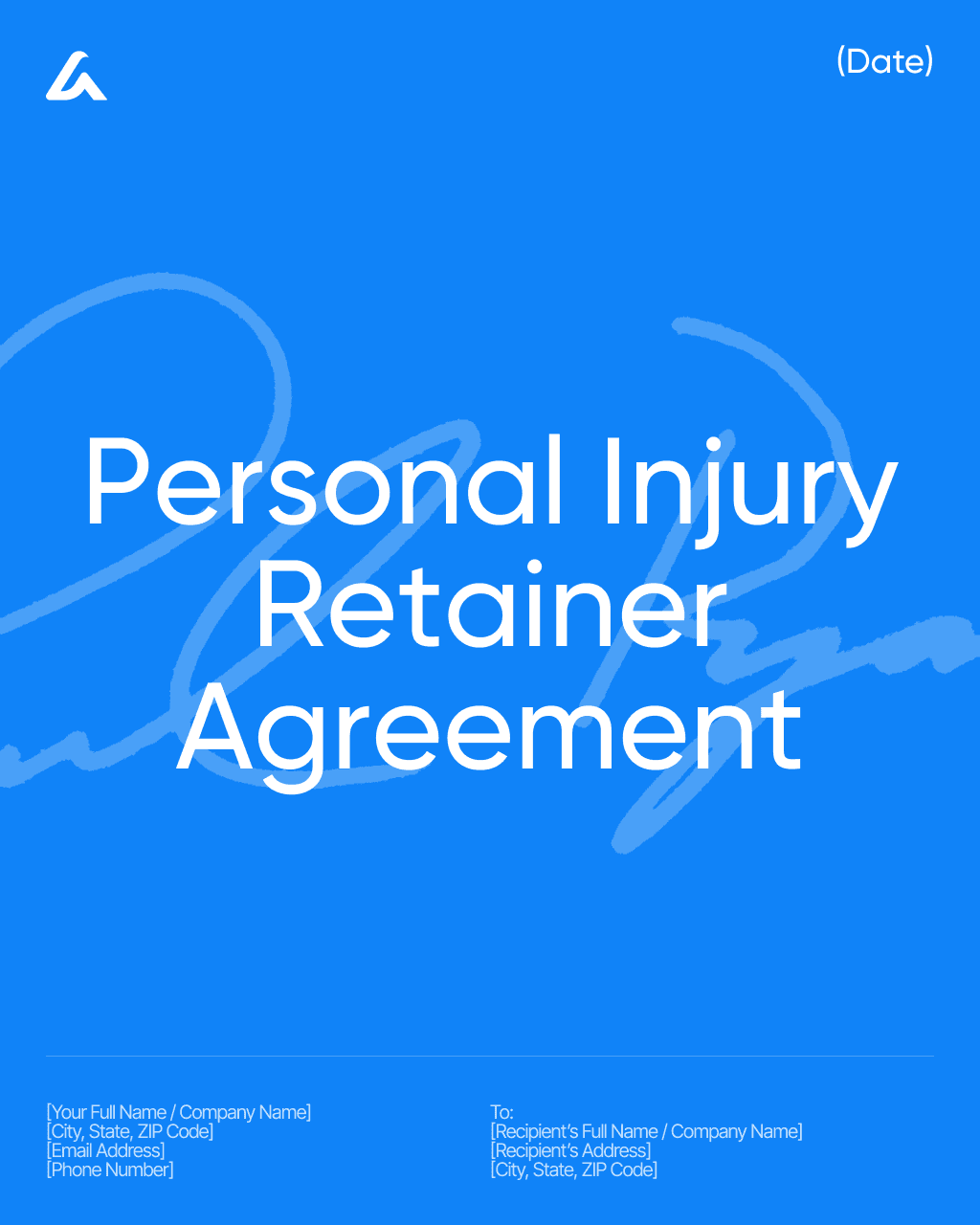
A Personal Injury Retainer Agreement is a legally binding contract between a client and a personal injury attorney that outlines the terms of legal representation for an injury claim. This agreement specifies the responsibilities of both the attorney and the client, the scope of legal services, how fees will be calculated, and how costs will be handled throughout the case. Its purpose is to ensure transparency, protect both parties, and establish a clear understanding of expectations before legal work begins.
Using a standardized Personal Injury Retainer Agreement template ensures that all essential elements are included—such as the attorney’s contingency fee percentage, conditions under which fees are owed, litigation costs (medical records, court fees, expert witnesses), client obligations (providing documents, attending appointments), termination clauses, confidentiality, and how settlement funds will be distributed. The template may also spell out the attorney’s authority to negotiate, handle communications with insurers, and file legal actions if necessary. AI-powered tools like AI Lawyer help clients and attorneys generate clear, fair, and legally compliant retainer agreements that reduce misunderstandings, support ethical representation, and provide a solid foundation for handling personal injury claims efficiently.
Download Template: Personal Injury Retainer Agreement
For more information please refer to our article: Injury Report Templates: OSHA-Ready Forms, Examples & Step-by-Step Reporting Guide
Or create your own document yourself with the help of AI.
1.65 Personal Injury Settlement Sheet

A Personal Injury Settlement Sheet is a detailed document used to summarize all financial components of a personal injury settlement, providing a clear breakdown of how the total settlement amount is calculated and distributed. It is commonly used by attorneys, insurance adjusters, mediators, and clients to review settlement terms and verify that all medical bills, legal fees, liens, and other expenses have been properly accounted for. Its purpose is to ensure transparency, prevent disputes, and create a final record of how settlement funds are allocated.
Using a standardized Personal Injury Settlement Sheet template ensures that every important category is clearly documented—such as the total settlement amount, attorney fees (usually contingency-based), case expenses (medical records, filing fees, expert witnesses), medical bills and liens, insurance reimbursements, lost wages, and the client’s final net recovery. The template may also include payment instructions, lienholder contact information, outstanding balances, and signatures confirming approval of the settlement distribution. AI-powered tools like AI Lawyer help attorneys and clients generate accurate, well-organized, and legally compliant settlement sheets that simplify the review process and reduce the risk of errors or omissions, resulting in a transparent and reliable financial summary for finalizing the case.
Download Template: Personal Injury Settlement Sheet
For more information please refer to our article: Injury Report Templates: OSHA-Ready Forms, Examples & Step-by-Step Reporting Guide
Or create your own document yourself with the help of AI.
1.66 Prescription and Medication Expense Log
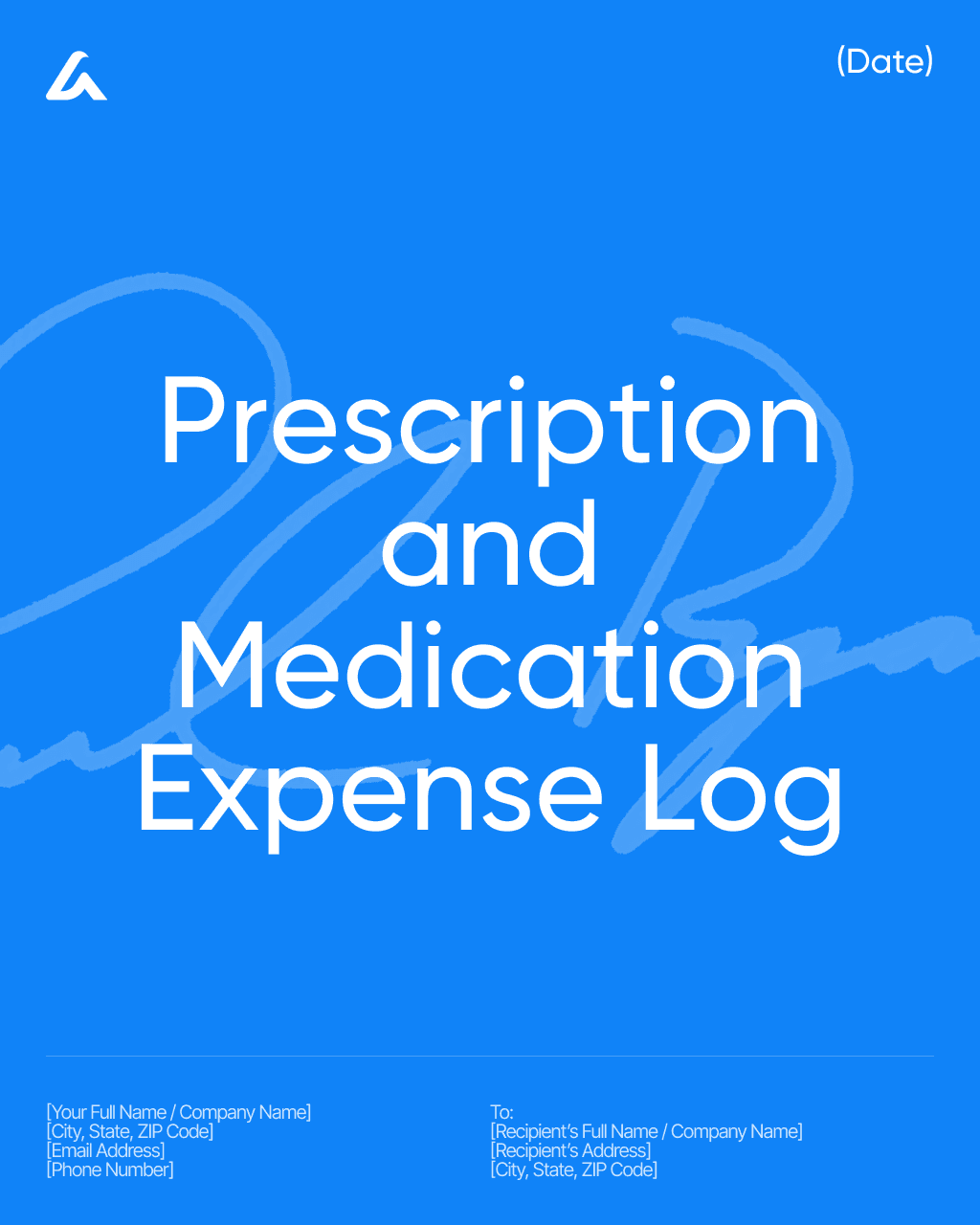
A Prescription and Medication Expense Log is a structured tracking document used to record all costs related to prescription drugs and over-the-counter medications associated with an illness, injury, chronic condition, or ongoing treatment. This log is especially important in personal injury cases, health insurance claims, tax deductions, disability applications, and budgeting for long-term medical care. Its purpose is to provide a clear financial record of medication-related expenses so that individuals, attorneys, insurers, or accountants can accurately calculate total costs, seek reimbursement, or support claims for compensation or benefits.
Using a standardized Prescription and Medication Expense Log template ensures that all relevant details are consistently documented—such as the date of each purchase, medication name and dosage, prescribing provider, pharmacy or supplier, quantity purchased, cost per fill, insurance payments, co-pays, out-of-pocket amounts, and any recurring refill schedules. The template may also include fields for linking each medication to a specific condition or case, noting side effects that required additional care, and summarizing monthly or annual totals. AI-powered tools like AI Lawyer help users generate clear, organized, and calculation-ready logs that minimize errors, prevent missed entries, and align with insurance, tax, and legal documentation standards. This results in a reliable financial record that strengthens reimbursement requests, supports legal damages, and gives a transparent view of medication-related expenses over time.
Download Template: Prescription and Medication Expense Log
For more information please refer to our article: Injury Report Templates: OSHA-Ready Forms, Examples & Step-by-Step Reporting Guide
Or create your own document yourself with the help of AI.
1.67 Product-Related Injury Report
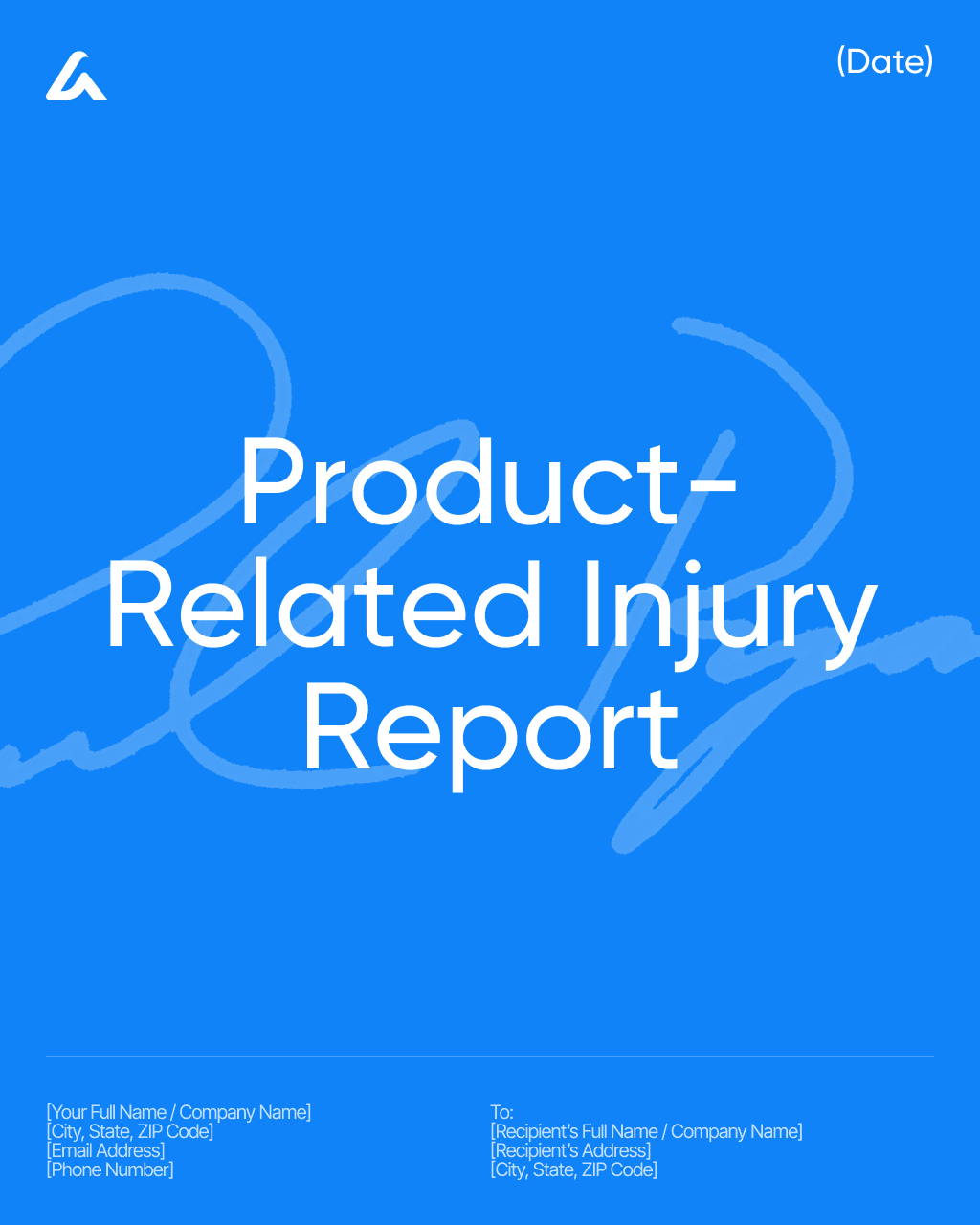
A Product-Related Injury Report is a formal document used to record injuries caused by a consumer product, equipment, appliance, tool, toy, medical device, or any other manufactured item. This report is commonly required by manufacturers, retailers, insurers, attorneys, safety regulators, and product-liability investigators. Its purpose is to document the incident, identify the defective or hazardous product, describe how the injury occurred, and provide evidence that may support warranty claims, recalls, insurance coverage, or legal action.
Using a standardized Product-Related Injury Report template ensures that all essential information is captured—such as product name, model/serial number, manufacturer, purchase date, circumstances of use, description of the defect or malfunction, injury details, witness accounts, photos, and medical treatment received. The template may also include fields for attaching receipts, packaging images, safety warnings, and expert evaluations. AI-powered tools like AI Lawyer help individuals and organizations create clear, organized, and legally compliant injury reports that strengthen claims, support investigations, and improve product-safety documentation. This results in a reliable record that can be used for insurance claims, product liability cases, or reporting to consumer-safety agencies.
Download Template: Product-Related Injury Report
For more information please refer to our article: Injury Report Templates: OSHA-Ready Forms, Examples & Step-by-Step Reporting Guide
Or create your own document yourself with the help of AI.
1.68 Proof of Injury Form
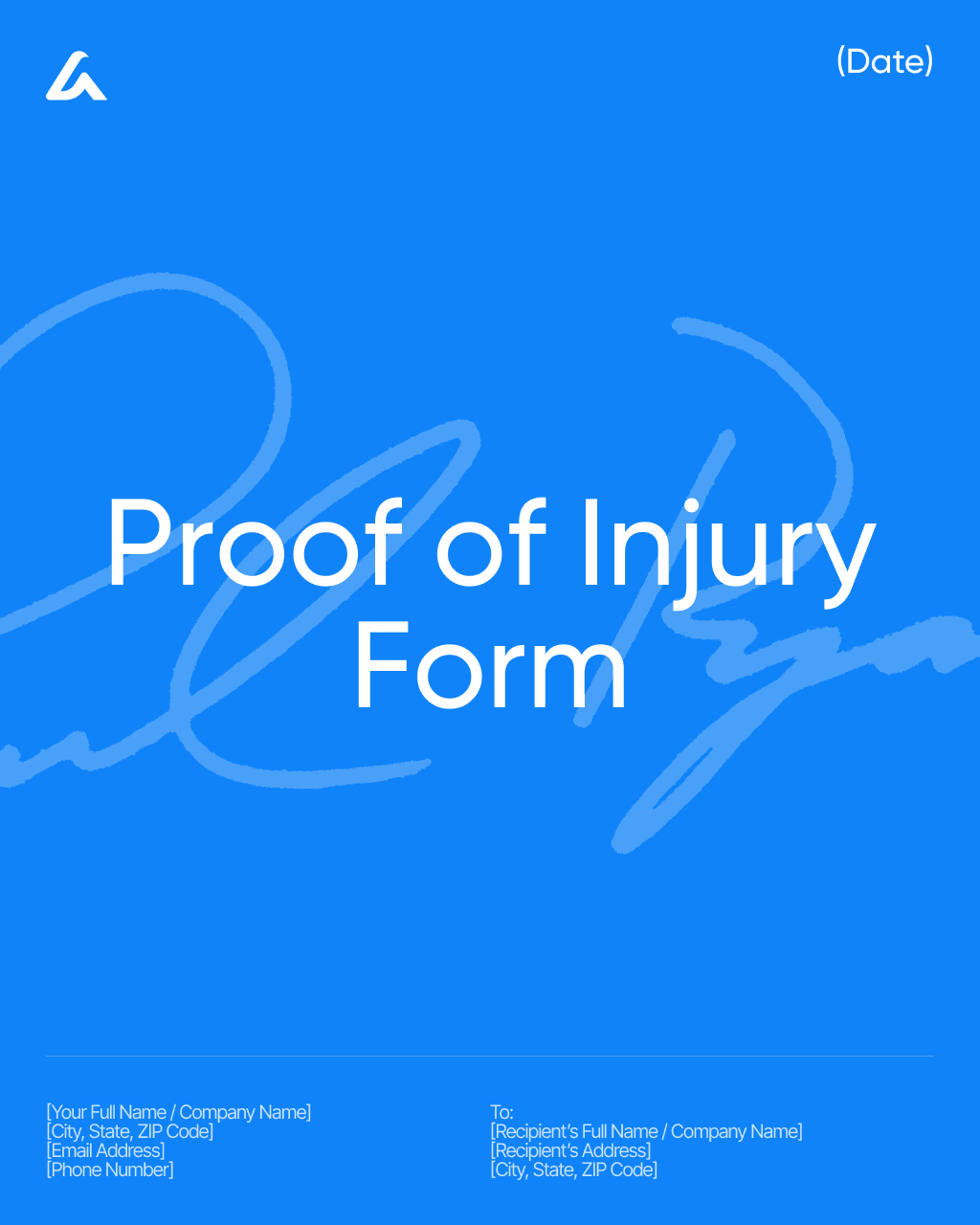
A Proof of Injury Form is an official document used to verify that an individual sustained a specific injury and to provide the factual and medical details necessary for insurance claims, workers’ compensation cases, legal actions, disability applications, or employer reporting requirements. Its purpose is to create a clear, credible record that links the injury to a particular event, documents the extent of harm, and confirms that medical evaluation or treatment occurred.
Using a standardized Proof of Injury Form template ensures that all essential information is included—such as the injured person’s name and contact details, date and location of the incident, description of how the injury occurred, type and severity of injuries, initial symptoms, medical diagnosis, treatment received, restrictions or limitations, and the healthcare provider’s certification. The template may also include sections for witness statements, photographs, employer notes (if work-related), and declarations affirming the accuracy of the information. AI-powered tools like AI Lawyer help individuals, employers, and professionals produce clear, accurate, and compliant forms that support claims processing, reduce disputes, and provide strong documentation for insurance or legal review.
Download Template: Proof of Injury Form
For more information please refer to our article: Injury Report Templates: OSHA-Ready Forms, Examples & Step-by-Step Reporting Guide
Or create your own document yourself with the help of AI.
1.69 Rehabilitation Plan

A Rehabilitation Plan is a structured, goal-oriented document that outlines the specific therapies, treatments, supports, and milestones an individual will follow to recover from an injury, illness, surgery, substance use issue, or other disabling condition. It is commonly used by doctors, physical therapists, occupational therapists, mental health professionals, case managers, and legal or insurance stakeholders to coordinate care and track progress over time. The purpose of a rehabilitation plan is to restore as much function and independence as possible, reduce pain or impairment, and support the person’s safe return to work, school, daily activities, or community life.
Using a standardized Rehabilitation Plan template ensures that all key elements are clearly organized—such as diagnosis and medical background, functional limitations, short-term and long-term goals, recommended therapies (physical therapy, occupational therapy, counseling, medications, assistive devices), session frequency, timelines, and measurable progress indicators. The template may also include sections for risk factors, home exercise programs, lifestyle modifications, patient responsibilities, and follow-up or review dates. AI-powered tools like AI Lawyer help professionals and individuals create clear, realistic, and well-documented rehabilitation plans that meet medical, insurance, and legal requirements, resulting in a practical roadmap that supports recovery, accountability, and coordinated care.
Download Template: Rehabilitation Plan
For more information please refer to our article: Injury Report Templates: OSHA-Ready Forms, Examples & Step-by-Step Reporting Guide
Or create your own document yourself with the help of AI.
1.70 Rehabilitation Tracking Log
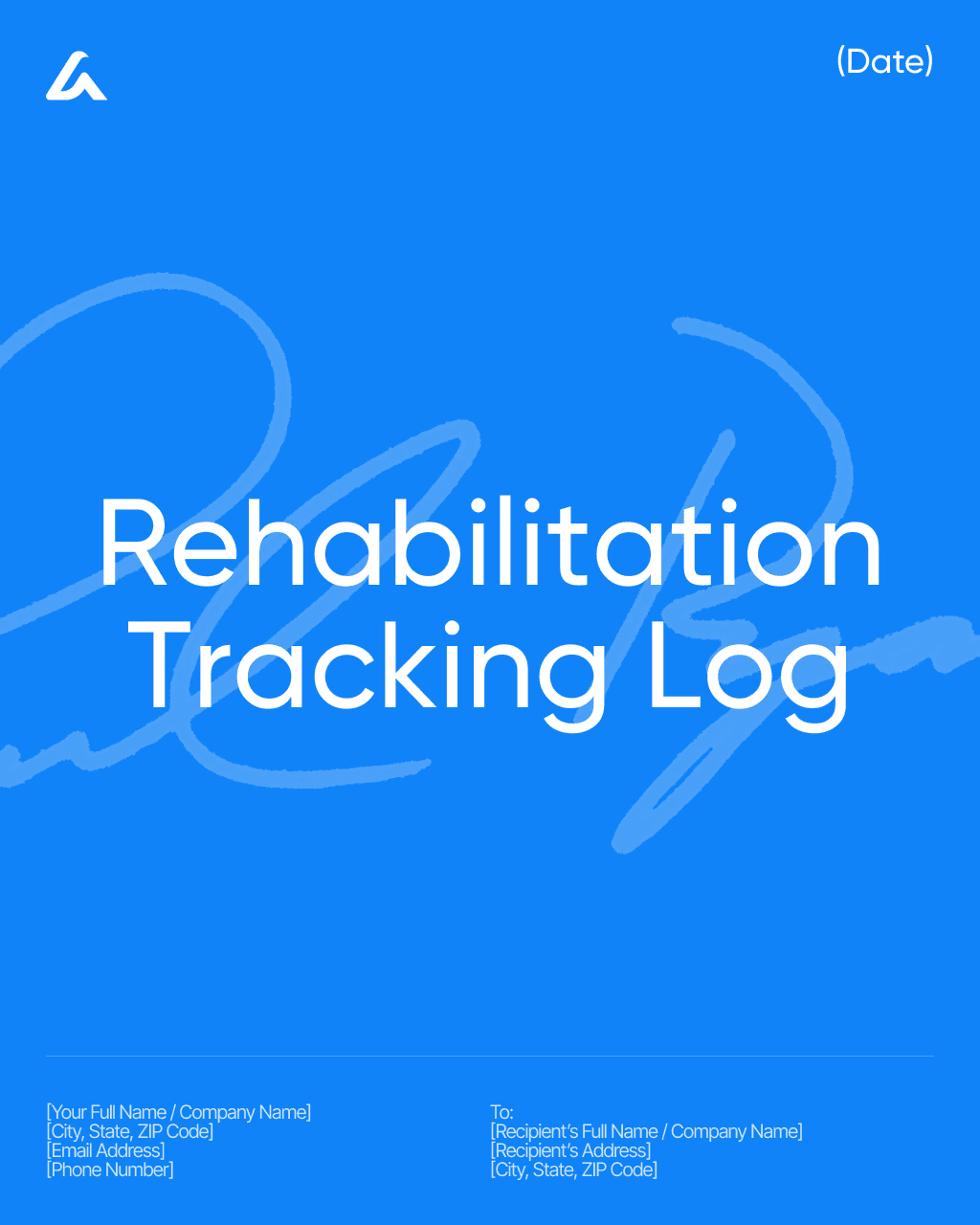
A Rehabilitation Tracking Log is a structured document used to monitor an individual’s progress throughout a rehabilitation program following an injury, illness, surgery, or physical/mental health condition. It helps medical providers, therapists, case managers, insurers, and the individual themselves track adherence to the rehabilitation plan, identify improvements or setbacks, and adjust treatment as needed. Its purpose is to create a day-by-day or session-by-session record that ensures consistency, accountability, and clear communication between all parties involved in recovery.
Using a standardized Rehabilitation Tracking Log template ensures that all relevant information is recorded—such as session dates, types of therapy performed, exercises completed, pain levels, range-of-motion measurements, functional gains, mobility status, assistive device usage, medication changes, and therapist or patient notes. The template may also include sections for goals achieved, challenges encountered, missed sessions, and upcoming tasks. AI-powered tools like AI Lawyer help individuals and professionals generate clear, organized, and compliant tracking logs that support insurance reviews, strengthen medical documentation, and improve the accuracy of progress assessments. This results in a reliable, structured record that enhances communication, guides treatment decisions, and helps demonstrate rehabilitation progress over time.
Download Template: Rehabilitation Tracking Log
For more information please refer to our article: Injury Report Templates: OSHA-Ready Forms, Examples & Step-by-Step Reporting Guide
Or create your own document yourself with the help of AI.
1.71 Settlement Agreement (Personal Injury)

A Settlement Agreement (Personal Injury) is a legally binding contract that resolves a personal injury claim without the need for a trial. It outlines the compensation amount, payment terms, release of liability, and all conditions agreed upon by the injured party and the at-fault party (or their insurer). Its purpose is to finalize the dispute, prevent future legal claims related to the incident, and ensure both sides fully understand their rights and obligations under the agreement.
Using a standardized Settlement Agreement (Personal Injury) template ensures that all critical provisions are clearly included—such as the settlement amount, payment schedule, scope of the release, indemnification clauses, confidentiality terms (if applicable), medical liens or reimbursements, tax considerations, and dismissal of pending claims. The template may also specify that the settlement is a full and final resolution of all injuries and damages arising from the incident. AI-powered tools like AI Lawyer help parties generate precise, enforceable, and jurisdiction-compliant settlement agreements that minimize disputes, clarify expectations, and protect the legal interests of all involved. This results in a clear, professional contract that supports efficient case closure and avoids unnecessary litigation.
Download Template: Settlement Agreement (Personal Injury)
For more information please refer to our article: Injury Report Templates: OSHA-Ready Forms, Examples & Step-by-Step Reporting Guide
Or create your own document yourself with the help of AI.
1.72 Sports Injury Report
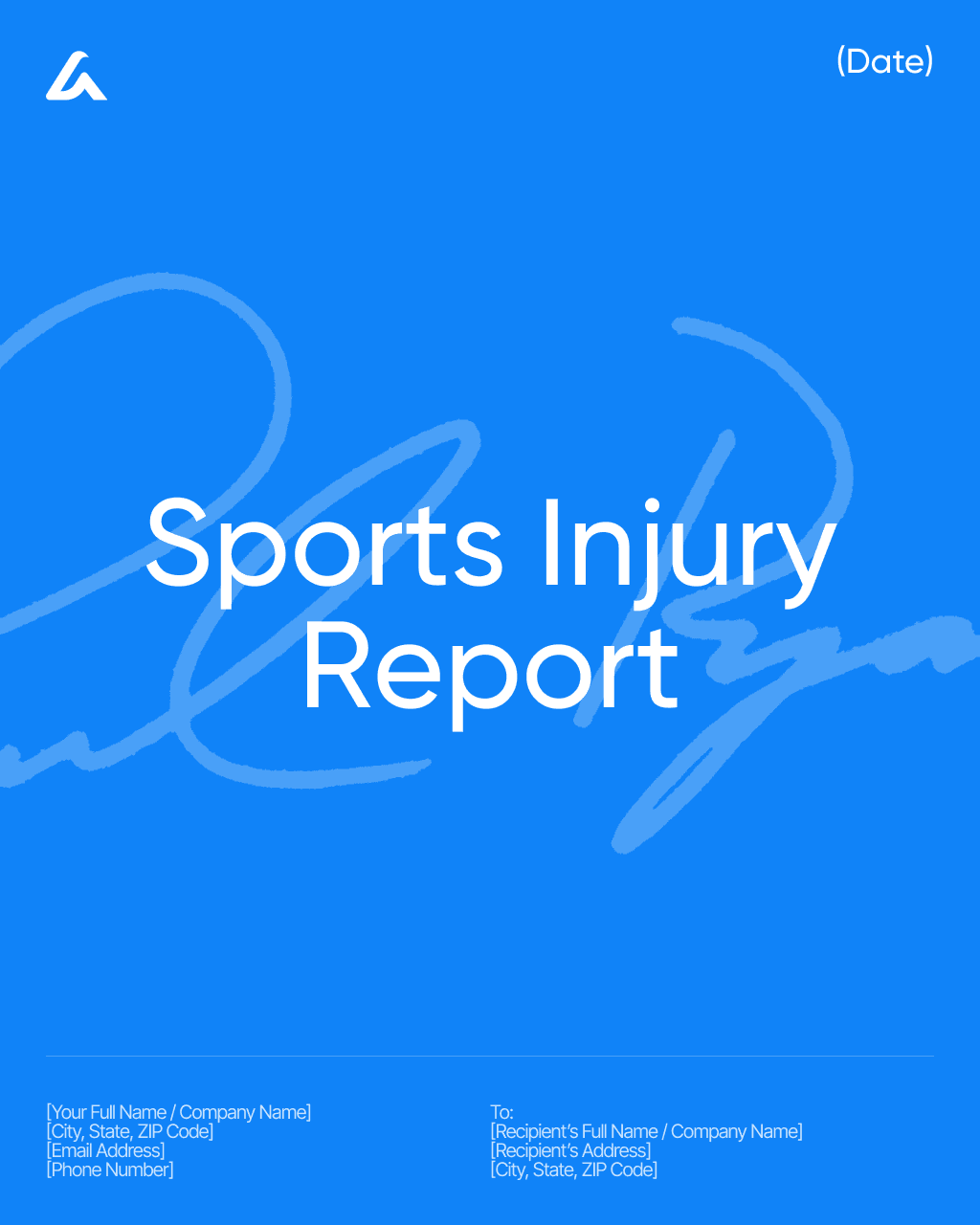
A Sports Injury Report is a formal document used to record injuries that occur during athletic activities, practices, games, training sessions, or fitness programs. Schools, sports clubs, gyms, coaches, trainers, and medical staff rely on these reports to document the circumstances of an injury, identify contributing factors, and ensure appropriate follow-up care. Its purpose is to create a clear, factual account that supports medical evaluation, parental notification, safety reviews, insurance claims, and—if needed—legal or administrative action.
Using a standardized Sports Injury Report template ensures that all essential information is captured—such as the athlete’s identity, age, team or program, date and time of injury, exact location, type of activity, mechanism of injury (e.g., collision, fall, overuse), protective equipment used, environmental conditions, witness accounts, and immediate first aid or medical response. The template may also include body diagrams, severity classifications, coach or trainer statements, photos, and recommendations for return-to-play protocols. AI-powered tools like AI Lawyer help organizations create accurate, thorough, and compliant injury reports that improve safety practices, reduce liability, and support timely medical care. This results in a reliable, detailed record that benefits athletes, families, staff, and administrators.
Download Template: Sports Injury Report
For more information please refer to our article: Injury Report Templates: OSHA-Ready Forms, Examples & Step-by-Step Reporting Guide
Or create your own document yourself with the help of AI.
1.73 Third-Party Injury Report
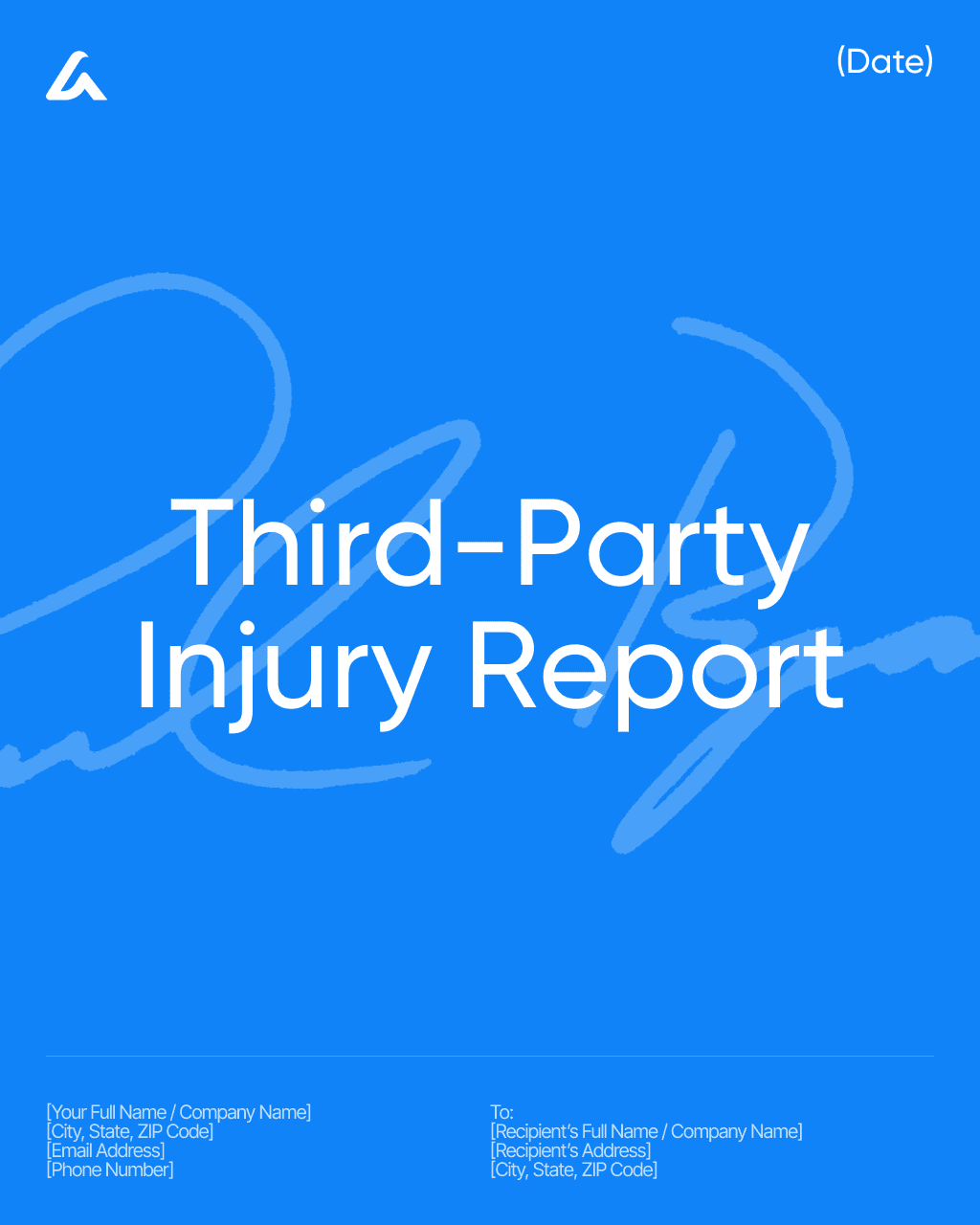
A Third-Party Injury Report is a formal document used to record an incident in which someone who is not an employee, student, or regular participant of an organization (for example, a visitor, customer, contractor, or passerby) is injured on the premises or as a result of the organization’s activities. Businesses, landlords, schools, event organizers, and public entities use this report to document what happened, where and when it occurred, who was involved, and what injuries were sustained. Its purpose is to create an accurate record for insurance claims, liability assessments, internal investigations, and potential legal proceedings, while also supporting safety improvements.
Using a standardized Third-Party Injury Report template ensures that all essential information is consistently captured—such as the injured person’s identity and contact details, date, time, and location of the incident, environmental conditions, detailed description of how the injury occurred, observed injuries, witness statements, photos or diagrams of the scene, and any immediate response or first aid provided. The template may also include sections for staff or management comments, contributing hazards (wet floors, damaged equipment, poor lighting), follow-up actions, and confirmation that the injured person was informed of available medical or reporting options. AI-powered tools like AI Lawyer help organizations generate clear, thorough, and compliant third-party injury reports that improve documentation quality, support fair handling of claims, and reduce liability risk through consistent, professional record-keeping.
Download Template: Third-Party Injury Report
For more information please refer to our article: Injury Report Templates: OSHA-Ready Forms, Examples & Step-by-Step Reporting Guide
Or create your own document yourself with the help of AI.
1.74 Workplace Injury Report
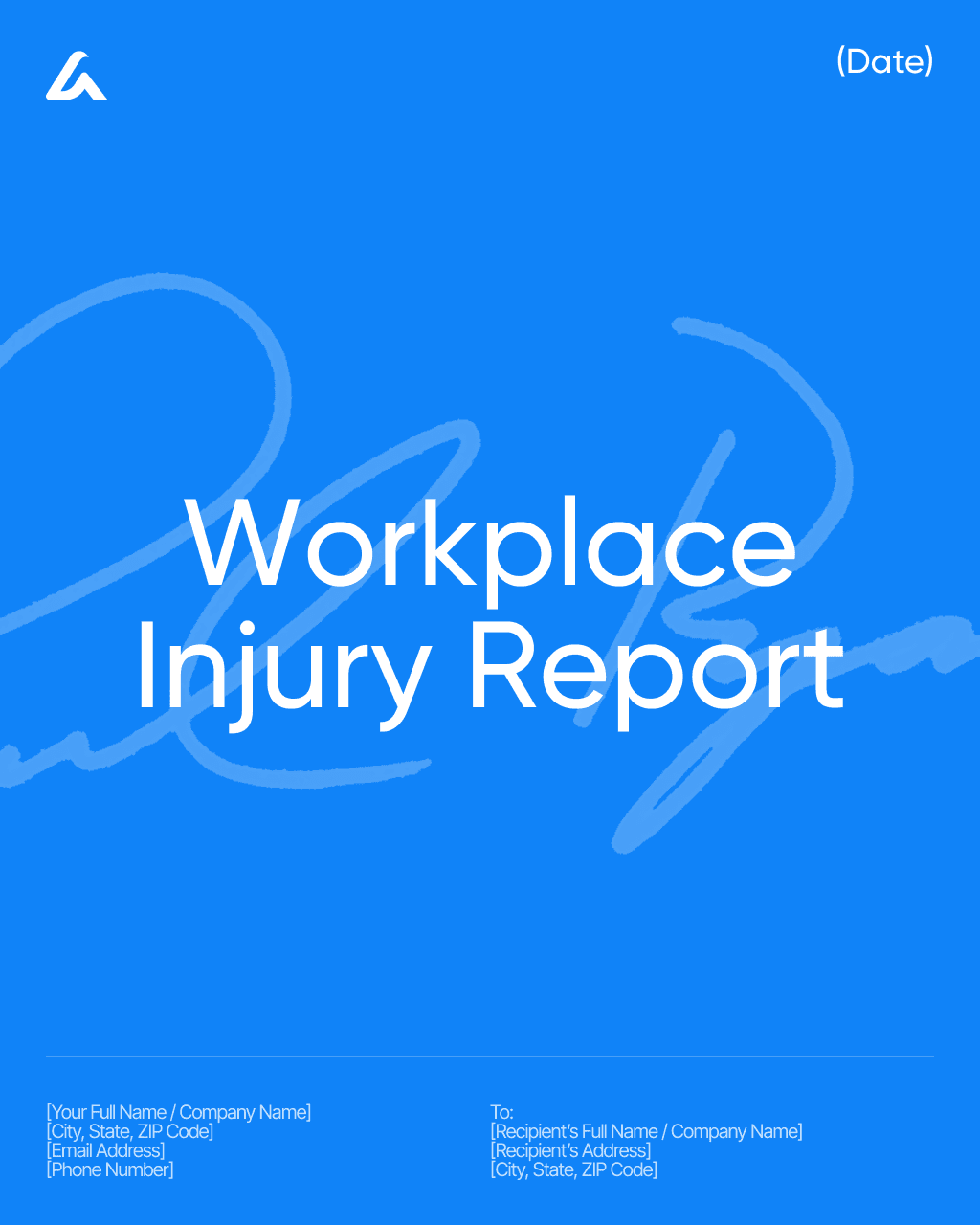
A Workplace Injury Report is a formal document used by employers, supervisors, and safety officers to record any injury or accident that occurs on the job. This report provides a detailed account of how the incident happened, what injuries were sustained, and what immediate actions were taken. Its purpose is to ensure proper medical response, support workers’ compensation claims, comply with OSHA or local regulatory requirements, identify workplace hazards, and reduce the risk of future incidents.
Using a standardized Workplace Injury Report template ensures that all critical information is documented—such as the employee’s identity and job title, date and time of the injury, exact location, task being performed, equipment involved, environmental conditions, witnesses, and the severity and nature of the injury. The template may also include sections for noting unsafe conditions, corrective action recommendations, photos or diagrams of the scene, supervisor statements, and signatures verifying the accuracy of the report. AI-powered tools like AI Lawyer help organizations create thorough, compliant, and professionally structured workplace injury reports that improve safety, support accurate claims processing, and protect both the employee and the employer through clear documentation.
Download Template: Workplace Injury Report
For more information please refer to our article: Injury Report Templates: OSHA-Ready Forms, Examples & Step-by-Step Reporting Guide
Or create your own document yourself with the help of AI.
1.75 OSHA Form 300 – Log of Work-Related Injuries and Illnesses Template
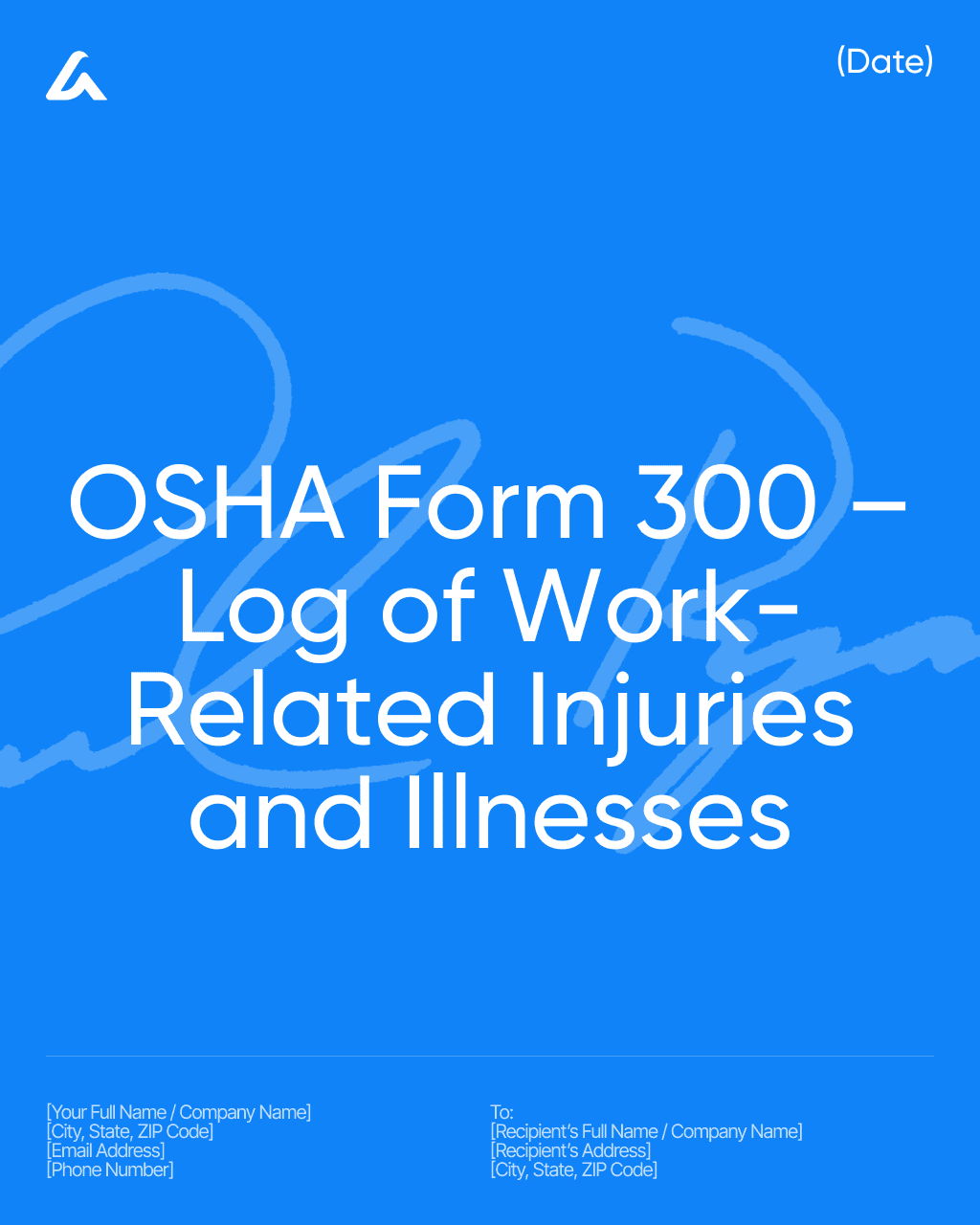
An OSHA Form 300 – Log of Work-Related Injuries and Illnesses Template is a standardized recordkeeping document required for many employers under OSHA regulations. Its purpose is to systematically log workplace injuries and illnesses that meet OSHA’s recording criteria, helping employers track safety trends, identify hazards, and comply with federal reporting requirements. The log provides an overview of each recordable incident, including the affected employee, the nature of the injury or illness, the location of the event, and the outcome (such as days away from work or restricted duties).
Using a standardized OSHA Form 300 template ensures that all legally required fields are captured accurately—such as case number, employee details (without revealing sensitive identifiers), incident description, classification of injury or illness, and days of lost or restricted work. The template may also include instructions for determining recordability, classifying event types, and maintaining privacy for sensitive cases. Employers must maintain and update the log throughout the year and post summaries annually. AI-powered tools like AI Lawyer help organizations produce compliant, well-organized OSHA logs that reduce administrative errors, support audits or inspections, and strengthen workplace safety documentation.
Download Template: OSHA Form 300 – Log of Work-Related Injuries and Illnesses Template
For more information please refer to our article: Injury Report Templates: OSHA-Ready Forms, Examples & Step-by-Step Reporting Guide
Or create your own document yourself with the help of AI.
1.76 OSHA Form 300A – Summary of Work-Related Injuries and Illnesses Template
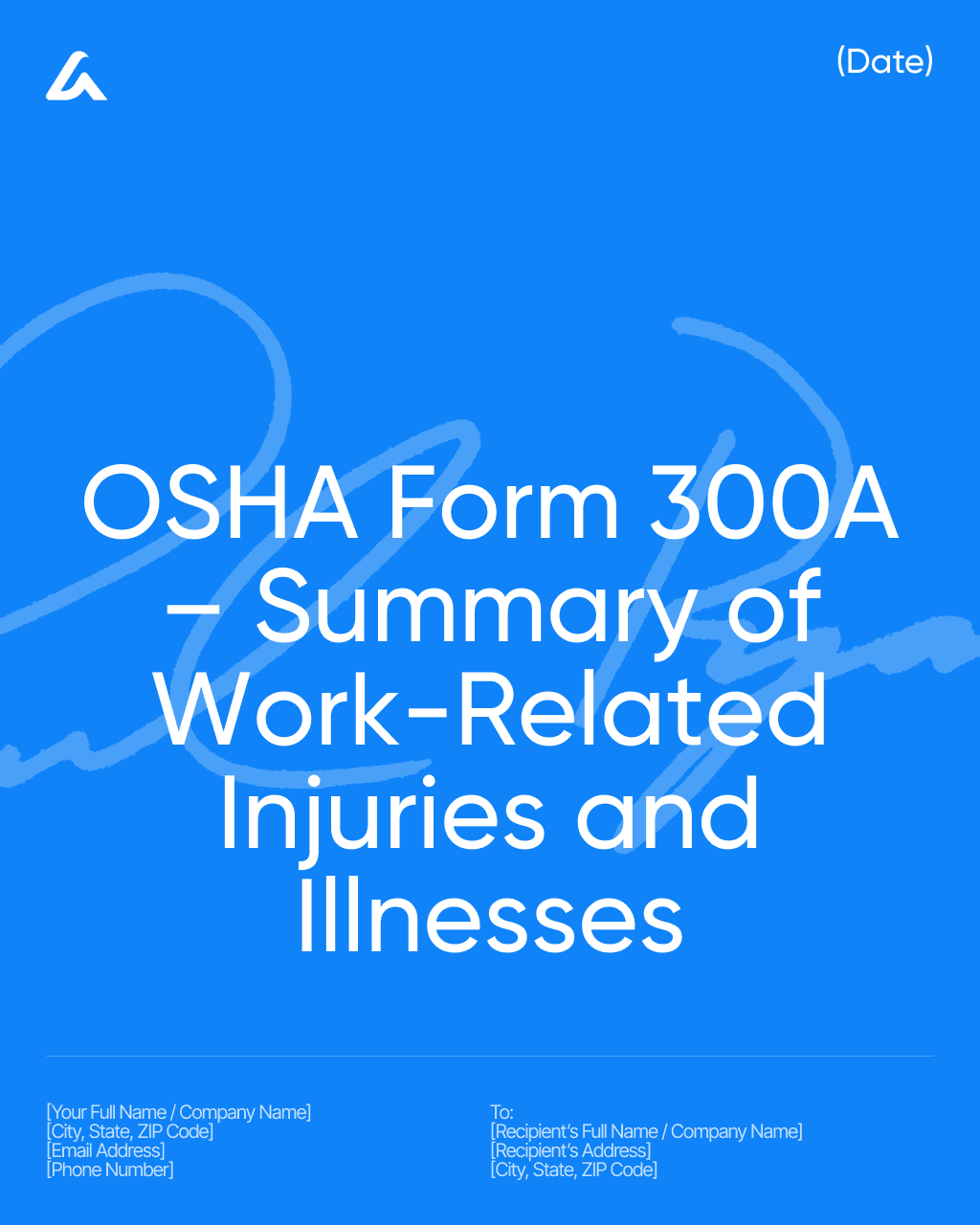
An OSHA Form 300A – Summary of Work-Related Injuries and Illnesses Template is a legally required document that compiles the annual totals from the OSHA Form 300 log. Unlike the detailed log, this summary does not list individual cases but instead presents aggregated data on workplace injuries and illnesses for the entire year. Employers must complete this summary, certify it, and publicly post it at the workplace each year to ensure transparency about workplace safety performance.
Using a standardized OSHA Form 300A template ensures accurate reporting of key annual metrics—such as total number of recordable cases, types of injuries or illnesses, days away from work, job transfer or restriction days, and employee hours worked. The template may also include fields for establishment information, industry classification, and required employer certifications. Employers must ensure the summary is posted in a visible location for employees from February 1 to April 30, and it must be retained for at least five years. AI-powered tools like AI Lawyer help organizations accurately prepare OSHA summaries, reduce compliance errors, and maintain clear records for regulatory audits or inspections.
Download Template: OSHA Form 300A – Summary of Work-Related Injuries and Illnesses Template
For more information please refer to our article: Injury Report Templates: OSHA-Ready Forms, Examples & Step-by-Step Reporting Guide
Or create your own document yourself with the help of AI.
1.77 OSHA Form 301 – Injury and Illness Incident Report Template
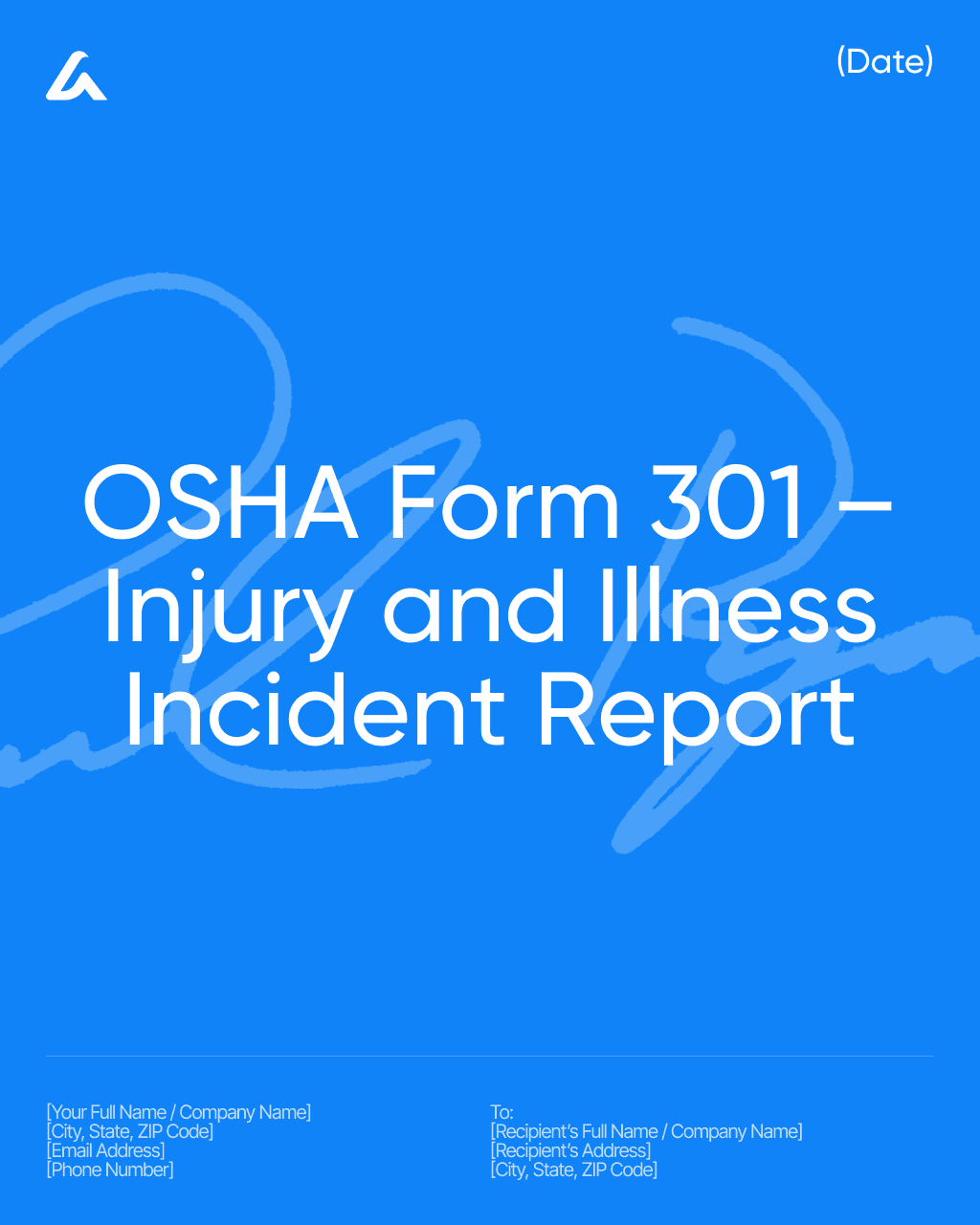
An OSHA Form 301 – Injury and Illness Incident Report Template is a detailed reporting document required by OSHA to record the specifics of each individual work-related injury or illness. For every case that appears on the OSHA Form 300 log, a corresponding OSHA 301 report must be completed. Its purpose is to capture in-depth information about what happened, how it happened, who was involved, and what medical treatment was provided. This form helps employers, regulators, insurers, and safety professionals investigate incidents, identify workplace hazards, and prevent future occurrences.
Using a standardized OSHA Form 301 template ensures that all required fields are consistently documented—such as employee demographics, incident date and time, location of the event, detailed description of what occurred, body part(s) affected, type of injury or illness, and initial medical response. The template may also include fields for healthcare provider information, supervisor comments, and checkboxes for incident classification. Employers must complete this report within seven days of learning about a recordable incident and retain it as part of OSHA’s recordkeeping requirements for at least five years. AI-powered tools like AI Lawyer help organizations produce accurate, compliant, and well-organized incident reports that strengthen workplace safety documentation and support regulatory audits or insurance claims.
Download Template: OSHA Form 301 – Injury and Illness Incident Report Template
For more information please refer to our article: Injury Report Templates: OSHA-Ready Forms, Examples & Step-by-Step Reporting Guide
Or create your own document yourself with the help of AI.
1.78 OSHA Recordkeeping Policy and Procedure Template
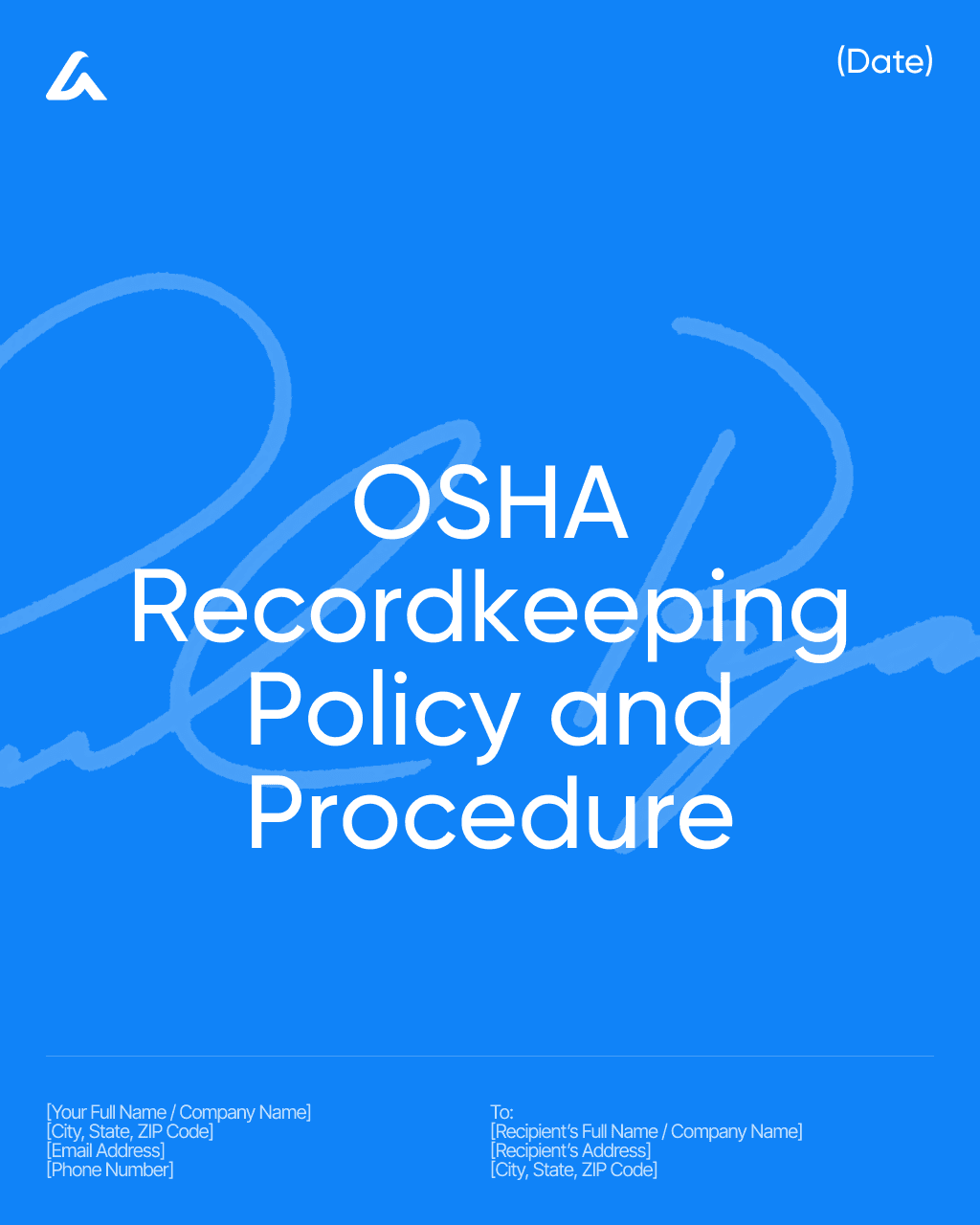
An OSHA Recordkeeping Policy and Procedure Template is an internal compliance document that outlines how an organization records, maintains, and reports workplace injuries and illnesses in accordance with OSHA’s regulatory requirements. Its purpose is to establish clear procedures for determining the recordability of incidents, completing OSHA Forms 300, 300A, and 301, preserving records for mandatory periods, and ensuring timely reporting of severe injuries, hospitalizations, amputations, or fatalities. This policy helps employers stay compliant, avoid costly penalties, and maintain a consistent, transparent safety documentation system.
Using a standardized OSHA Recordkeeping Policy and Procedure template ensures that all essential components are covered—such as definitions of key terms (recordable injury, restricted work, medical treatment, etc.), step-by-step instructions for completing required OSHA forms, roles and responsibilities of supervisors and safety personnel, timelines for reporting, privacy case procedures, and rules for electronic submission to OSHA (where applicable). The template may also include detailed guidance on incident classification, employee notification rights, retention schedules, and audit procedures to verify compliance. AI-powered tools like AI Lawyer help organizations create comprehensive, compliant, and easy-to-follow OSHA recordkeeping policies that reduce errors, strengthen workplace safety programs, and ensure readiness for inspections or regulatory reviews.
Download Template: OSHA Recordkeeping Policy and Procedure Template
For more information please refer to our article: Injury Report Templates: OSHA-Ready Forms, Examples & Step-by-Step Reporting Guide
Or create your own document yourself with the help of AI.
1.79 Cal/OSHA Form 300 – Log of Work-Related Injuries and Illnesses Template
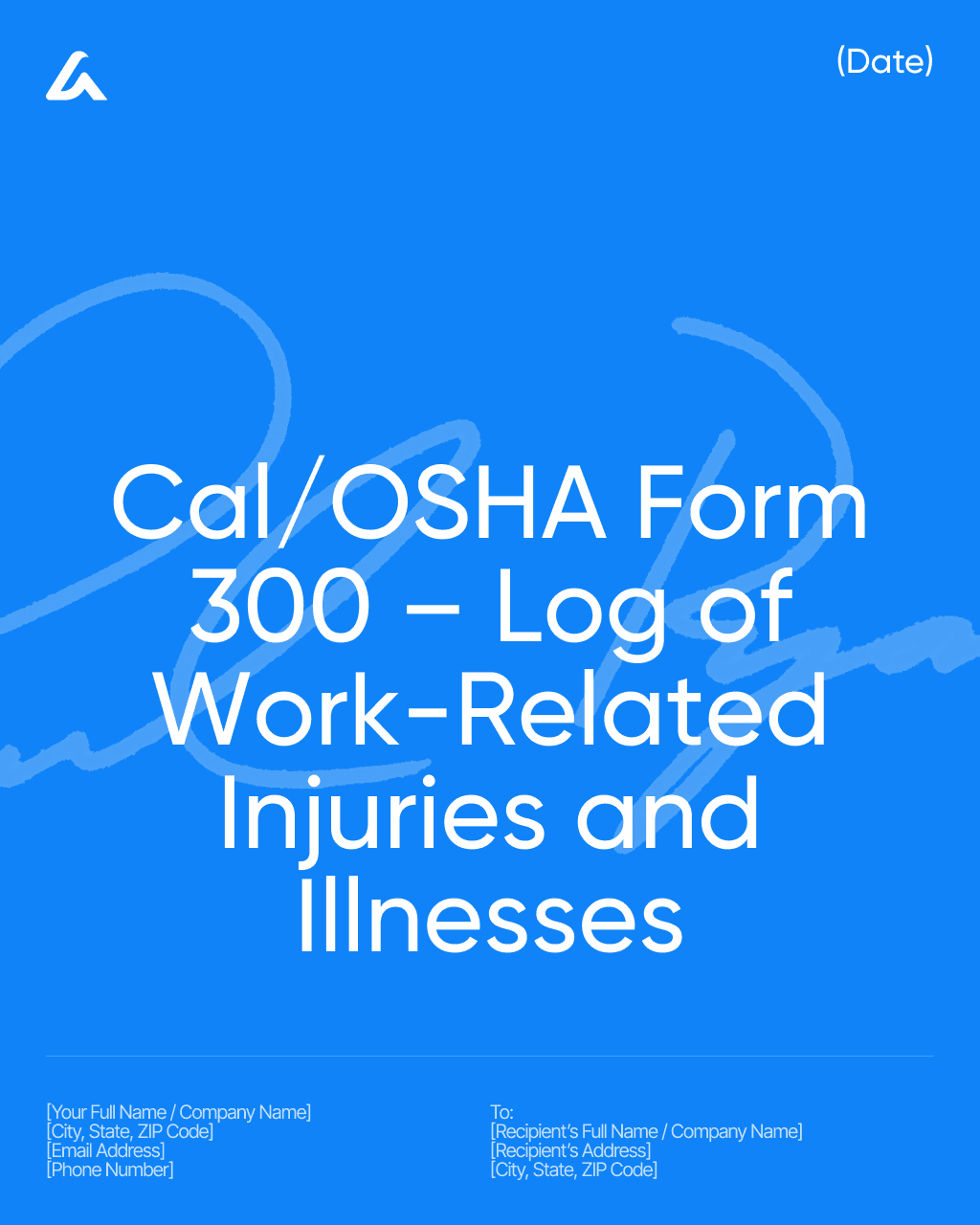
A Cal/OSHA Form 300 – Log of Work-Related Injuries and Illnesses Template is a required recordkeeping document used by employers in California to track workplace injuries and illnesses that meet Cal/OSHA’s recording criteria. While similar to the federal OSHA Form 300, the Cal/OSHA version includes state-specific requirements and definitions. Its purpose is to document all recordable incidents, identify workplace safety trends, support accident prevention efforts, and ensure compliance with California’s stringent occupational safety regulations.
Using a standardized Cal/OSHA Form 300 template ensures that employers accurately record each reportable case—including details about the employee involved, the type and severity of the injury or illness, the location and nature of the incident, and the number of days away from work or on restricted duty. The template may also include California-specific reporting guidelines, classification instructions, and fields for maintaining privacy for sensitive cases. Employers are required to update the log throughout the year, post annual summaries, and retain records for at least five years. AI-powered tools like AI Lawyer help businesses prepare compliant, well-organized Cal/OSHA logs that reduce recordkeeping errors, support state audits or inspections, and strengthen workplace safety documentation.
Download Template: Cal/OSHA Form 300 – Log of Work-Related Injuries and Illnesses Template
For more information please refer to our article: Injury Report Templates: OSHA-Ready Forms, Examples & Step-by-Step Reporting Guide
Or create your own document yourself with the help of AI.
1.80 Cal/OSHA Form 300A – Summary of Work-Related Injuries and Illnesses Template
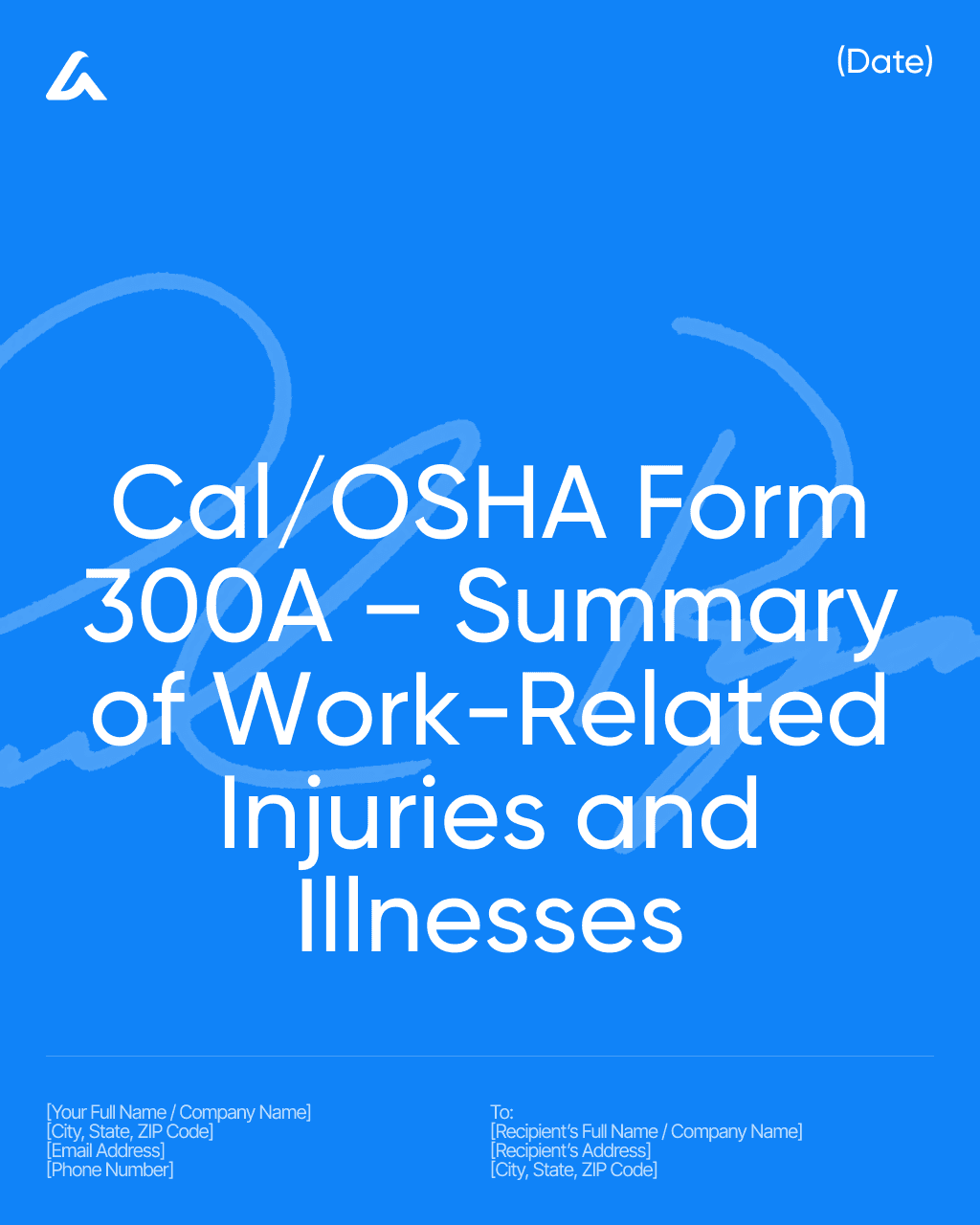
A Cal/OSHA Form 300A – Summary of Work-Related Injuries and Illnesses Template is a mandatory annual reporting document for California employers, used to summarize the total number of recordable workplace injuries and illnesses documented on the Cal/OSHA Form 300 log. Unlike the detailed log, this summary provides aggregated data only, giving employees a clear overview of safety performance for the previous year. Employers must complete, certify, and publicly post this summary each year to comply with Cal/OSHA regulations.
Using a standardized Cal/OSHA Form 300A template ensures accurate reporting of required information—including total cases, types of injuries or illnesses, days away from work, job transfer or restriction days, total hours worked, and establishment details. The template may incorporate California-specific guidelines, instructions for calculating totals, and requirements for privacy protections. Employers must post the completed form in a visible location from February 1 through April 30 and retain the summary for at least five years. AI-powered tools like AI Lawyer help organizations prepare fully compliant summaries, avoid reporting errors, and maintain clear and organized documentation for state audits or inspections.
Download Template: Cal/OSHA Form 300A – Summary of Work-Related Injuries and Illnesses Template
For more information please refer to our article: Injury Report Templates: OSHA-Ready Forms, Examples & Step-by-Step Reporting Guide
Or create your own document yourself with the help of AI.
1.81 Cal/OSHA Form 301 – Injury and Illness Incident Report Template
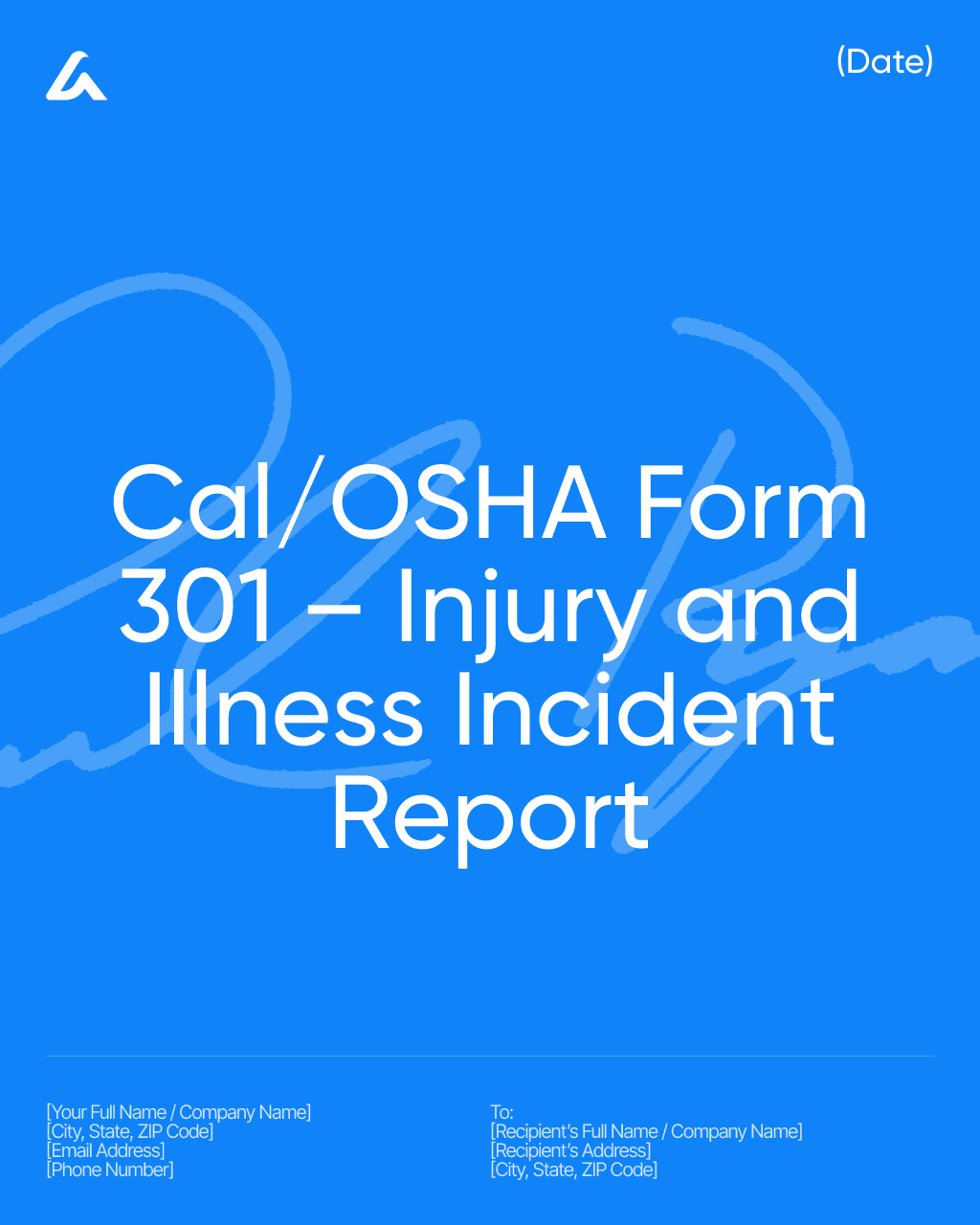
A Cal/OSHA Form 301 – Injury and Illness Incident Report Template is a detailed recordkeeping document required for each work-related injury or illness that must be logged under Cal/OSHA regulations. Similar to the federal OSHA Form 301 but tailored to California’s state-specific requirements, this report captures comprehensive information about the incident, including what happened, how it occurred, who was involved, and what medical treatment was provided. Its purpose is to support workplace investigations, identify safety hazards, document compliance, and assist with insurance and regulatory reporting.
Using a standardized Cal/OSHA Form 301 template ensures that all mandatory fields are completed consistently—such as employee information, incident date and time, exact location, detailed event description, affected body part(s), type of injury or illness, contributing factors, and initial medical response. The template may also include California-specific instructions, privacy protections for sensitive cases, and sections for supervisor comments or follow-up actions. Employers must complete the form within seven days of learning about a recordable incident and retain it for at least five years as part of Cal/OSHA’s recordkeeping requirements. AI-powered tools like AI Lawyer help organizations produce accurate, compliant, and well-organized incident reports that support safety audits, reduce liability risks, and improve hazard prevention efforts.
Download Template: Cal/OSHA Form 300A – Summary of Work-Related Injuries and Illnesses Template
For more information please refer to our article: Injury Report Templates: OSHA-Ready Forms, Examples & Step-by-Step Reporting Guide
Or create your own document yourself with the help of AI.
1.82 MIOSHA Form 300 – Log of Work-Related Injuries and Illnesses Template
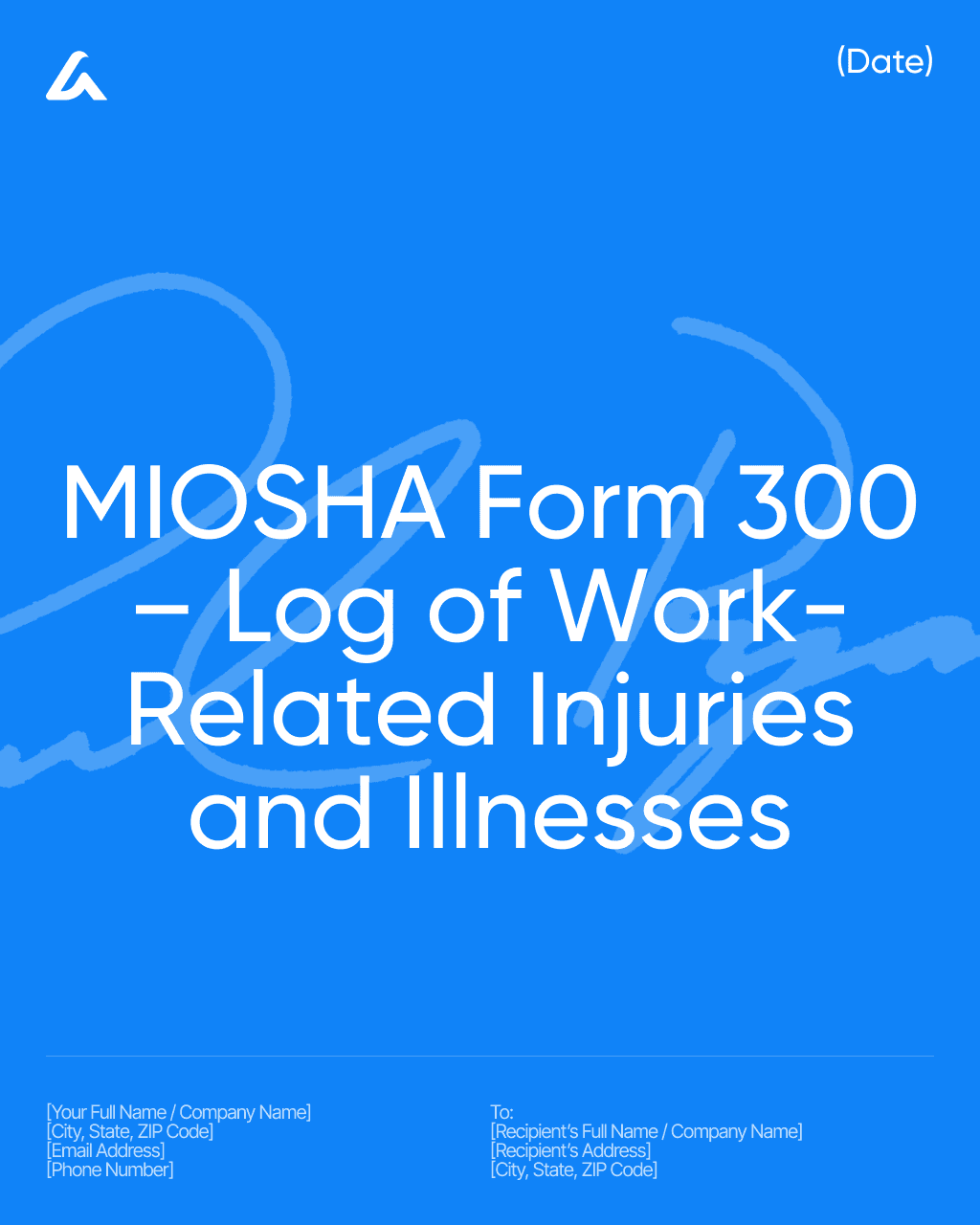
A MIOSHA Form 300 – Log of Work-Related Injuries and Illnesses Template is a required recordkeeping document used by employers in Michigan to track workplace injuries and illnesses that meet the state’s recording criteria. While similar to the federal OSHA Form 300, the MIOSHA version follows Michigan’s specific occupational safety regulations and reporting requirements. Its purpose is to document all recordable incidents, support workplace safety programs, identify hazards, and ensure compliance with MIOSHA’s recordkeeping standards.
Using a standardized MIOSHA Form 300 template ensures that all essential details are recorded accurately—such as employee information, a brief description of the incident, classification of injury or illness, days away from work or restricted duty, and where the event occurred. It may also include Michigan-specific definitions, instructions for determining recordability, and guidelines for maintaining privacy for sensitive cases. Employers are required to keep the log current throughout the year, post annual summaries, and retain all records for at least five years. AI-powered tools like AI Lawyer help organizations produce compliant, well-structured MIOSHA logs that reduce administrative errors, support audits or inspections, and strengthen workplace safety documentation.
Download Template: MIOSHA Form 300 – Log of Work-Related Injuries and Illnesses Template
For more information please refer to our article: Injury Report Templates: OSHA-Ready Forms, Examples & Step-by-Step Reporting Guide
Or create your own document yourself with the help of AI.
1.83 MIOSHA Form 300A – Summary of Work-Related Injuries and Illnesses Template
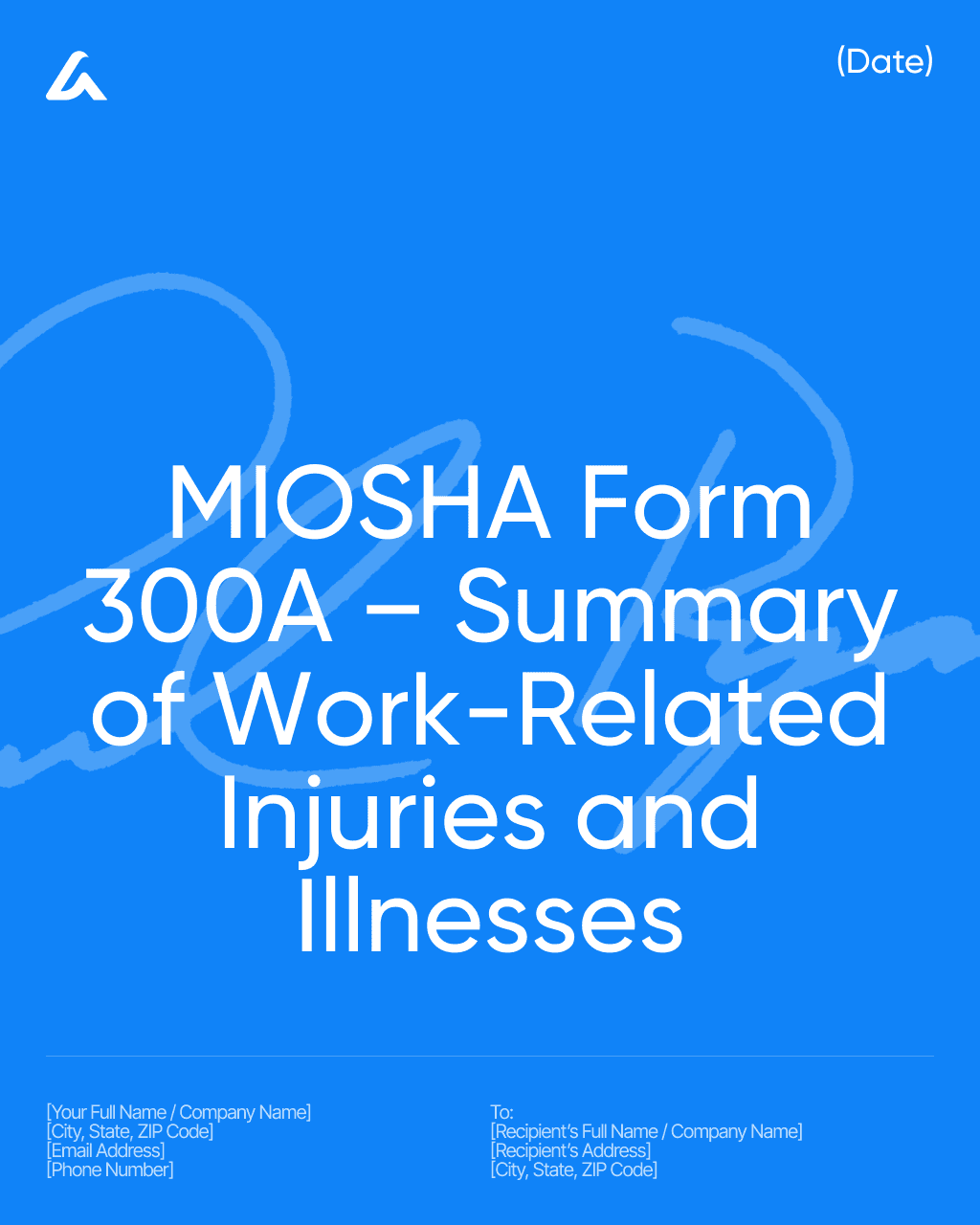
A MIOSHA Form 300A – Summary of Work-Related Injuries and Illnesses Template is an annual reporting document required for many Michigan employers. It provides a year-end summary of all work-related injuries and illnesses recorded on the MIOSHA Form 300 log. Unlike the detailed log, the 300A summary lists only total figures, offering employees and regulators a clear overview of workplace safety outcomes for the previous calendar year. Its purpose is to promote transparency, highlight safety performance, and ensure compliance with Michigan’s occupational safety requirements.
Using a standardized MIOSHA Form 300A template ensures accurate recording of the required totals—such as the number of injury cases, types of incidents, total days away from work, restricted duty days, establishment information, and total hours worked by all employees. The template may also include Michigan-specific instructions, guidance on calculating totals, and requirements for certifying the accuracy of the summary. Employers must post the completed summary in a visible location from February 1 through April 30 and retain it for at least five years. AI-powered tools like AI Lawyer help organizations prepare compliant, error-free summaries that support inspection readiness, improve safety reporting accuracy, and meet MIOSHA’s documentation standards.
Download Template: MIOSHA Form 300A – Summary of Work-Related Injuries and Illnesses Template
For more information please refer to our article: Injury Report Templates: OSHA-Ready Forms, Examples & Step-by-Step Reporting Guide
Or create your own document yourself with the help of AI.
1.84 MIOSHA Form 301 – Injury and Illness Incident Report Template
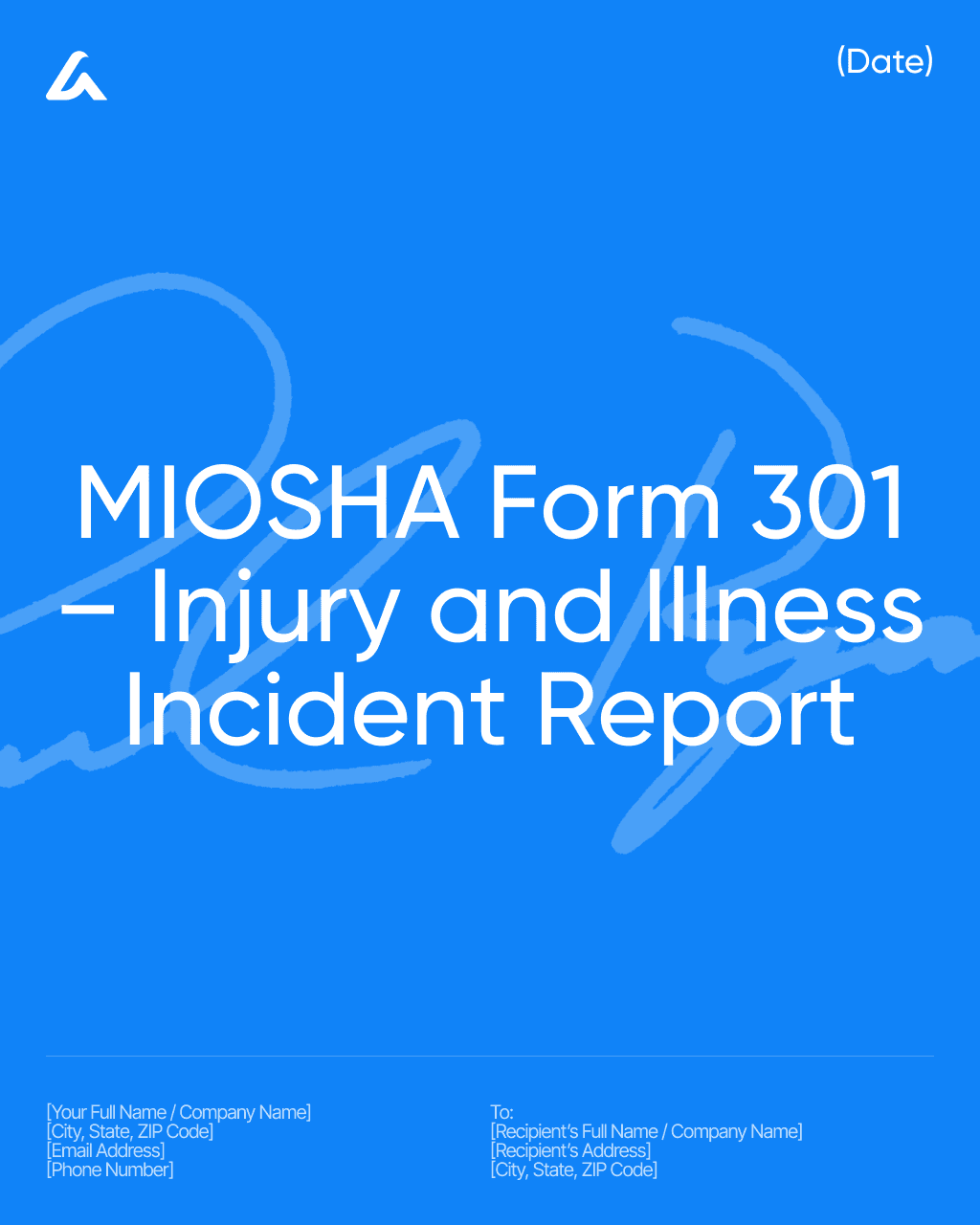
A MIOSHA Form 301 – Injury and Illness Incident Report Template is a detailed incident reporting document required for each recordable work-related injury or illness under Michigan’s occupational safety regulations. Similar to the federal OSHA Form 301 but aligned with MIOSHA requirements, this form captures essential information about how an incident occurred, the nature of the injury or illness, and the immediate response taken. Its purpose is to assist employers in conducting thorough workplace safety investigations, documenting compliance, and identifying patterns that may indicate hazardous conditions.
Using a standardized MIOSHA Form 301 template ensures that all required information is captured consistently—such as employee identification (with protections for privacy cases), incident date and time, exact location, detailed narrative of what happened, body part(s) affected, type of injury or illness, contributing factors, and initial medical treatment. The template may also include Michigan-specific guidance, supervisor comments, follow-up action fields, and instructions on proper retention. Employers must complete this form within seven days of learning about a recordable case and keep it on file for at least five years. AI-powered tools like AI Lawyer help organizations create clear, compliant, and well-organized incident reports that support MIOSHA inspections, strengthen workplace safety programs, and reduce liability risks.
Download Template: MIOSHA Form 301 – Injury and Illness Incident Report Template
For more information please refer to our article: Injury Report Templates: OSHA-Ready Forms, Examples & Step-by-Step Reporting Guide
Or create your own document yourself with the help of AI.
1.85 I-129 Petition for a Nonimmigrant Worker Cover Letter Template
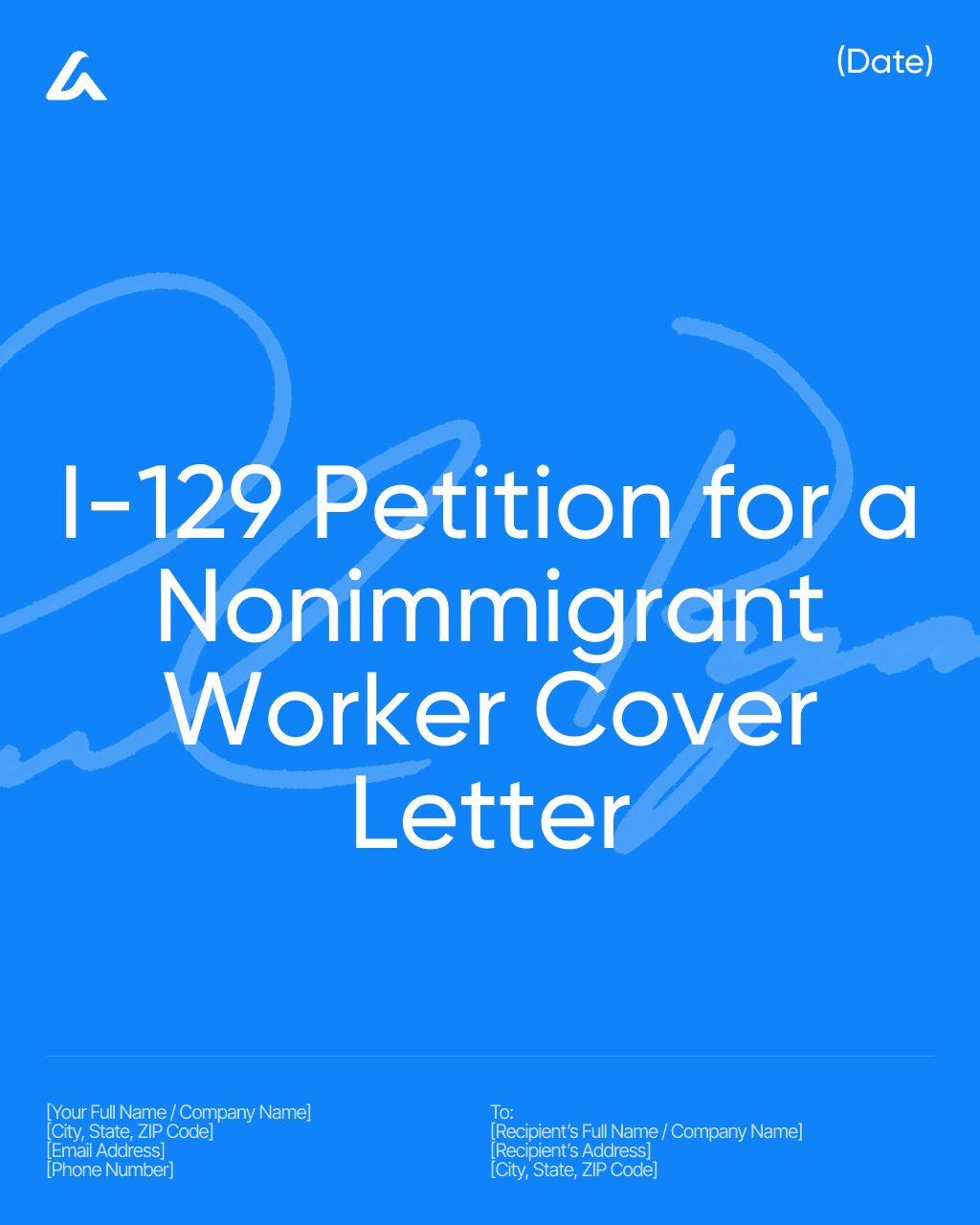
An I-129 Petition for a Nonimmigrant Worker Cover Letter is a professional summary document included at the front of an employer’s petition packet requesting a temporary employment-based visa for a foreign worker. This cover letter helps USCIS officers quickly understand the job offered, the worker’s qualifications, and the basis for the requested visa classification. It improves organization, reduces the risk of missing information, and supports efficient review of the petition. Employers commonly use it when filing for H-1B, L-1, O-1, P-1, TN, E-3, and other nonimmigrant visa categories.
Using a standardized I-129 Cover Letter template ensures that all essential details are clearly outlined—such as employer information, beneficiary information, visa category requested, job title and duties, wage information, and a detailed index of enclosed evidence. The template may also include legal citations, explanations of eligibility criteria, descriptions of the beneficiary’s specialized knowledge or extraordinary ability, and notes regarding supporting documents like contracts, itineraries, degrees, expert letters, or company background materials. AI-powered tools like AI Lawyer help employers and attorneys prepare clear, consistent, and USCIS-compliant cover letters that strengthen the presentation of the petition and reduce the chance of Requests for Evidence (RFEs), leading to smoother and more efficient adjudication.
Download Template: I-129 Petition for a Nonimmigrant Worker Cover Letter Template
For more information please refer to our article: U.S. Immigration Forms and Documents: Complete Guide
Or create your own document yourself with the help of AI.
1.86 I-140 Immigrant Petition for Alien Worker Template
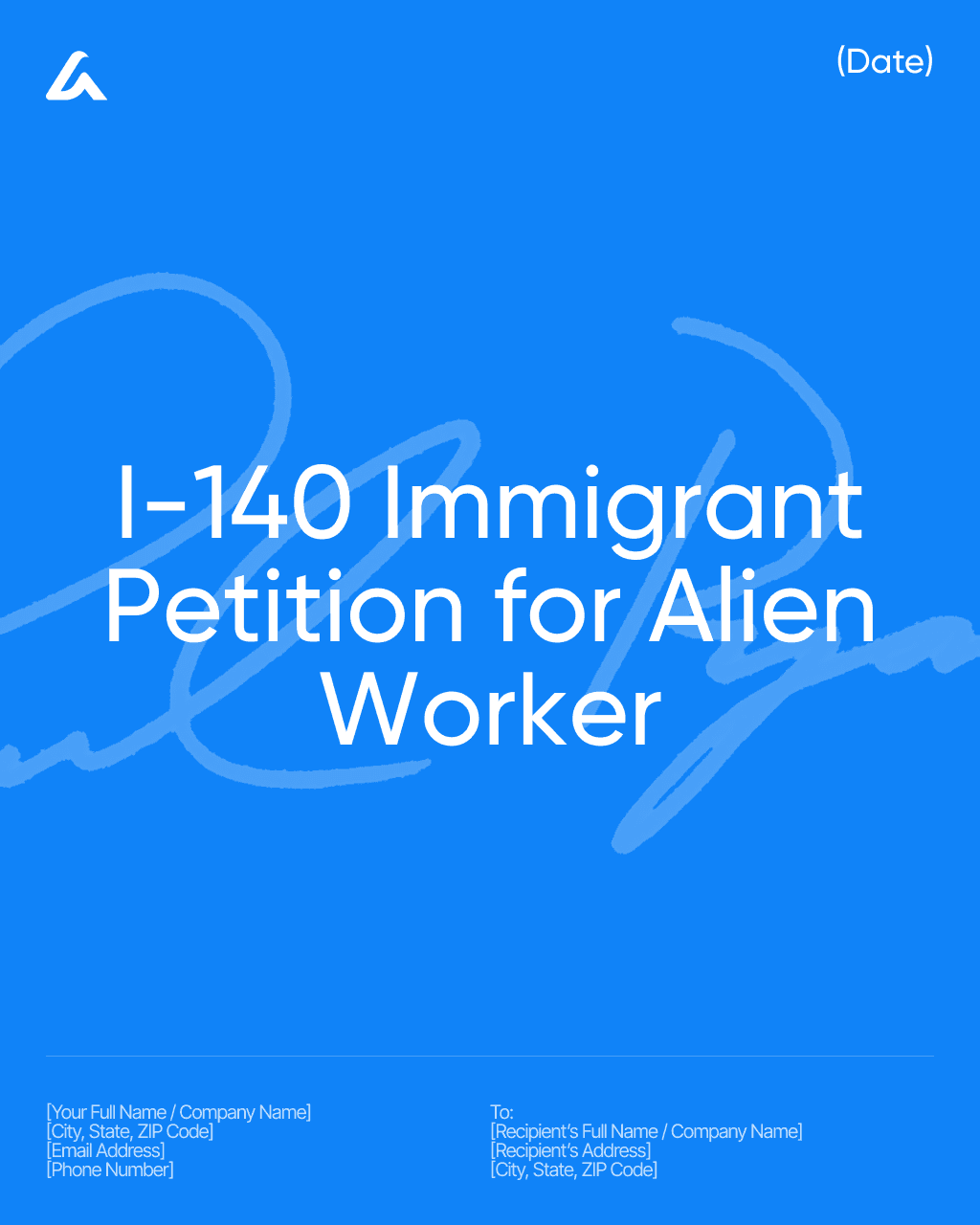
An I-140 Immigrant Petition for Alien Worker Template is a structured document used to prepare and present the information required when an employer — or, in some EB categories, the applicant themselves — files Form I-140 with USCIS. This petition requests classification of a foreign worker under an employment-based immigrant visa category (EB-1, EB-2, or EB-3) based on extraordinary ability, advanced degree qualifications, professional skills, or a permanent job offer. Its purpose is to demonstrate that both the employer (if applicable) and the foreign worker meet the statutory and regulatory requirements for the immigrant classification being requested.
Using a standardized I-140 Petition template ensures that all essential components of the filing are fully documented—such as employer details, job position and duties, wage information, labor certification status (PERM), and evidence of the beneficiary’s qualifications. For categories like EB-1A or EB-2 NIW, the template may include structured sections for presenting evidence of extraordinary ability, national interest contributions, published work, awards, citations, professional memberships, or expert opinion letters. For employer-sponsored cases, it may also contain documentation of the employer’s ability to pay the proffered wage, such as tax returns, annual reports, or audited financial statements. AI-powered tools like AI Lawyer help employers and workers produce clear, well-organized, and USCIS-compliant petition packages that highlight eligibility, reduce errors, and strengthen the overall case presentation for faster and more efficient adjudication.
Download Template: I-140 Immigrant Petition for Alien Worker Template
For more information please refer to our article: U.S. Immigration Forms and Documents: Complete Guide
Or create your own document yourself with the help of AI.
📘 Overview: Which Employment Legal Template Should You Use?
Not sure whether you need an Employment Contract, an Offer Letter, or a Non-Compete Agreement? Each document within the Employment Legal Templates category serves a distinct purpose in defining rights, responsibilities, and expectations throughout the employment relationship. From onboarding and performance management to separation and post-employment obligations, these templates ensure clarity, compliance, and fairness for both employer and employee.
The table below summarizes the key differences among the most common employment-related documents — highlighting their main purpose, typical provisions, and legal enforceability. Use this guide to determine which template fits your situation, whether you’re hiring a new team member, managing workplace performance, or finalizing a separation. A structured, legally sound document keeps every employment stage transparent, consistent, and compliant with applicable labor laws.
Template | Use Case | Typical Components | Legal / Professional Notes |
|---|---|---|---|
Establishes full employment relationship and all terms of work. | Job title, duties, salary, benefits, termination, confidentiality, IP, dispute resolution. | Legally binding; defines core rights and obligations; required in many jurisdictions. | |
Offers candidate a position with outlined terms and expectations. | Job title, start date, pay/benefits summary, at-will disclaimer, acceptance signature. | Must avoid implying a fixed-term contract unless intended; at-will clause critical in U.S. states. | |
Restricts employee from joining competitors after employment ends. | Duration, geographic scope, restricted activities, consideration. | Jurisdiction-sensitive; unenforceable in some states (e.g., California); must be reasonable to hold up in court. | |
Obtains consent to conduct background or credit checks. | Disclosure, candidate signature, types of data collected, FCRA notice. | Mandatory under FCRA (U.S.); must be a standalone, clear document; privacy laws apply. | |
Formally communicates an approved pay raise. | Effective date, new salary, reason for raise, HR/manager sign-off. | Documents pay changes; supports payroll accuracy, compliance, and audit trail. | |
Prohibits ex-employees from soliciting clients or coworkers. | Duration, scope, definition of solicitation, consideration. | Often enforceable where non-competes are not; must be narrowly tailored to business interests. | |
Defines duties, responsibilities, and qualifications for a role. | Job title, responsibilities, reporting lines, qualifications, ADA/EEO compliance. | Supports fair hiring and performance management; vital for compliance and classification. | |
Formally ends employment; records termination details. | Termination date, reason, final pay, benefits notice, property return instructions. | Key for documentation and defense in wrongful termination claims; supports unemployment filings. | |
Documents misconduct or performance issues requiring correction. | Incident date, description, policy violated, corrective plan, acknowledgment signature. | Creates legal record of fair discipline; vital for progressive discipline compliance. | |
Collects tax withholding information for payroll. | Employee details, filing status, allowances, signature, date. | Required for payroll compliance (e.g., IRS Form W-4 in the U.S.); must be kept current. | |
Confirms employment may be ended by either party at any time. | At-will statement, duties, compensation, termination clause. | Common in the U.S.; reinforces that employment is not a fixed-term contract. | |
Outlines company policies, culture, and workplace standards. | Code of conduct, benefits, attendance, safety, complaint procedures. | Requires acknowledgment; supports compliance and protects employer in disputes. | |
Provides structured guidance to correct underperformance. | Goals, timelines, metrics, supervisor feedback, consequences. | Demonstrates fair process; protects employer against wrongful termination claims. | |
Defines terms of an internship, paid or unpaid. | Role description, duration, supervision, compensation, confidentiality. | Ensures compliance with labor laws (e.g., U.S. “primary beneficiary test”). | |
Sets terms for independent contractor engagement. | Scope of work, deliverables, payment, IP ownership, confidentiality. | Confirms non-employment status; crucial for tax and labor law compliance. | |
Defines scope for creative design projects. | Project deliverables, revision policy, payment milestones, IP rights. | Clarifies ownership and licensing; protects both designer and client. | |
Confirms internship offer and key details. | Start/end dates, department, supervisor, compensation, program terms. | Differentiates internship from employment; supports compliance with labor regulations. | |
Announces promotion and outlines new role details. | New title, effective date, new salary, department, acknowledgment. | Formal documentation of promotion; supports payroll and HR record accuracy. | |
Defines post-employment payments and legal release. | Severance amount, release of claims, confidentiality, return of property. | Must comply with OWBPA and local laws; protects employer from future disputes. | |
Confirms current or past employment for third parties. | Job title, employment dates, status, salary (optional). | Must comply with privacy laws; requires employee consent before disclosure. | |
Requires disputes to be resolved via arbitration. | Covered disputes, arbitration forum, procedure, cost allocation. | Must be fair and balanced; enforceable under the FAA; avoid waiving protected rights. | |
Protects company’s confidential and proprietary information. | Definition of confidential info, obligations, exclusions, duration. | Critical for IP protection; must comply with trade secret and privacy laws. | |
Grants stock options or equity to employees. | Award types, vesting schedule, eligibility, tax treatment. | Must comply with SEC, IRS (409A), and corporate governance rules. | |
Evaluates employee performance over a review period. | Ratings, goals, feedback, development plan, signatures. | Promotes fairness, documentation, and transparency in reviews. | |
Defines terms for working from home or offsite. | Schedule, data security, equipment use, communication protocols. | Ensures compliance with labor, tax, and safety laws for remote work. | |
Transfers IP created during employment to employer. | Description of inventions, assignment clause, disclosure duties. | Protects employer’s IP; required in R&D roles; must meet patent law standards. | |
Combines NDA and IP ownership clauses in one document. | Confidentiality terms, IP assignment, disclosure, cooperation clause. | Ensures full IP and data protection; standard for tech and creative industries. | |
Tracks required steps for engaging contractors. | Contracts, tax forms, insurance verification, system access, policy acknowledgment. | Prevents misclassification; ensures compliance and organized onboarding. | |
Collects applicant data for hiring evaluation. | Contact info, work history, education, references, disclosures. | Must comply with EEO, ADA, and privacy laws; avoid discriminatory questions. | |
Transfers ownership of works created before hire but used on the job. | Description of pre-existing works, rights assigned, acknowledgment. | Clarifies IP ownership; prevents future IP disputes or copyright conflicts. | |
Restricts post-employment competition. | Restricted period, scope, geography, consideration. | Subject to strict legal limits; may require compensation; banned in some regions. | |
Finalizes separation and prohibits disparaging remarks. | Final pay, benefits, mutual release, non-disparagement clause. | Must balance free speech and labor rights; ensures professional offboarding. | |
Defines expectations for long-term remote or hybrid work. | Work schedule, location, reporting, security, reimbursement. | Similar to Remote Work Agreement; ensures safety and compliance. | |
Records employee misconduct and corrective action. | Incident details, policy violated, warning level, acknowledgment. | Supports progressive discipline; protects employer in potential disputes. | |
Documents disciplinary steps formally. | Employee info, incident summary, corrective action, signatures. | Ensures uniform and legally defensible disciplinary records. | |
Reviews overall performance and goal achievement. | Ratings, comments, improvement goals, employee acknowledgment. | Provides record of performance; supports merit-based decisions. | |
Endorses former employee’s qualifications. | Employment dates, title, achievements, strengths, signature. | Must be factual, neutral, and compliant with company reference policies. | |
Requests repayment for work-related expenses. | Expense details, receipts, dates, total amount, manager approval. | Ensures proper documentation; supports tax compliance and audit readiness. | |
Requests vacation, medical, or personal leave. | Dates requested, type of leave, balance verification, approval. | Maintains attendance compliance; required for FMLA or local leave laws. | |
Notifies employee of temporary unpaid leave. | Effective date, duration, benefits status, recall process. | Must meet WARN or local notice laws; preserves employment relationship. | |
Expresses intent to promote an employee pending approval. | New role, salary adjustment, start date, conditions for finalization. | Communicates intent clearly; supports HR transparency and motivation. | |
Employee’s written notice of intent to leave. | Last working day, reason (optional), appreciation, signature. | Provides formal record for HR; supports smooth transition and payroll closure. | |
Documents details of a vehicle accident | Date/time, location, vehicles involved, damage, injuries, statements, photos | Used for insurance claims; accuracy is crucial; may be required by insurer or police | |
Records incidents involving a minor | Child’s info, injury description, witnesses, environment, treatment | Must comply with child-protection reporting standards; often required for schools and daycare | |
Assesses disability level for claims | Medical history, symptoms, functional limitations, doctor assessment | Supports disability claims; must align with insurer or government criteria | |
Physician verification of injury | Diagnosis, cause, severity, treatment plan, limitations | Required for claims, leave, workers’ comp; must be signed by licensed doctor | |
Documents workplace injury | Employee info, incident details, witnesses, injury type | Required for OSHA/workers’ comp compliance in U.S.; must be timely | |
Tracks expenses due to injury | Medical costs, travel, receipts, dates, purpose | Supports claim reimbursement; requires documented proof | |
Evaluates injury severity | Symptoms, range of motion, pain scale, risk | Used by medical staff; helps determine treatment level | |
Personal written statement of injury | Description, cause, date, impact on daily life | Often required in legal cases; must be truthful and consistent | |
Initial intake for treatment or claims | Demographics, injury details, medical history | Used by clinics/lawyers; supports early case evaluation | |
General injury incident documentation | Date, time, location, injury description | Can be required legally depending on workplace/setting | |
Witness account of injury incident | Witness info, detailed narrative, signature | Supports claim credibility; must avoid speculation | |
Initiates insurance compensation request | Policy info, incident description, damages, signatures | Required by insurers; incomplete forms delay claims | |
Documents lost wages due to injury | Employer confirmation, dates missed, wage rate | Essential for personal injury settlements and insurance | |
Consolidated list of medical costs | Provider names, dates, services, amounts | Used in settlement negotiations; accuracy required | |
Official medical report of injury | Diagnosis, cause, prognosis, treatment plan | Supports legal and insurance cases; doctor documentation | |
Requests access to medical records | Patient info, authorization, provider details | Must comply with HIPAA (U.S.) and privacy laws | |
Injury-focused report for auto accidents | Injury type, cause of impact, symptoms | Supports auto injury claims; insurer requirement | |
Describes physical/emotional damages | Daily impact, severity, lifestyle changes | Critical for non-economic damages; must be specific | |
Starts personal injury claim process | Parties involved, incident, damages, medical support | Used by insurers or law firms to initiate evaluation | |
Formal request for compensation | Facts, liability, damages, settlement amount | Must be accurate; often starts negotiation with insurer | |
Collects detailed injury info | Medical history, symptoms, employment impact | Used by attorneys to evaluate cases | |
Contract with attorney | Scope, fees, responsibilities, terms | Legally binding; usually contingency-fee based | |
Breakdown of settlement funds | Total settlement, fees, medical liens, payout | Required for transparent accounting in legal cases | |
Tracks medication-related costs | Medication name, dose, date, cost | Helps prove ongoing medical treatment expenses | |
Documents injury caused by product | Product details, defect description, injuries | Important for product liability claims; evidence necessary | |
Validates injury existence | Medical verification, injury description | Needed for insurance or benefits approval | |
Plan for recovery and therapy | Goals, treatment schedule, exercises | Used by therapists; supports disability claims | |
Tracks progress over rehab period | Dates, exercises, pain levels, improvements | Supports insurance verification and treatment consistency | |
Finalizes injury claim settlement | Terms, payment, liability release | Legally binding; waives future claims | |
Records injuries during sports activities | Athlete info, event details, injury mechanism | Used by schools, leagues; liability and insurance relevance | |
Injury involving non-employee/non-client | Third-party info, incident details, witnesses | Used in businesses for liability and insurance documentation | |
Records workplace incident | Employee info, job role, accident details | Required for workers’ compensation; compliance-critical | |
OSHA Form 300 – Log of Work-Related Injuries and Illnesses Template | Track recordable workplace injuries and illnesses throughout the year. | Case number, employee info (non-sensitive), incident description, classification, days away/restricted. | Required for many U.S. employers; must be updated continuously and retained 5 years; privacy case rules apply. |
OSHA Form 300A – Summary of Work-Related Injuries and Illnesses Template | Provide annual summary totals of OSHA 300 log cases for employee visibility. | Total cases, injury types, days away/restricted, hours worked, establishment details, certification. | Must be posted Feb 1–Apr 30; retained 5 years; required by OSHA for qualifying employers. |
Document detailed incident-specific information for each OSHA-recordable case. | Employee details, event narrative, injury type, affected body part, medical treatment, contributing factors. | Must be completed within 7 days; required for each Form 300 entry; subject to OSHA privacy protections. | |
Establish internal rules for OSHA recordkeeping compliance. | Definitions, roles, incident classification steps, form completion procedures, retention rules, reporting timelines. | Must align with OSHA standards; failure to comply may result in citations; supports audit readiness. | |
Cal/OSHA Form 300 – Log of Work-Related Injuries and Illnesses Template | Track injuries/illnesses for California workplaces under state regulations. | Employee info, incident data, classification, days away/restricted, California-specific reporting fields. | Follows Cal/OSHA rules; stricter definitions; required for many employers; 5-year retention. |
Cal/OSHA Form 300A – Summary of Work-Related Injuries and Illnesses Template | Provide annual totals from the Cal/OSHA Form 300. | Case totals, injury categories, days lost, hours worked, establishment info, certifying signature. | Must be posted Feb 1–Apr 30; California-specific requirements apply; retained for 5 years. |
Cal/OSHA Form 301 – Injury and Illness Incident Report Template | Capture detailed incident information for each Cal/OSHA-recordable case. | Narrative description, affected body part, medical treatment, location, event factors, privacy protections. | Must be completed within 7 days; required for each 300 entry; complies with CA-specific rules. |
MIOSHA Form 300 – Log of Work-Related Injuries and Illnesses Template | Track injuries/illnesses for Michigan employers under MIOSHA rules. | Employee info, incident details, case categories, days away or restricted duty. | Required by MIOSHA; similar to OSHA but with Michigan-specific standards; retains for 5 years. |
MIOSHA Form 300A – Summary of Work-Related Injuries and Illnesses Template | Summarize yearly workplace injury/illness totals for Michigan workplaces. | Case totals, injury types, days lost/restricted, hours worked, establishment info, certification. | Must be posted Feb 1–Apr 30; MIOSHA mandates strict accuracy and retention. |
MIOSHA Form 301 – Injury and Illness Incident Report Template | Document detailed case information for each MIOSHA-recordable incident. | Employee demographics, incident narrative, injury type, medical response, contributing factors. | Must be completed within 7 days; Michigan-specific privacy and retention rules apply. |
I-129 Petition for a Nonimmigrant Worker Cover Letter Template | Summarize nonimmigrant worker petition details for USCIS review. | Employer/beneficiary info, visa category, job duties, wage details, evidence list, eligibility explanation. | Not required but highly recommended; improves clarity; reduces RFE risk; must align with USCIS regulations. |
Organize evidence for employment-based immigrant classification (EB-1, EB-2, EB-3). | Employer info, job offer, PERM (if applicable), beneficiary qualifications, ability-to-pay evidence. | Legally significant petition; must meet statutory/regulatory EB requirements; strong documentation essential. |
2. Regional Requirements and Nuances
Employment templates must be tuned to local rules on hiring, termination, pay, privacy, and restrictive covenants. Below are the highest-impact differences across key U.S. states, with the same “mini-card” structure you liked.
2.1 West Coast: California and Washington
California — employee-first rules, no non-competes
Actual documents: Offer Letter, Employment Agreement, Confidentiality/IP Assignment, Separation Agreement & Release, Workplace Policies.
Requirements & nuances: California bans post-employment non-competes under Bus. & Prof. Code §16600 and, since 2024, expanded enforcement via SB 699 and AB 1076, including notice duties and anti-evasion rules. Confidentiality clauses in severance/settlement can’t gag employees about discrimination/harassment due to the Silenced No More Act (SB 331). Employee/HR data is in scope of the CPRA (exemptions expired Jan 1, 2023), so templates should include CPRA disclosures. Final pay is strict: immediate on discharge and within 72 hours (or last day with notice) on resignation under Labor Code §§201–203.
Common searches: “California non-compete ban,” “California final paycheck rules.”
Common mistakes: Slipping in non-compete or overbroad non-solicit language; using confidentiality terms that unlawfully restrict protected disclosures; missing CPRA HR notices; late final wages.
How AI Lawyer helps: Auto-strips non-competes, swaps in enforceable confidentiality/IP terms, adds CPRA HR notices, and injects California-specific final-pay language with timing prompts.
Washington — tight non-compete limits + pay transparency
Actual documents: Offer Letter, Employment Agreement (with WA-compliant restrictive covenants), Salary Posting Addendum, Handbook Acknowledgments.
Requirements & nuances: The WA Non-Compete Act (RCW 49.62) restricts non-competes to workers above an inflation-indexed earnings threshold, requires advance notice, and bars enforcement after layoffs absent “garden leave.” WA’s Equal Pay & Opportunities Act requires salary and benefits ranges in job postings (RCW 49.58.110).
Common searches: “Washington non-compete threshold,” “WA salary range posting law.”
Common mistakes: Using broad non-competes below the income floor; omitting ranges/benefits in postings; forgetting required disclosures for promotions/transfers.
How AI Lawyer helps: Generates WA-compliant non-compete alternatives (NDAs, non-solicits), enforces salary-range fields on job ads, and flags missing RCW disclosures.
2.2 Northeast: New York
Actual documents: Offer Letter, Employment Agreement (narrow covenants), Pay Transparency Addendum, AEDT Notice (NYC), Separation Agreement.
Requirements & nuances: Statewide pay-range disclosures are mandatory under Labor Law §194-b for employers with ≥4 employees. NYC’s AEDT law (Local Law 144) requires a bias audit and candidate notices for covered AI hiring tools. Non-competes remain permitted if reasonable; a 2023 blanket ban was vetoed, and reform continues to be debated—so use narrow scope, tailored duration, and clear legitimate interests.
Common searches: “NY pay transparency law,” “NYC AI hiring audit rules,” “Are non-competes legal in NY?”
Common mistakes: Missing pay ranges/job descriptions in postings; deploying AEDTs without audits/notices; drafting overbroad non-competes.
How AI Lawyer helps: Locks pay-range fields, adds AEDT candidate notices, and templates narrowly tailored NY non-competes with step-down/blue-pencil language.
2.3 Southern States: Texas and Florida
Texas — enforceable non-competes (with conditions), classic at-will
Actual documents: Offer Letter (with conspicuous at-will), Employment Agreement with ancillary consideration, Confidentiality/IP Assignment, Handbook/Policy Acknowledgments.
Requirements & nuances: Non-competes are enforceable if ancillary to an otherwise enforceable agreement and reasonable in scope under Tex. Bus. & Com. Code §15.50. Texas is strongly at-will (see TWC guidance on at-will), and final pay rules differ by separation type (TWC on final pay). Accrued PTO payout depends on written policy (TWC).
Common searches: “Texas non-compete enforceable,” “Texas final paycheck deadline,” “Texas PTO payout.”
Common mistakes: No real consideration for a non-compete (e.g., no confidential info/training); missing at-will disclaimer; relying on unwritten PTO practices.
How AI Lawyer helps: Inserts ancillary consideration, adds conspicuous at-will text, and mirrors your PTO policy into the termination clause to avoid implied obligations.
Florida — employer-friendly restrictive covenants
Actual documents: Offer Letter, Employment Agreement with restrictive covenants, Confidentiality/IP, Multilingual Termination Letter (best practice), Separation Agreement.
Requirements & nuances: Florida expressly enforces non-competes when tied to legitimate interests and reasonable in time/scope under §542.335, Fla. Stat.. Statutory presumptions apply (≤6 months generally reasonable; >2 years generally unreasonable for former employees). Final wages are typically due on the next regular payday (no special “immediate” rule in state law; see DOL overview on last paychecks).
Common searches: “Are non-competes enforceable in Florida?” “Florida final paycheck timeline.”
Common mistakes: Overbroad territory/customer scope; missing ‘legitimate business interest’ recital; assuming California-style bans apply.
How AI Lawyer helps: Generates narrowly tailored covenants with judicial-modification clauses, and standardizes final-pay language keyed to your payroll calendar.
2.4 Midwest: Illinois
Actual documents: Offer Letter, Employment Agreement (with income-threshold checks), AI Hiring Disclosures, Pay Transparency Addendum (2025+), Separation Agreement.
Requirements & nuances: Illinois restricts non-competes/non-solicits under the amended Freedom to Work Act (no non-competes < $75k salary; 14-day review period; adequate consideration). The AI Video Interview Act requires notice/consent and limits sharing for AI-assisted video screening. Statewide pay-range posting is required beginning Jan 1, 2025 (Public Act 103-0541 / HB 3129).
Common searches: “Illinois non-compete salary thresholds,” “Illinois AI interview law,” “Illinois salary range posting 2025.”
Common mistakes: Using non-competes for lower-paid roles; no 14-day review notice; forgetting 2025 pay-transparency requirements in job ads.
How AI Lawyer helps: Auto-checks income thresholds, drops in review/attorney-consult language, adds AI screening disclosures, and enables a 2025-ready job-posting block.
Summary
Across these states, three patterns matter most: (1) non-compete enforceability ranges from a total ban (CA) to tightly conditioned (WA, IL) to broadly permitted (TX, FL) — so swap in the right restrictive-covenant strategy per state; (2) transparency is rising fast (pay ranges in NY and IL; AI hiring disclosures in NYC and IL; WA job-posting details); and (3) privacy and payroll mechanics vary (CPRA covers CA HR data; final-pay timing differs by state). AI Lawyer bakes these rules into each template — removing or narrowing non-competes where required, forcing pay-range and notice fields when mandatory, inserting CPRA/AI disclosures, and aligning termination/pay clauses to local law — so your employment docs are clear, compliant, and ready to sign.
3. Legal and Workplace Trends (2024–2025) Affecting Employment Documents
Over the past two years, employers have faced a rapidly shifting legal landscape shaped by technological disruption, regulatory reform, and evolving labor norms. Employment documentation—traditionally treated as a static administrative function—now demands a dynamic, jurisdiction-aware approach.
From the rise of artificial intelligence in HR to sweeping changes in non-compete enforceability and remote work regulation, staying legally compliant requires proactive adaptation of employment documents. This section highlights three core trend areas that influence how employment templates must be drafted, updated, and used in 2024–2025.
3.1 📍 AI in Hiring and Termination – Disclosure & Compliance
Employers are increasingly using Artificial Intelligence in hiring, performance reviews, and even layoffs—but this shift brings new legal duties around bias, privacy, and transparency. New York City’s Local Law 144 (2023) requires bias audits and candidate notices for any automated hiring tools, while Illinois (2024) and federal EEOC guidance emphasize that AI cannot be used to discriminate or replace human judgment. In the EU, the GDPR already gives workers the right not to be subject solely to automated decisions, and the upcoming AI Act will classify workplace AI as a “high-risk” system requiring human oversight and record-keeping.
To stay compliant, update job applications, offer letters, and background check authorizations with short AI disclosure clauses (“Automated tools may assist in screening, reviewed by human evaluators”). Internal policies and termination procedures should confirm that human managers make the final decisions. Including these notices builds trust, ensures fairness, and prevents liability.
📜 Read full analysis →
✨ Create an AI-compliant employment agreement →
🚀 Generate your own document with AI →
3.2 📍 Remote Work Clauses and Cross-Border Employment Rules
Remote and hybrid work are now permanent features of modern employment, and legal frameworks are rapidly evolving to match. Updated Employment Contracts and Remote Work Agreements increasingly include clauses defining the employee’s primary work location, expected hours, and compliance with data security and expense reimbursement laws. For example, states like California and Illinois require employers to reimburse reasonable home office costs, while other jurisdictions mandate written acknowledgment of remote workspace safety and confidentiality. Contracts may also specify “core hours” across time zones and restrict relocation without company approval to avoid tax or labor law complications.
Cross-border remote work adds further complexity: an employee working from another country can trigger local labor, tax, or immigration obligations, even unintentionally. To mitigate risk, many employers now include choice-of-law and work authorization clauses, requiring employees to notify HR before working abroad. Some organizations even reserve the right to adjust compensation based on location or to employ remote workers via local Employer of Record (EOR) partners. In summary, employment templates for 2024–2025 should address work location, expenses, data security, and jurisdictional compliance—ensuring clarity and protection for both parties in a distributed workforce.
📜 Read full analysis →
✨ Create a compliant remote work agreement →
🚀 Generate your own document with AI →
3.3 📍 Worker Rights, Gig Classification & Non-Compete Reform
Recent labor reforms are reshaping how employers draft and enforce employment agreements. Governments are tightening definitions of independent contractors vs. employees, expanding minimum wage and leave protections, and revising what’s permissible in non-compete and severance clauses. In the U.S., the NLRB’s 2023 McLaren Macomb decision limits overly broad non-disparagement and confidentiality terms that restrict workers from discussing pay or conditions. Meanwhile, the FTC’s proposed nationwide ban on non-competes—though paused amid legal challenges—has prompted many employers to remove or narrow such clauses, using non-solicitation and confidentiality provisions instead. Several states, including Colorado, Illinois, and Washington, now prohibit or restrict non-competes for lower-income workers, signaling a long-term shift toward employee mobility and fairer contract terms.
The gig economy and cross-border work models are also under scrutiny. Rules like California’s AB5 and the U.S. Department of Labor’s 2024 classification guidance make it harder to misclassify full-time workers as contractors, requiring clear written acknowledgments of independence and control in freelance agreements. At the same time, global trends—from the “right to disconnect” in Europe to stronger union protections in the U.S.—are redefining worker rights and corporate obligations. For employers, this means regularly auditing all employment documents—contracts, handbooks, severance agreements—to ensure they reflect evolving standards of fairness, transparency, and compliance.
📜 Read full analysis →
✨ Create a modern non-compete agreement →
🚀 Generate your own document with AI →
3.4 📍 Data Privacy & Employee Monitoring Policies
As remote work and digital tools expand, data privacy in employment has become a critical compliance area. Employers increasingly collect personal and performance data through apps, collaboration platforms, and even monitoring software. Under laws like the EU’s GDPR, UK Data Protection Act, and emerging U.S. state privacy acts (e.g., California’s CPRA, Texas TDPSA), companies must disclose what employee data they collect, how it’s used, and for how long it’s stored. In some jurisdictions, employees must give explicit consent before monitoring can occur—particularly for activity tracking, location data, or keystroke logging.
To comply, modern Employee Handbooks and Remote Work Agreements should include clear privacy and monitoring disclosures, referencing company IT and cybersecurity policies. Best practice is transparency: explain the purpose (“to ensure system security or measure productivity”), limit the scope, and outline data protection measures. Overly intrusive or undisclosed surveillance can lead to legal and reputational harm.
📜 Read full analysis →
✨ Create a privacy-aware employee handbook →
🚀 Generate your own document with AI →
3.5 📍 Pay Transparency & Salary Equity Regulations
Pay transparency laws are reshaping how employers communicate compensation. States like California, New York, and Washington now require salary ranges in job postings, while the EU Pay Transparency Directive (2026) will mandate similar disclosures for European employers. The goal is to promote gender pay equity and fairness by giving candidates and employees visibility into compensation structures. Employers that fail to disclose pay ranges risk fines or discrimination claims, especially if disparities emerge without objective justification.
Employment templates—including Offer Letters, Job Descriptions, and Promotion Letters—should therefore include pay bands, performance-based bonus criteria, and equal pay disclaimers. Periodic pay audits and internal communication around compensation criteria can further reduce risk. Transparent documentation not only ensures compliance but also strengthens trust and retention.
📜 Read full analysis →
✨ Create a salary-transparent job description →
🚀 Generate your own document with AI →
3.6 📍 Workplace Conduct, Harassment Prevention & Psychological Safety
Modern labor regulations are expanding beyond physical safety to include psychological safety and respectful workplace behavior. Following the #MeToo and post-pandemic mental health movements, many jurisdictions now require formal anti-harassment, discrimination, and conduct policies to be issued to all employees. For instance, Illinois, New York, and California mandate annual harassment prevention training and written acknowledgment forms, while the EU Framework Directive on Health and Safety at Work includes psychosocial risk prevention.
Employers should ensure Employee Handbooks, Code of Conducts, and Onboarding Checklists include clear behavioral expectations, reporting procedures, and anti-retaliation clauses. Contracts may also refer to adherence to these policies as a condition of employment. Culturally, emphasizing empathy and open communication in policy language reinforces inclusion and reduces legal exposure—making compliance part of positive workplace culture, not just regulation.
📜 Read full analysis →
✨ Create a workplace-conduct compliant employee handbook →
🚀 Generate your own document with AI →
4. Conclusion: Why Use AI Lawyer Templates for Employment Documents
In today’s rapidly changing workplace, where employment law evolves almost as fast as business models, having accurate, compliant, and adaptable documentation is essential. AI Lawyer’s Employment Templates offer a practical, legally sound solution—combining professional precision with real-world flexibility. From job offers and confidentiality agreements to termination letters and handbooks, these templates ensure every document reflects current laws, fair practices, and your company’s values.
AI-driven templates automatically adapt to jurisdictional nuances, integrating the right clauses for each location—whether that means California’s non-compete restrictions or Illinois’ expense reimbursement requirements. This eliminates guesswork and keeps your business consistently compliant without constant manual revisions or costly legal reviews. Beyond compliance, standardized templates bring much-needed consistency across teams: every offer, warning, or review follows the same structure, reinforcing transparency and professionalism.
For startups and growing companies, AI Lawyer levels the playing field—delivering the power of a full legal department through intuitive, lawyer-reviewed forms. Each template guides you step-by-step, highlighting key terms like employment status, compensation structure, confidentiality, and termination rights, ensuring nothing critical is overlooked.
Ultimately, using AI Lawyer’s Employment Templates isn’t just about efficiency—it’s about confidence. You safeguard your organization, respect your employees, and maintain clear, fair documentation in every situation. In an era where compliance, clarity, and speed all matter, AI-powered employment templates are your foundation for smarter, safer, and more human-centered HR operations.
How it works
How to Get a Ready-Made Document in Minutes?
Choose a Category
Browse available categories or use search to quickly find the document you need.
Edit with AI
Use the built-in AI chat to quickly customize and adapt the template to your needs.
Download the Document
Download your ready-made document in a convenient format
Use It Hassle-Free
Your document is fully prepared—send, sign, or use it as needed.
Most popular

























































































